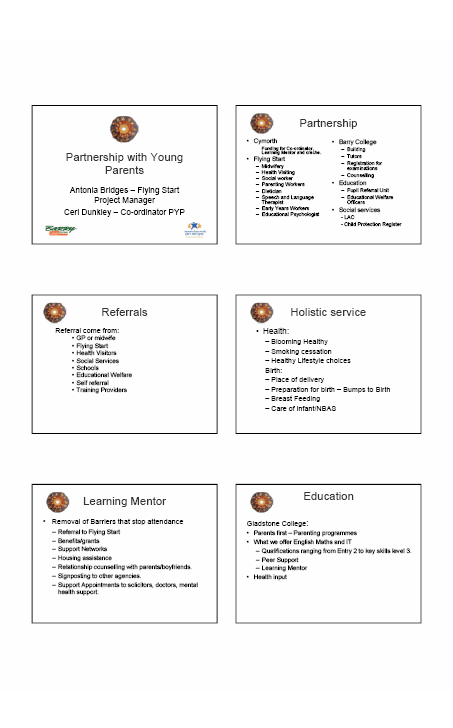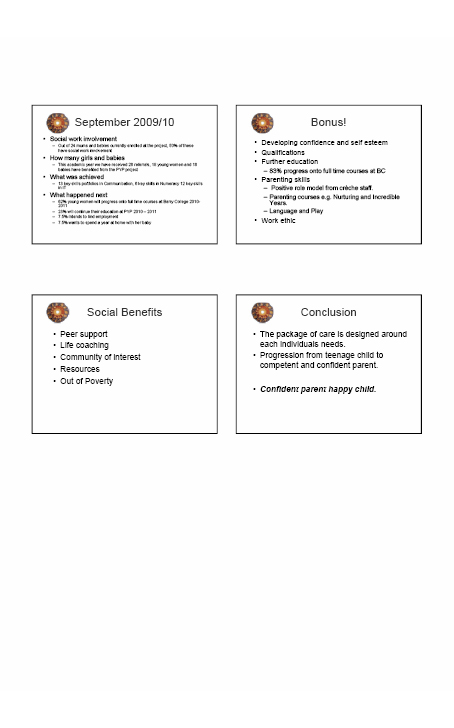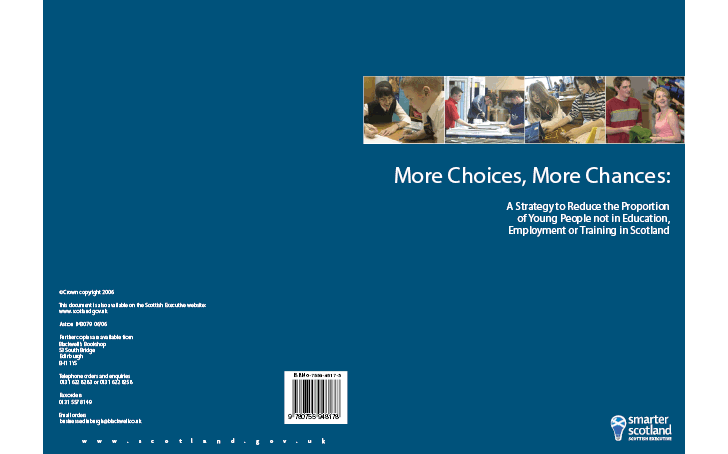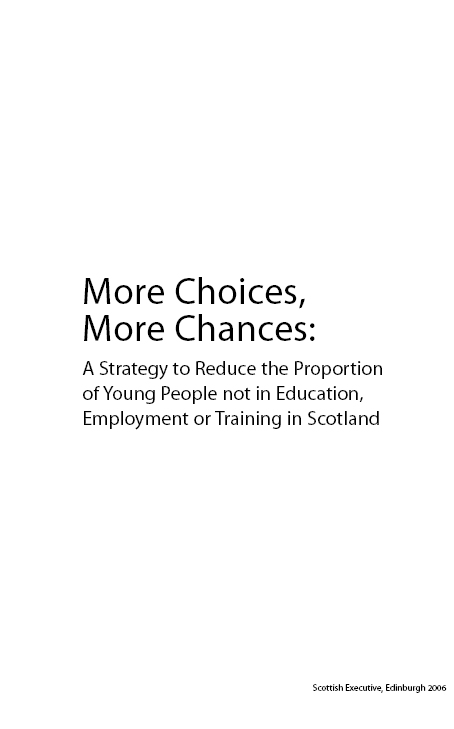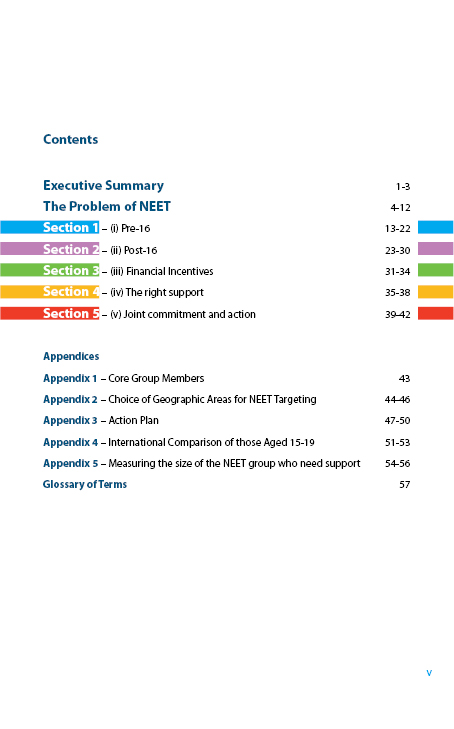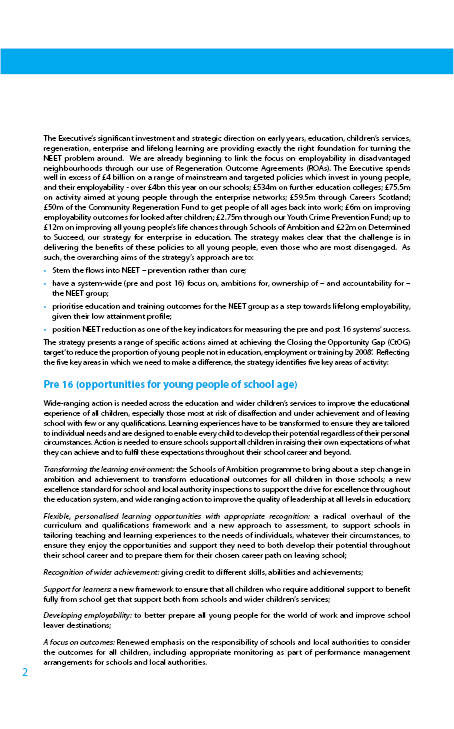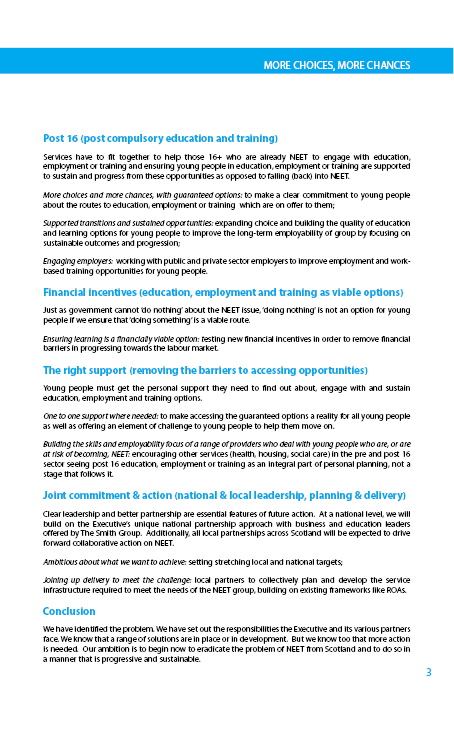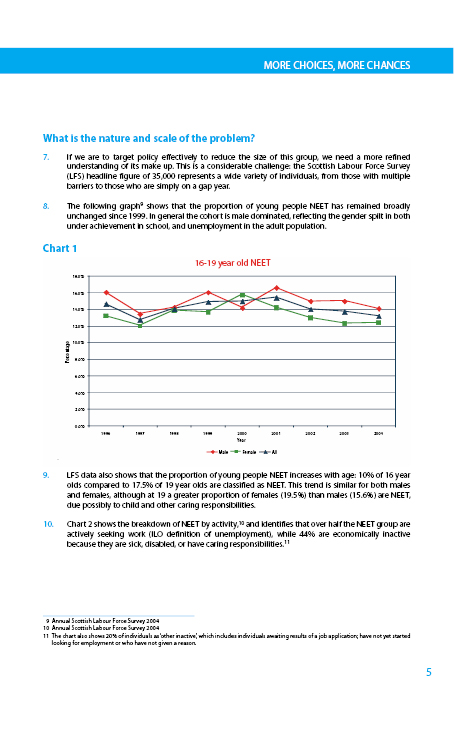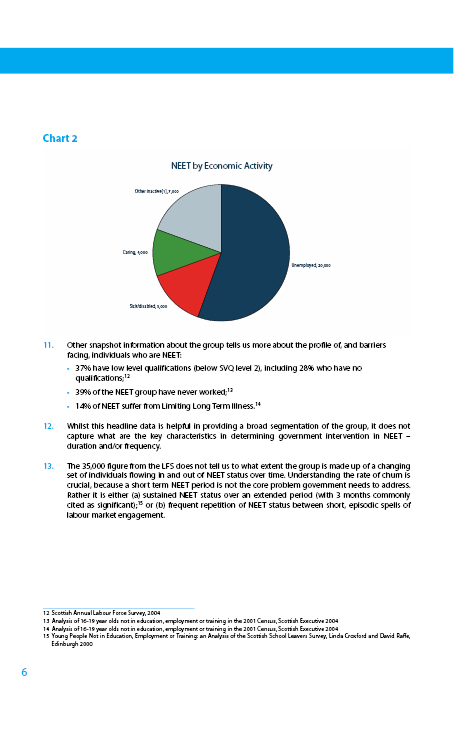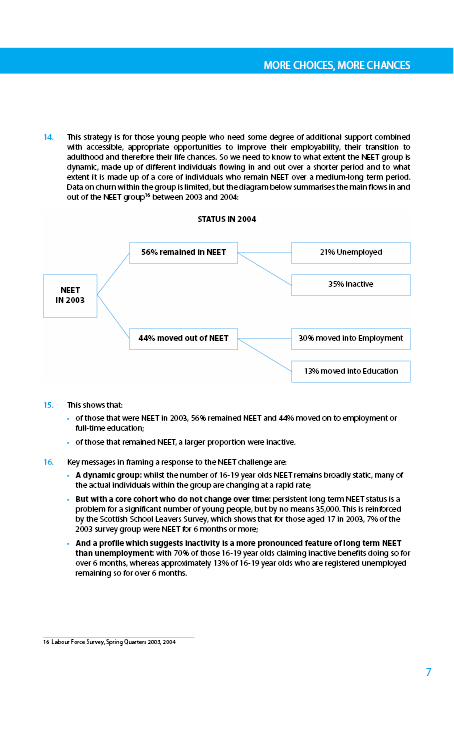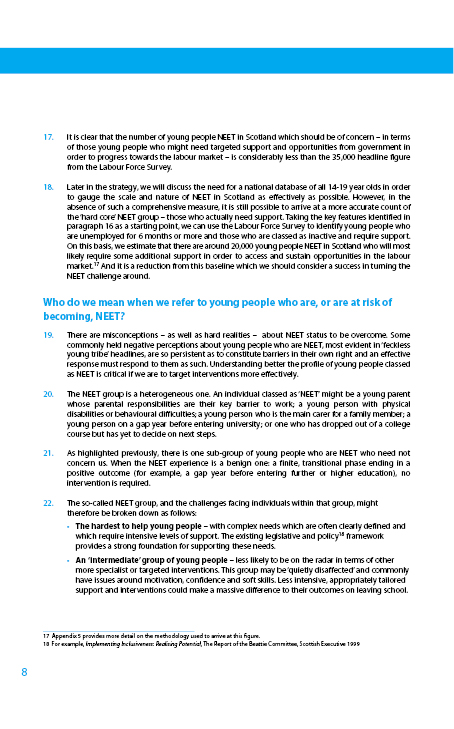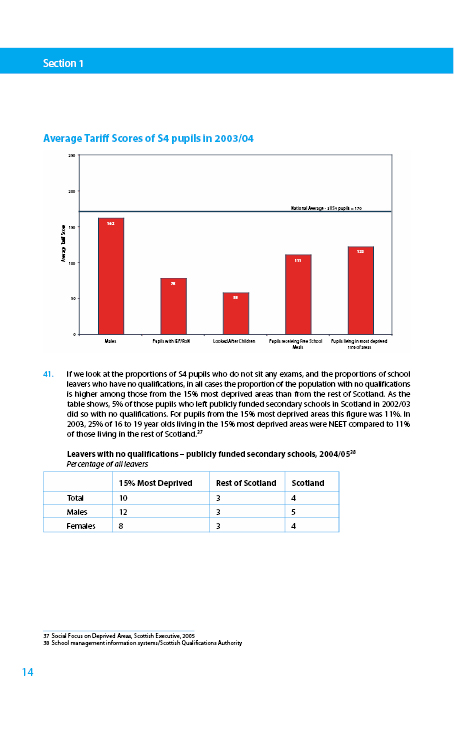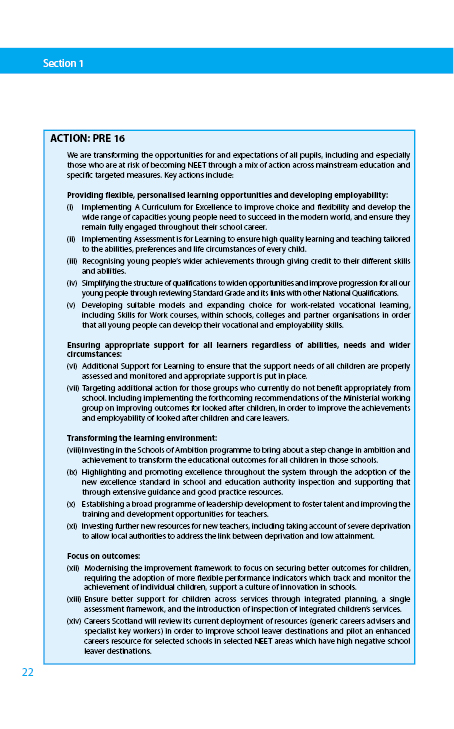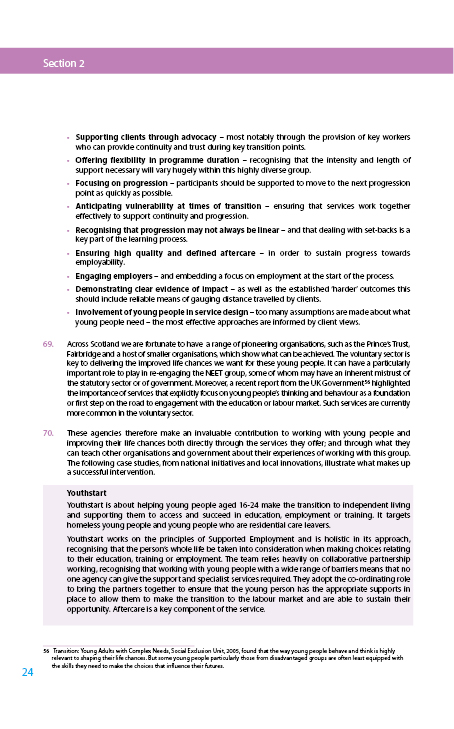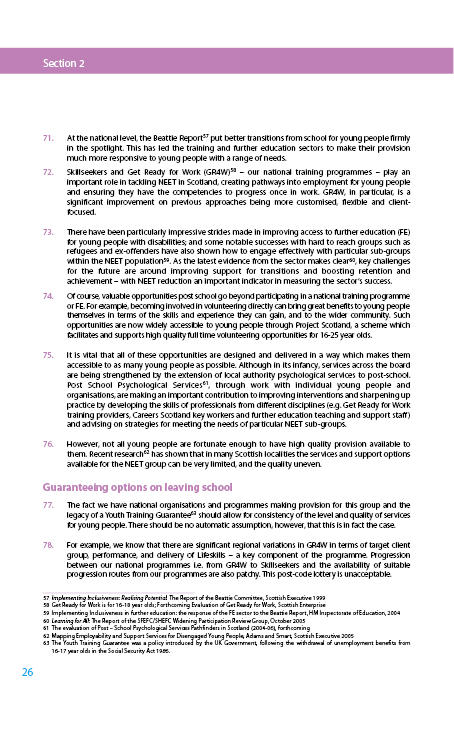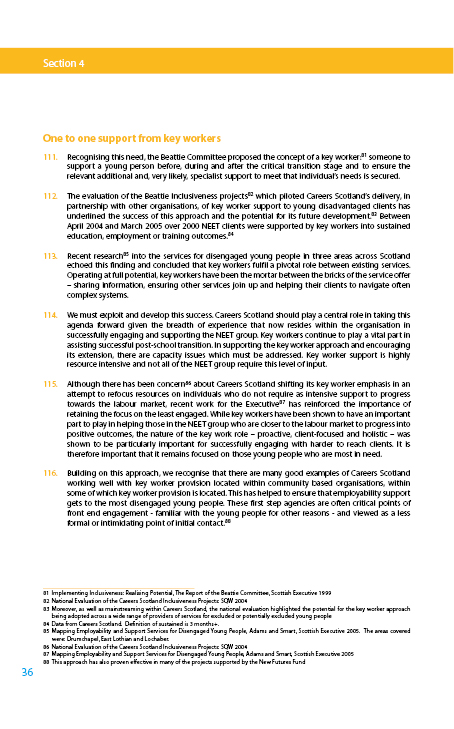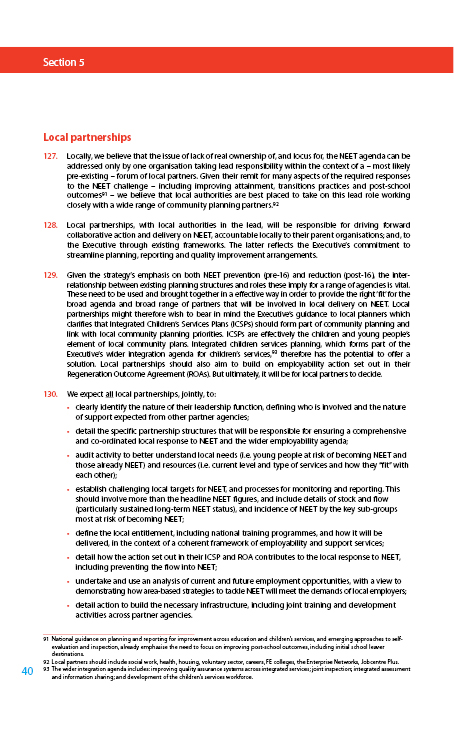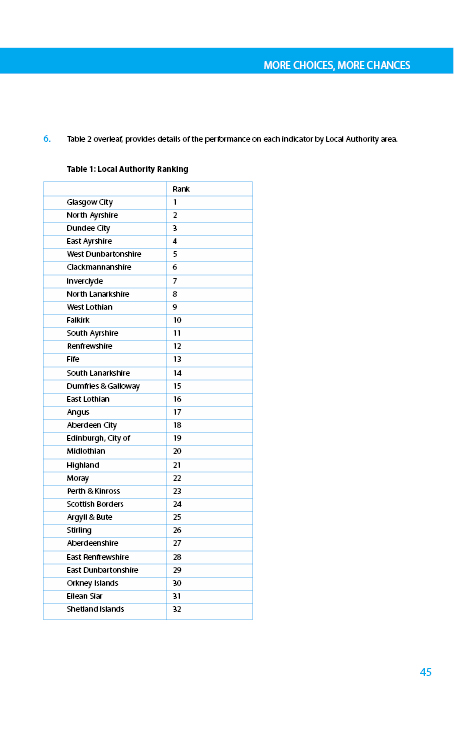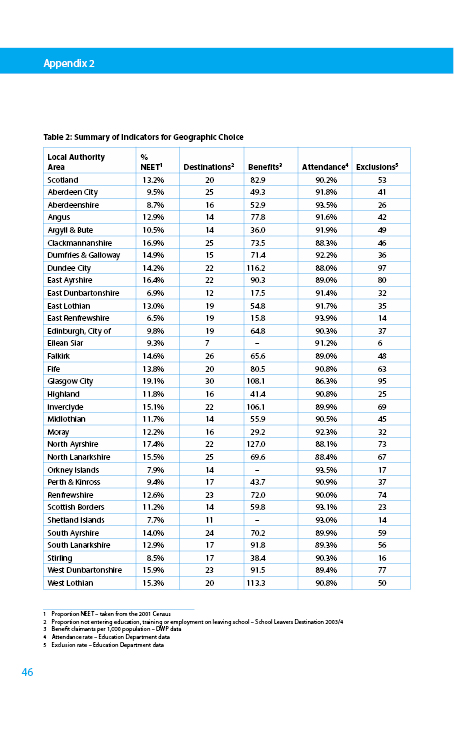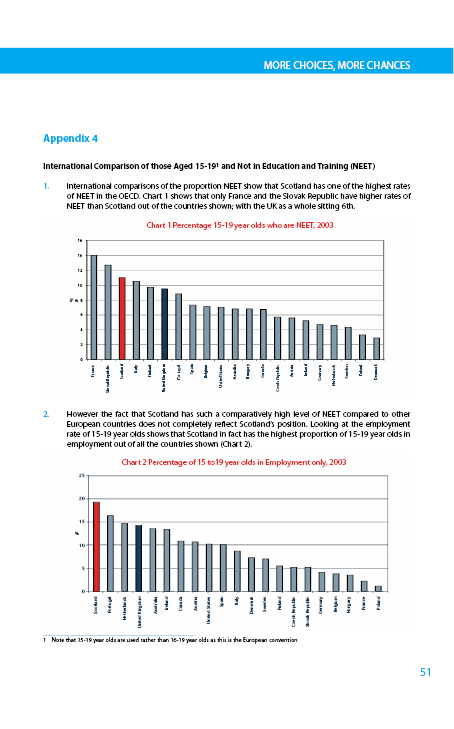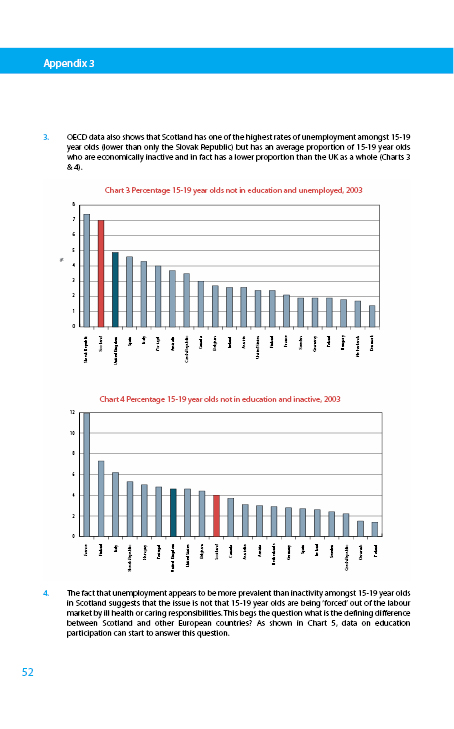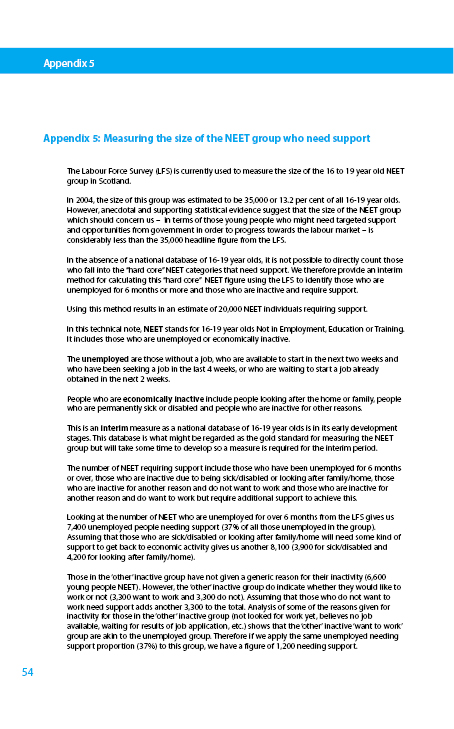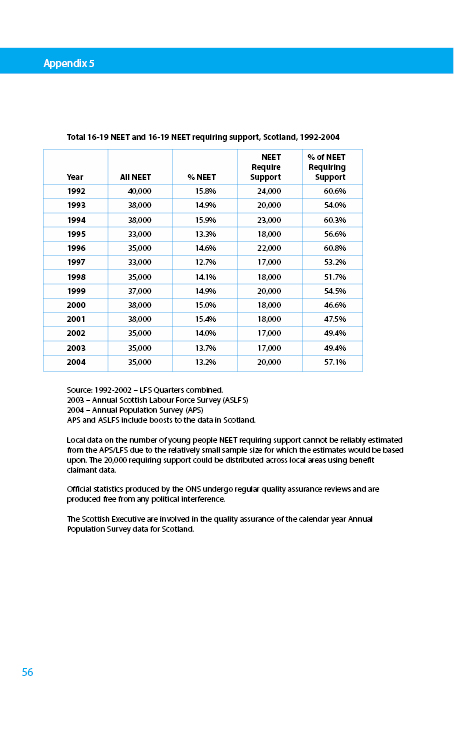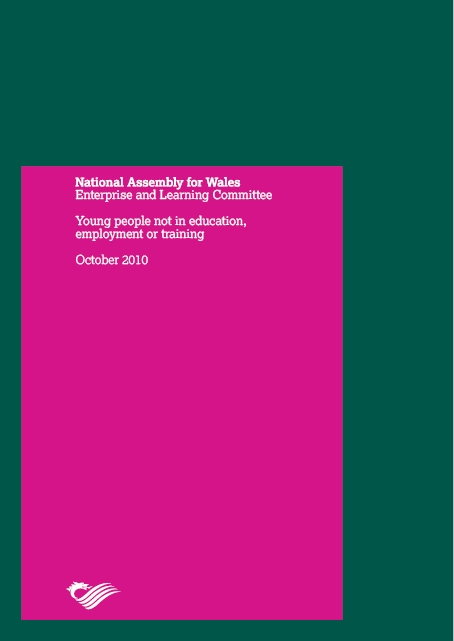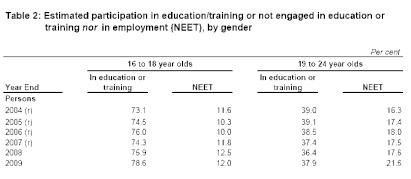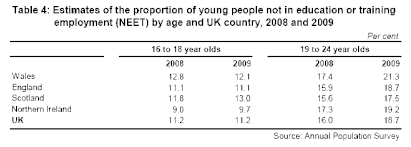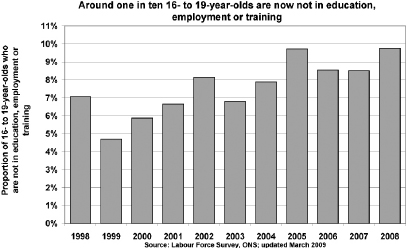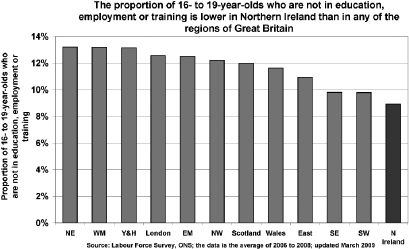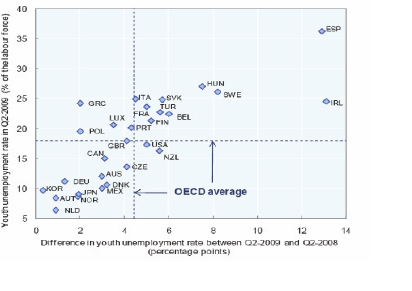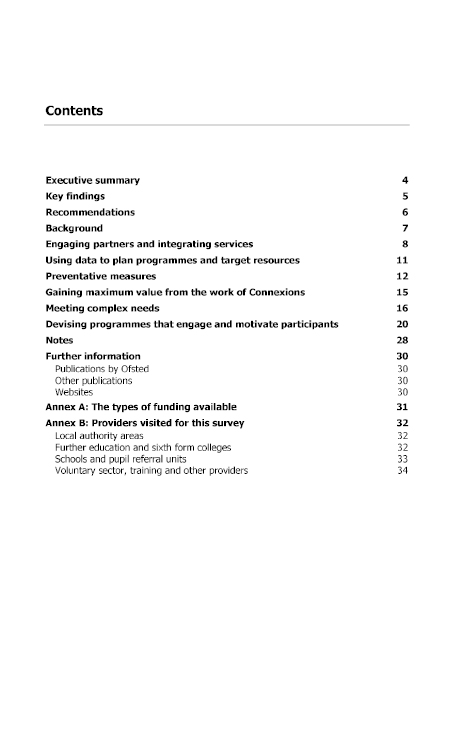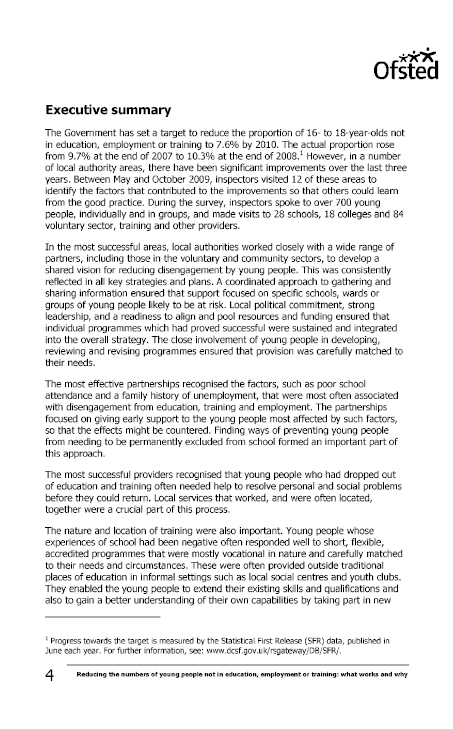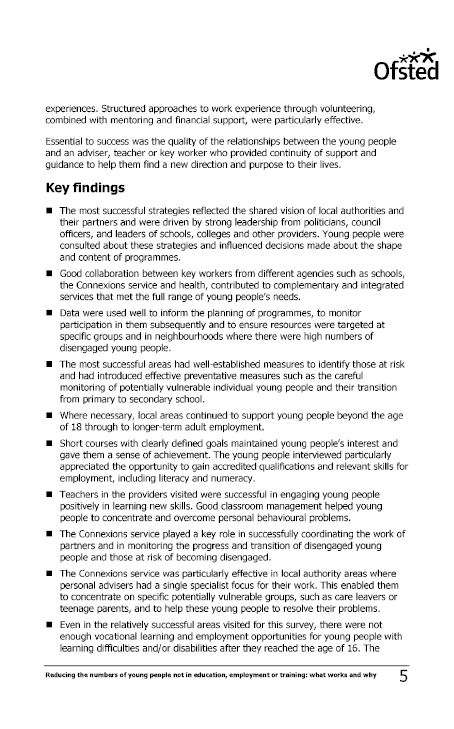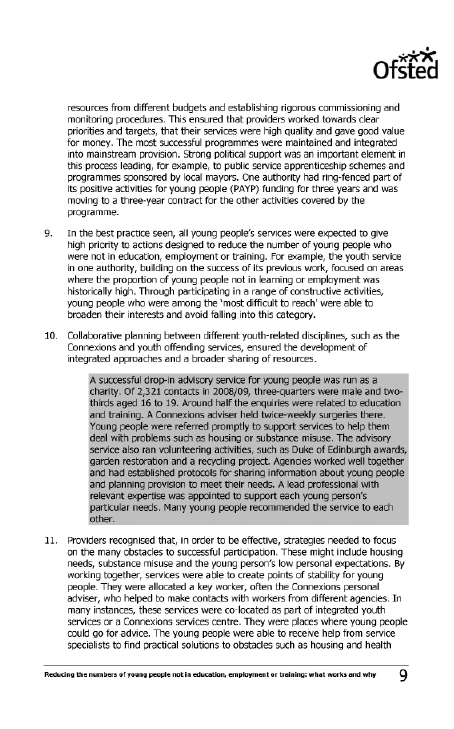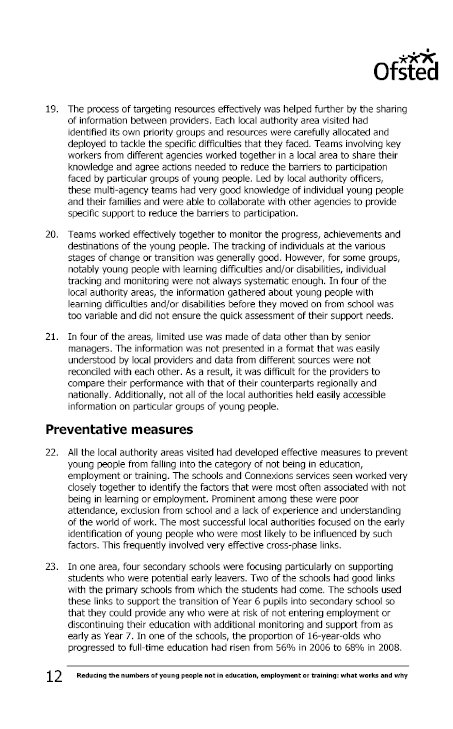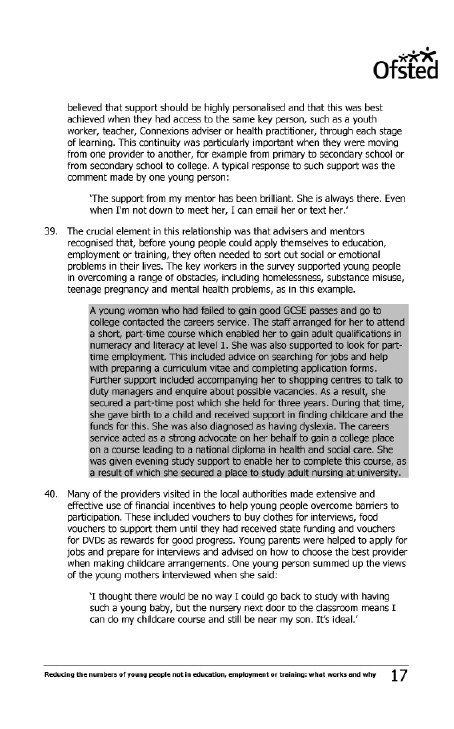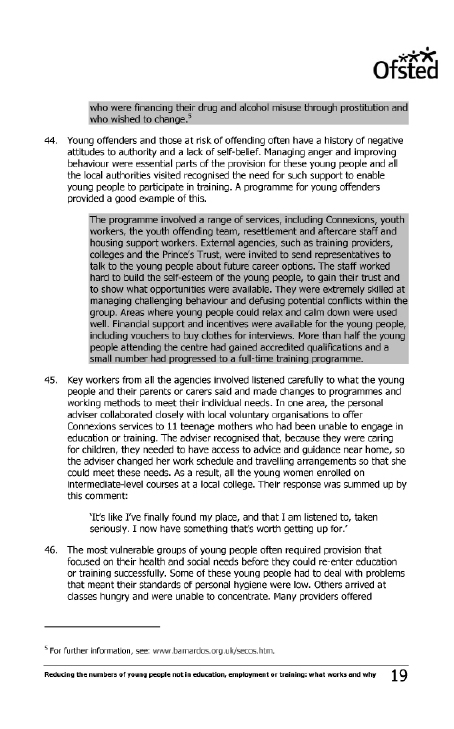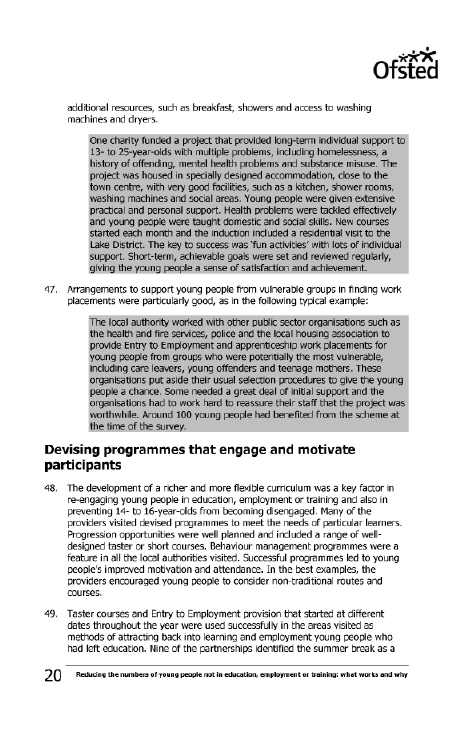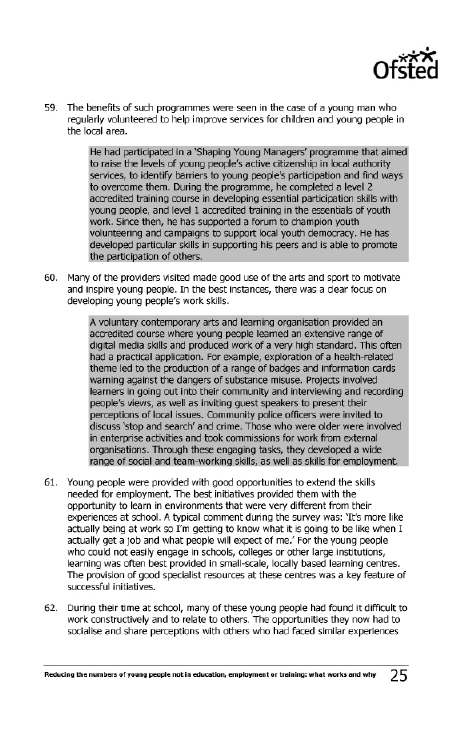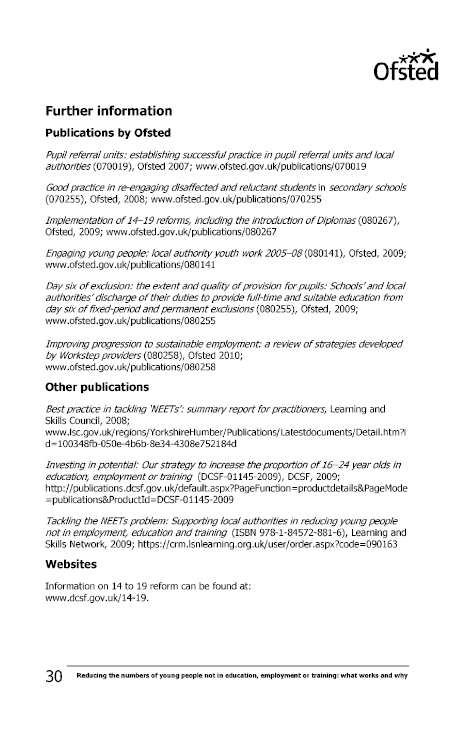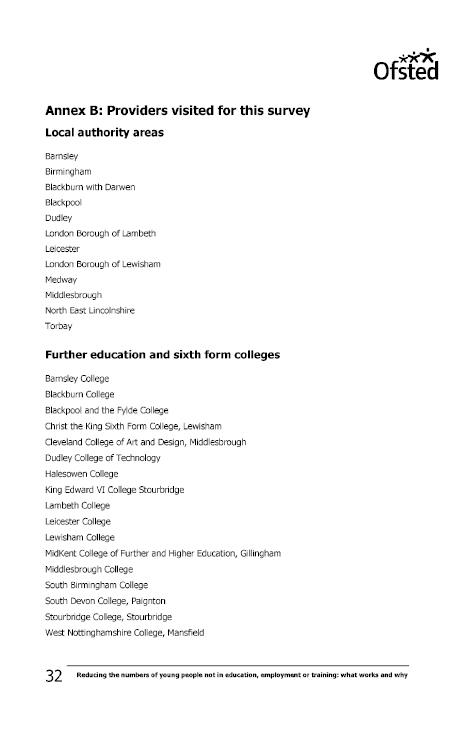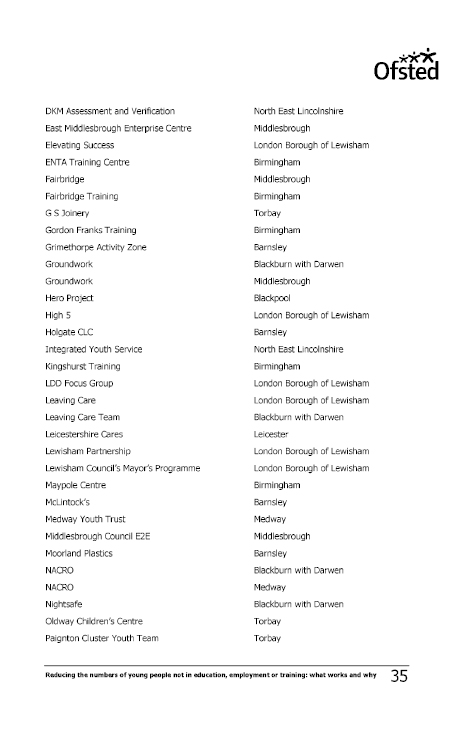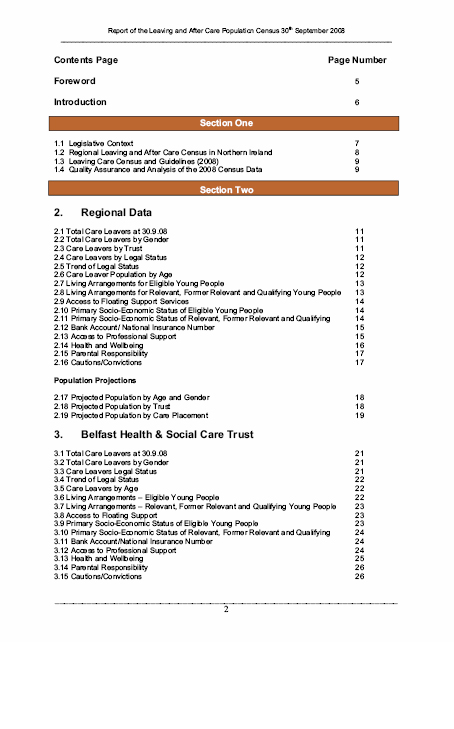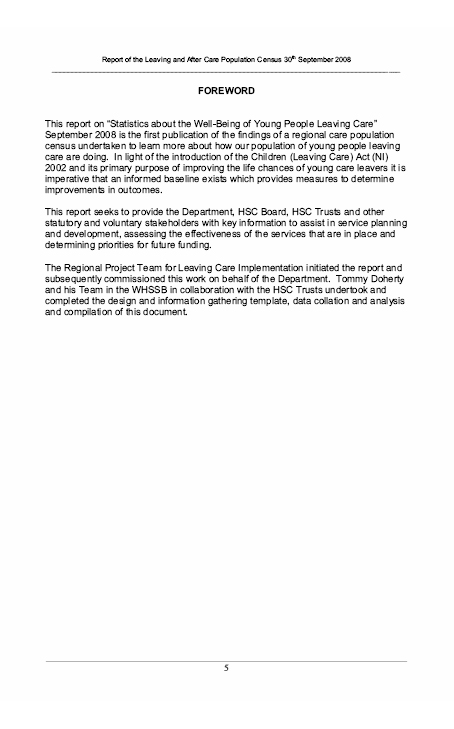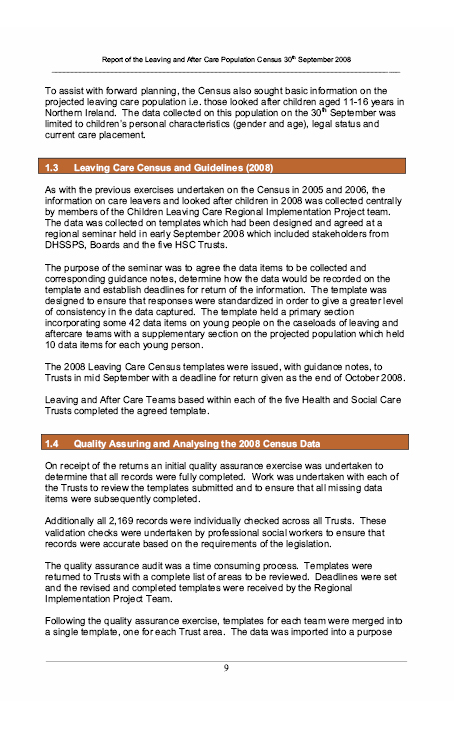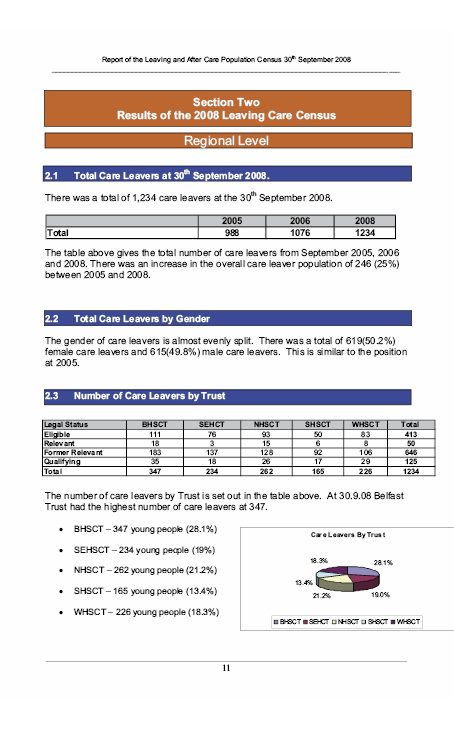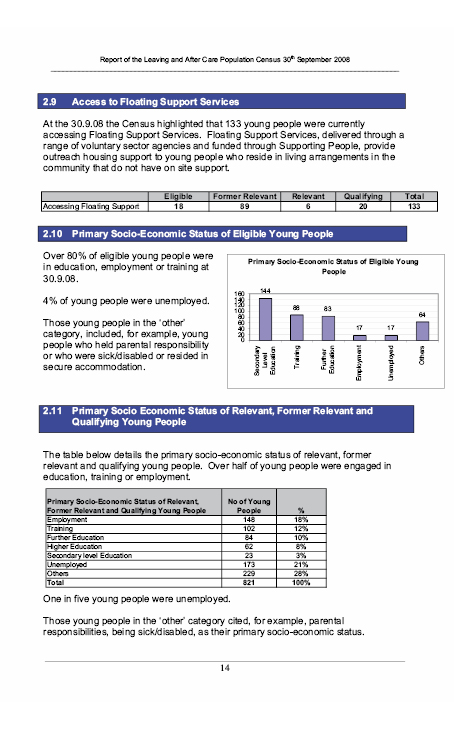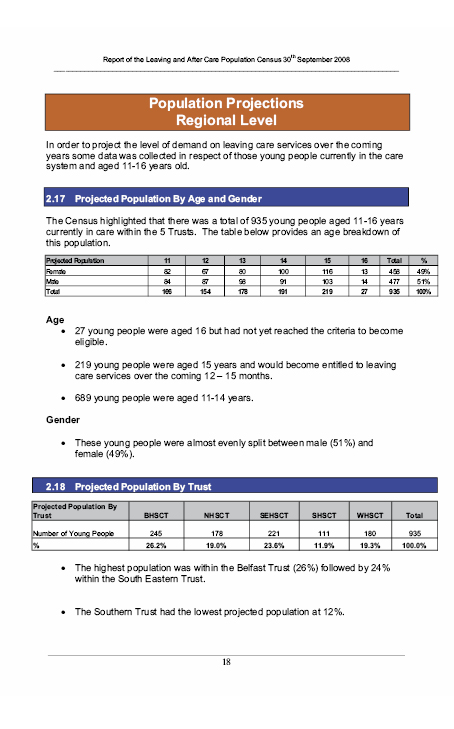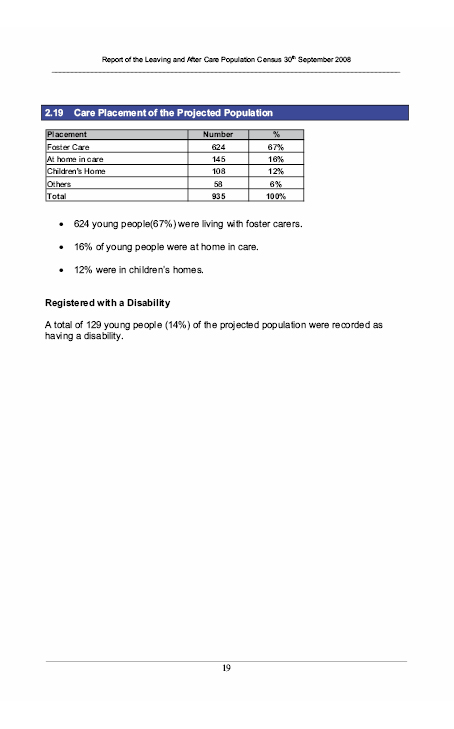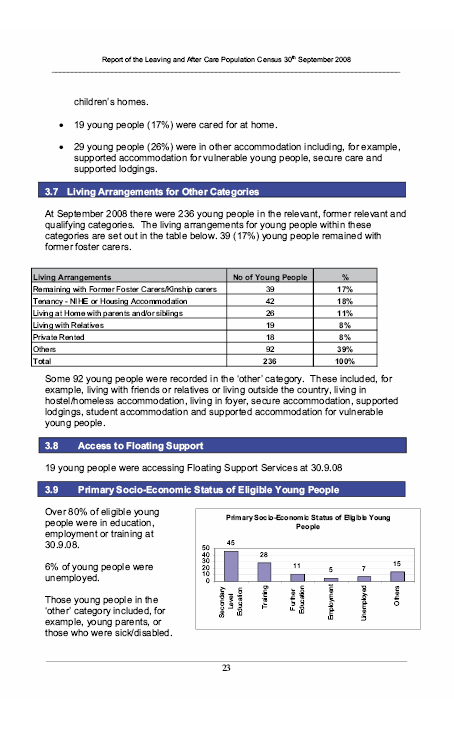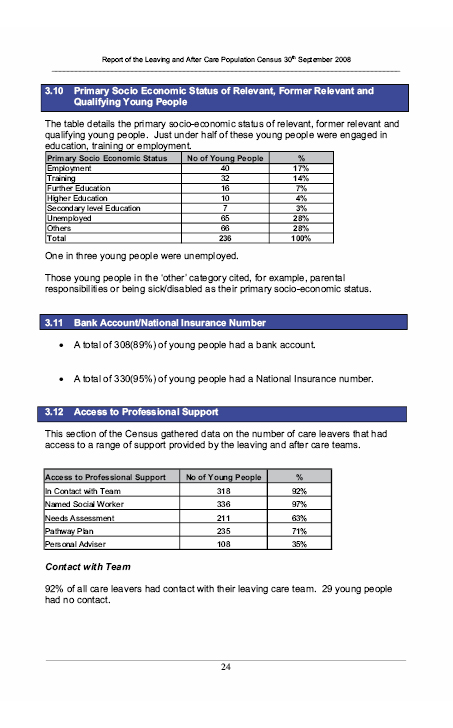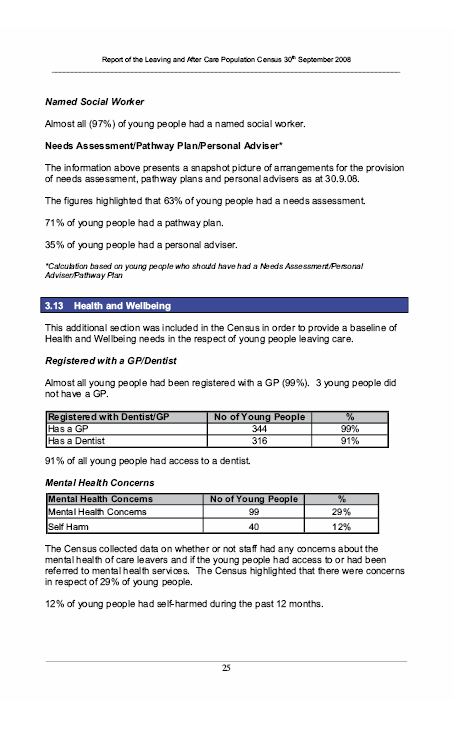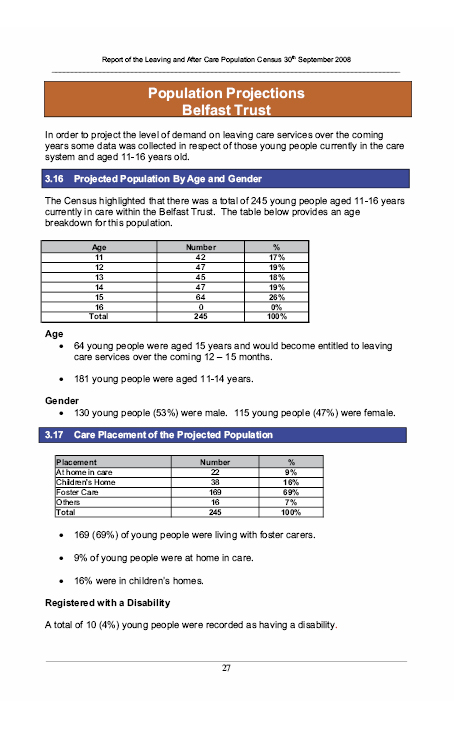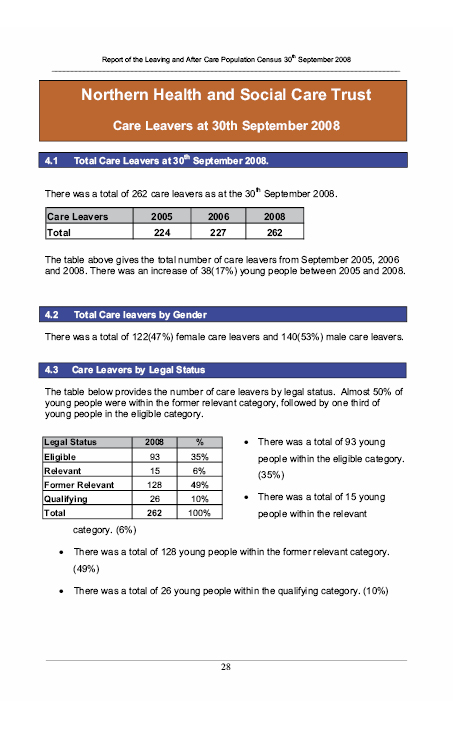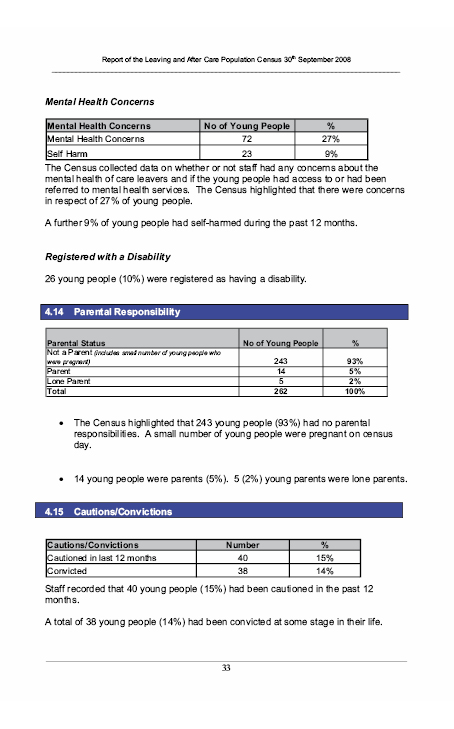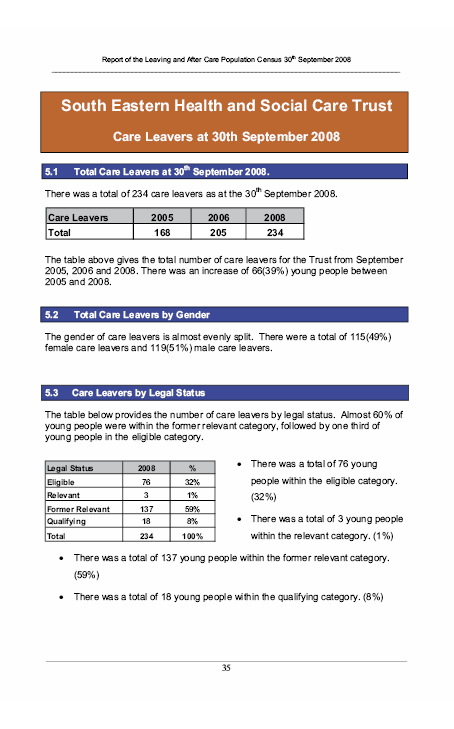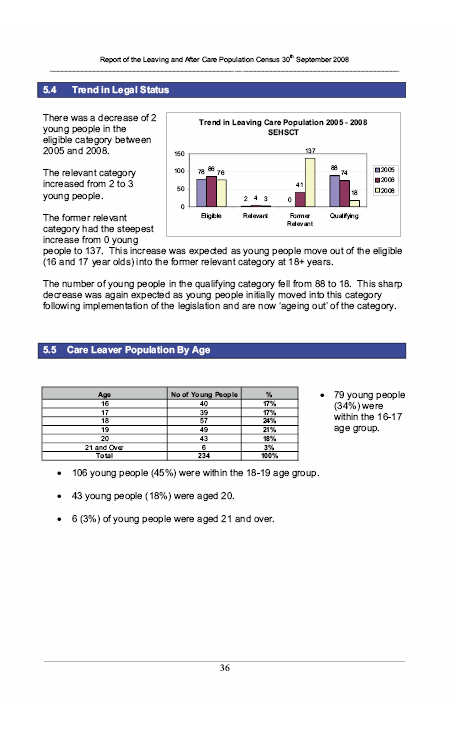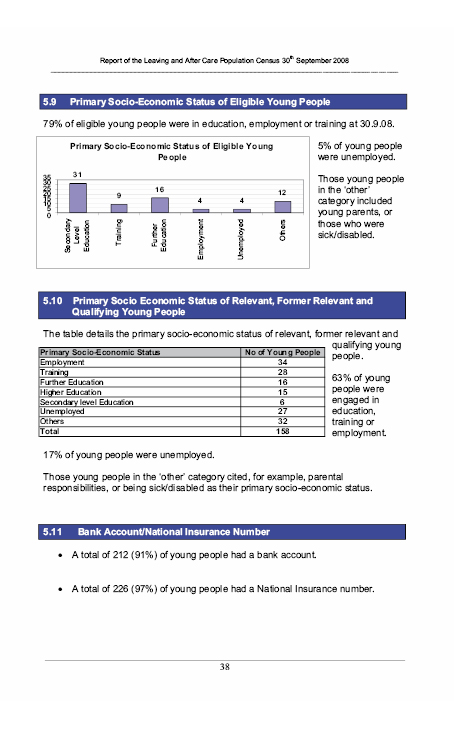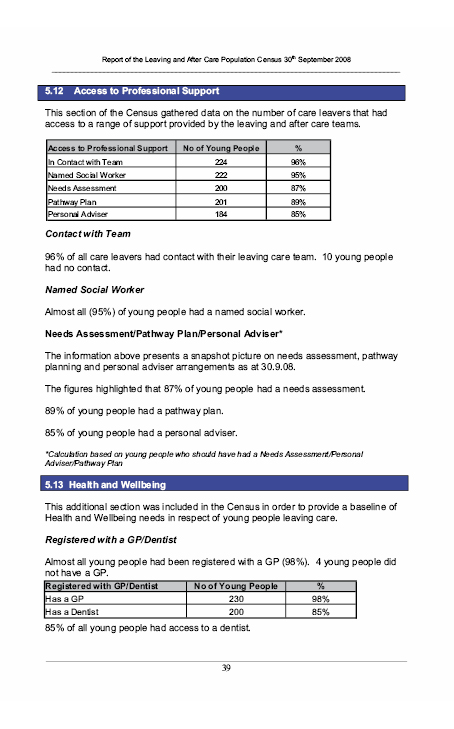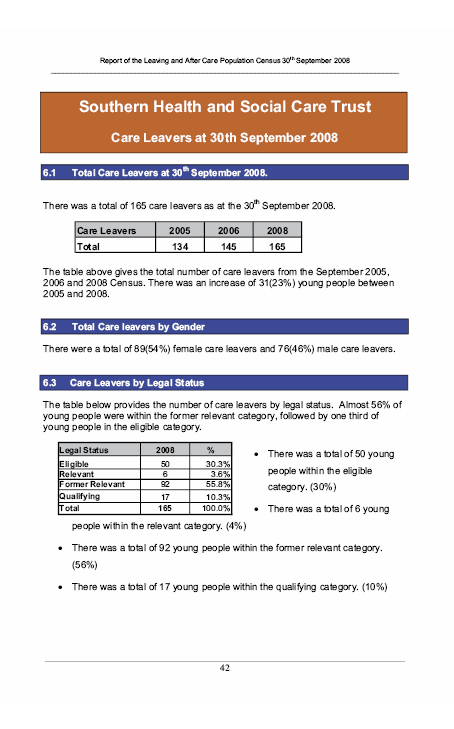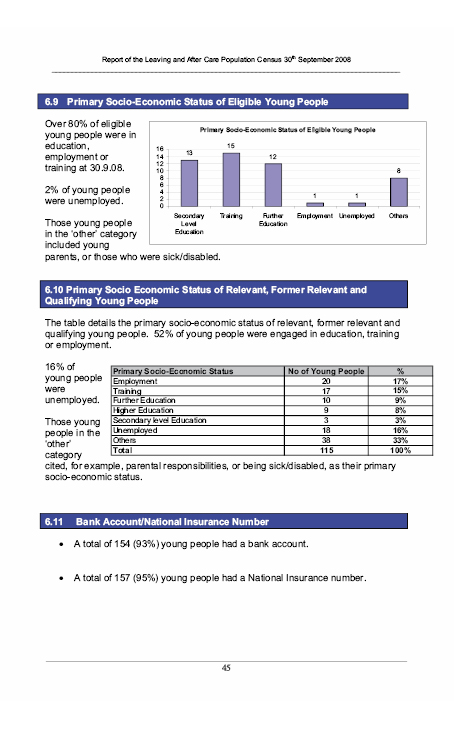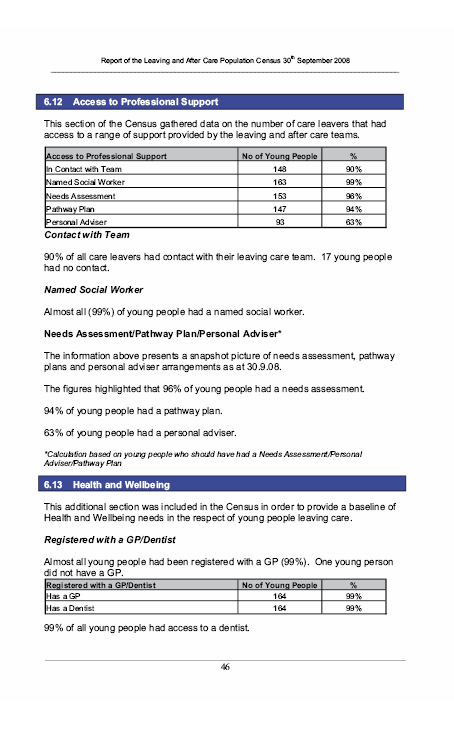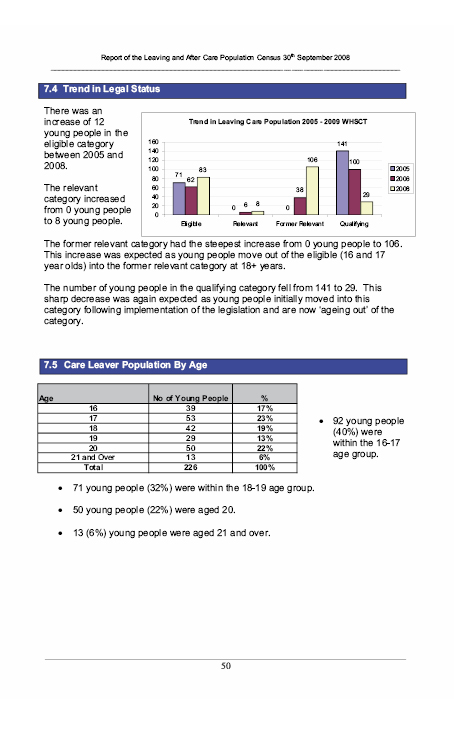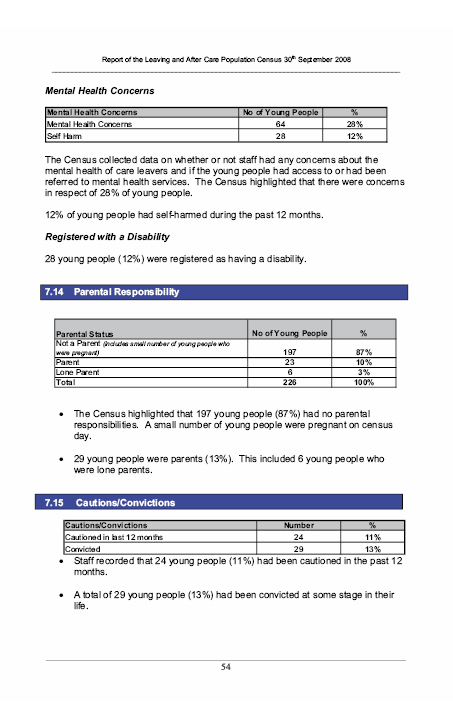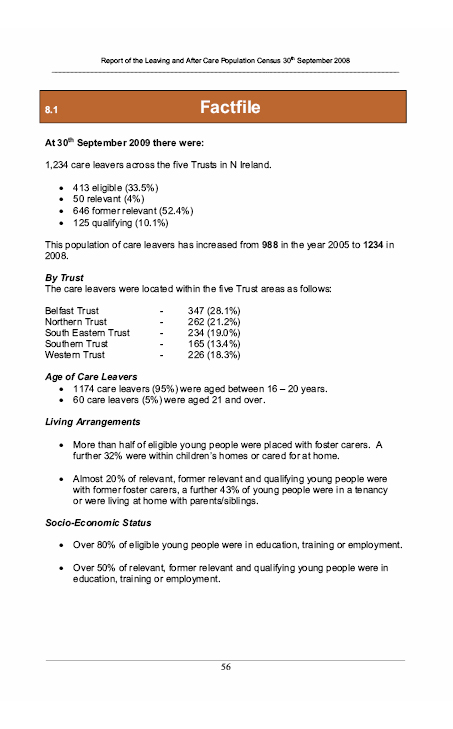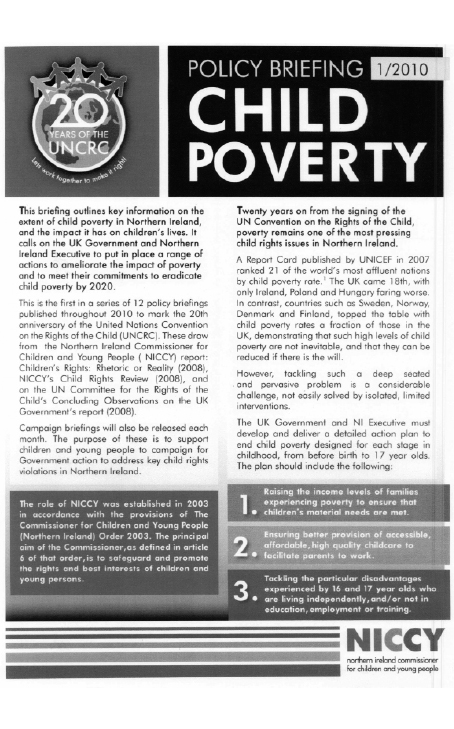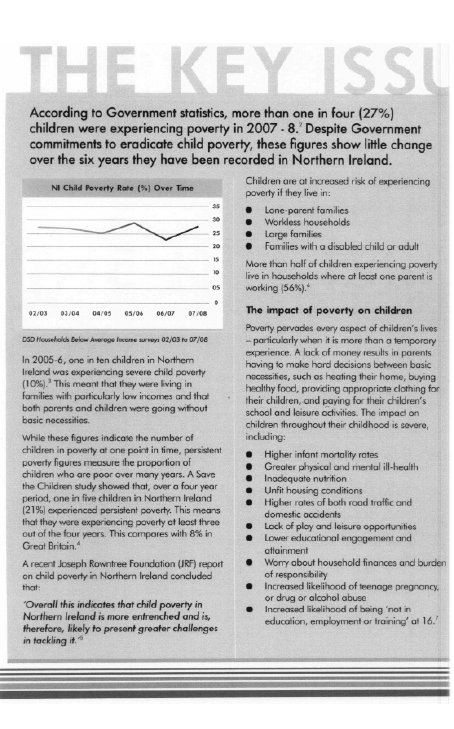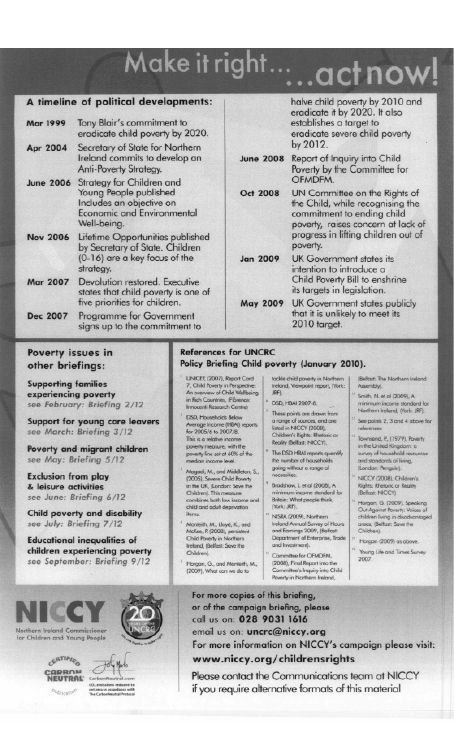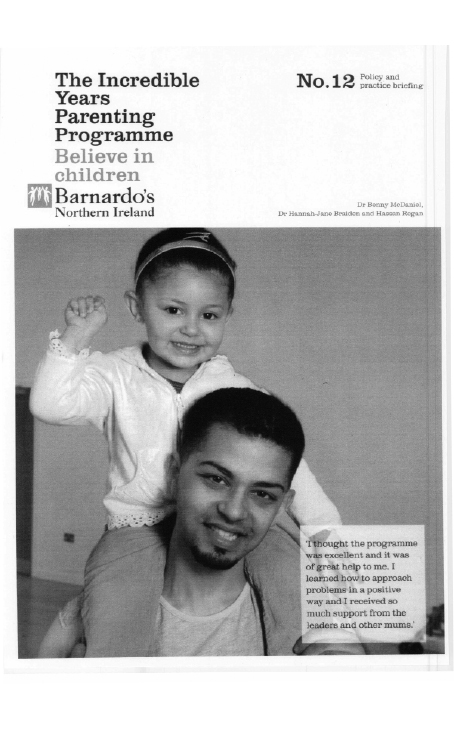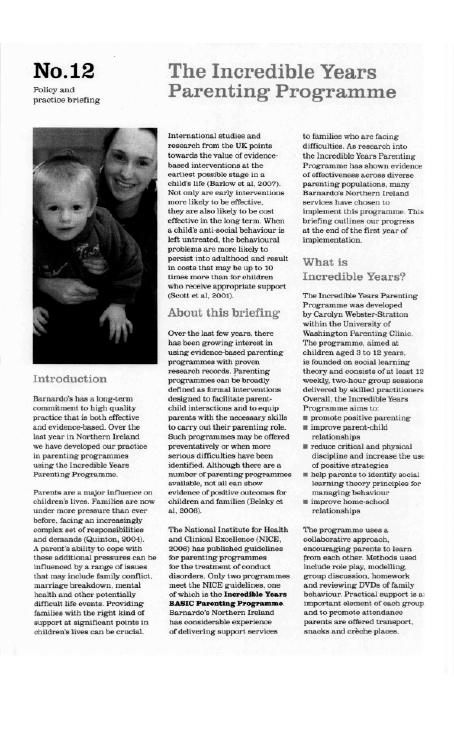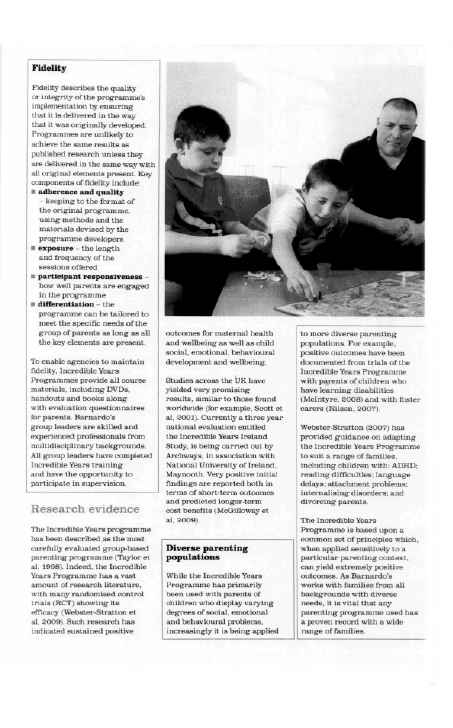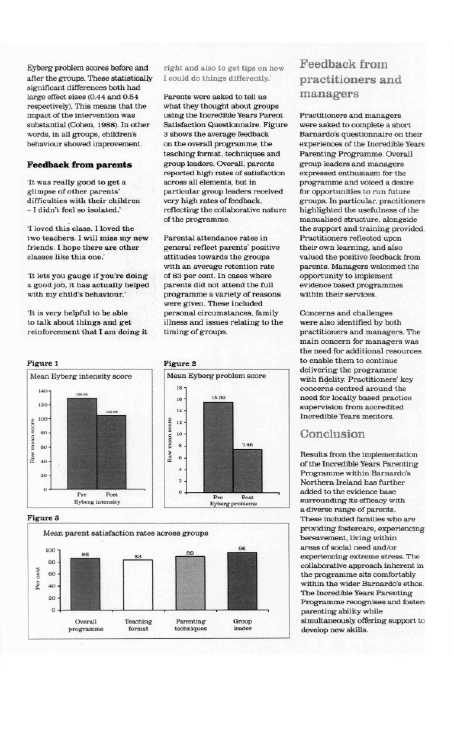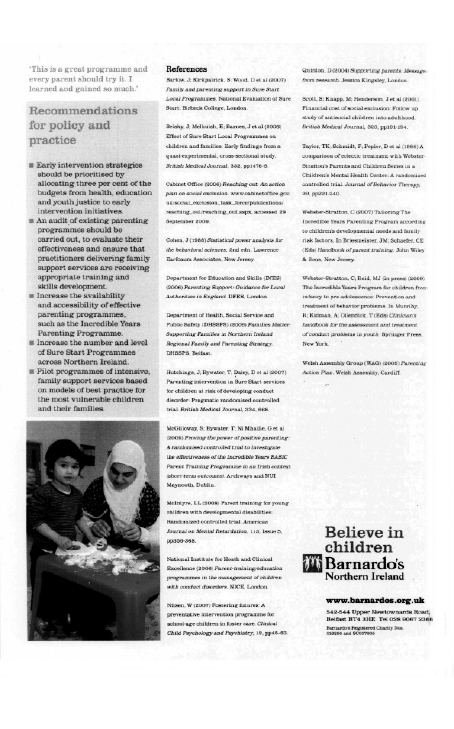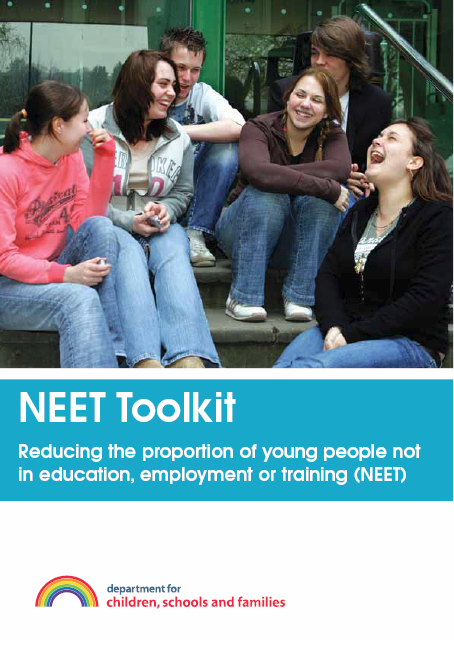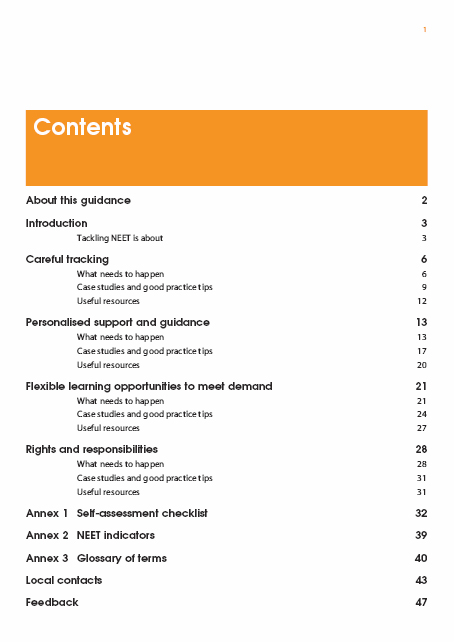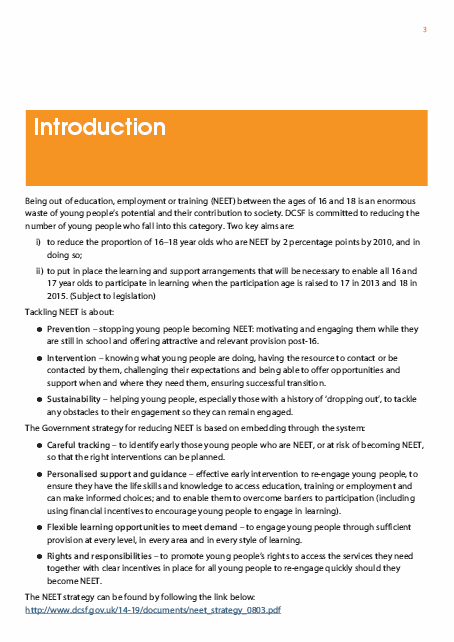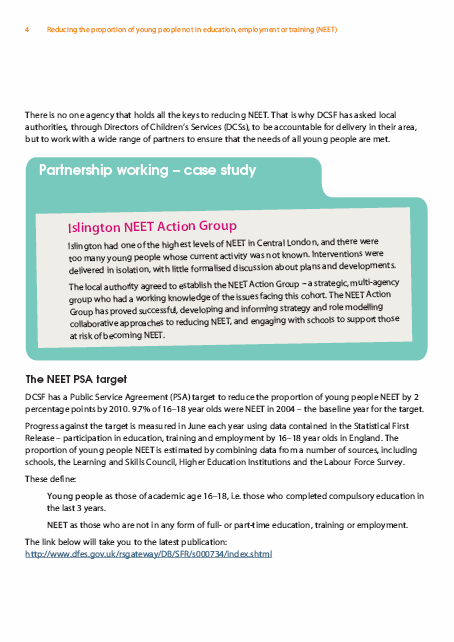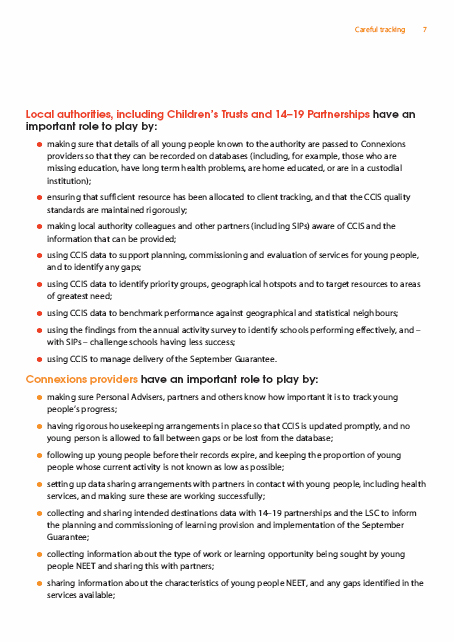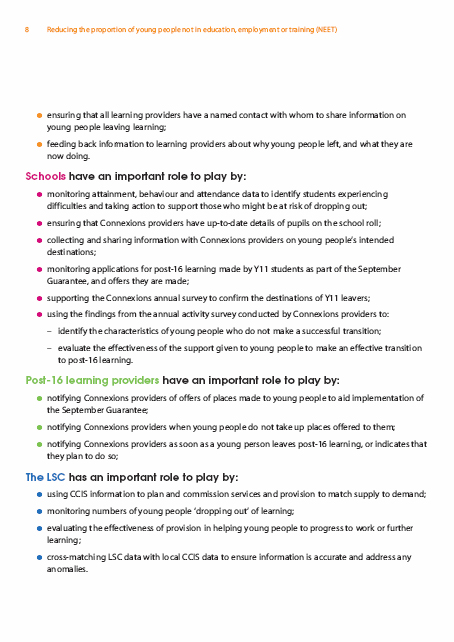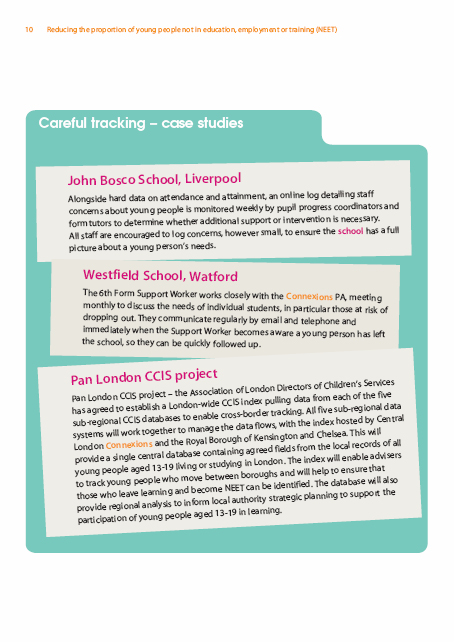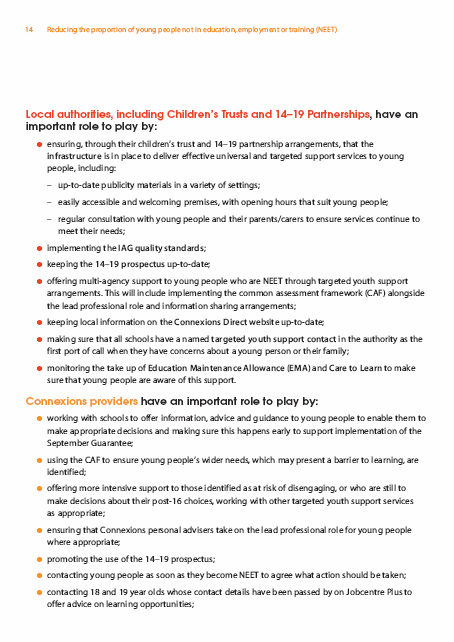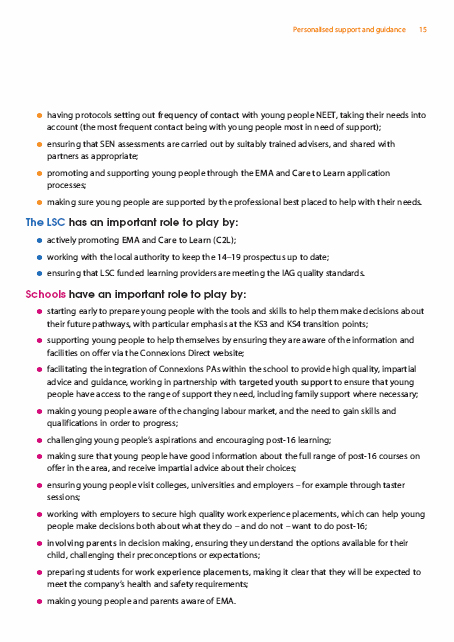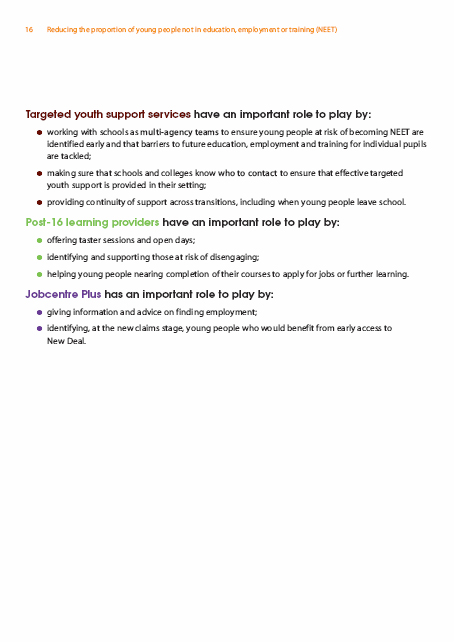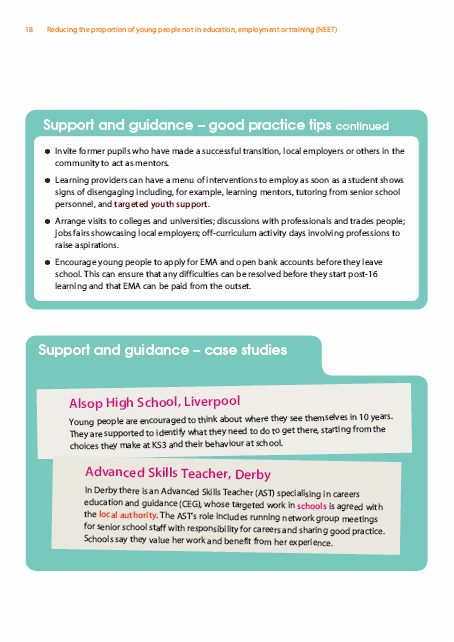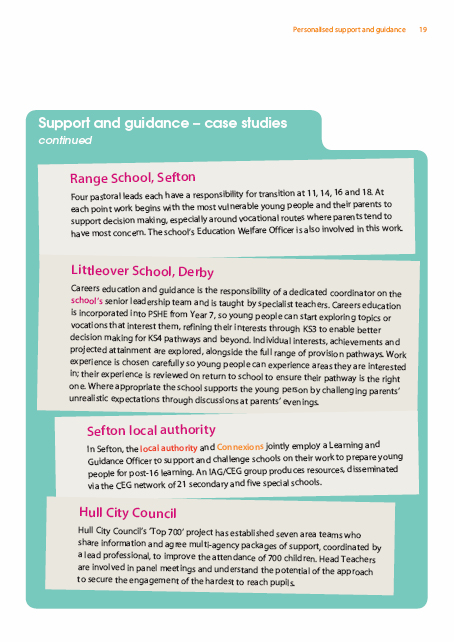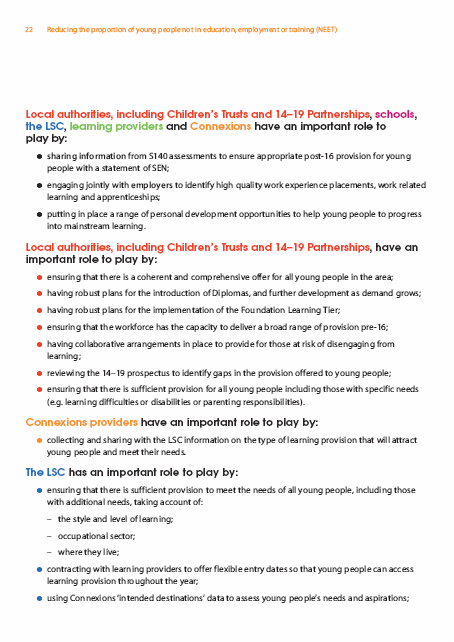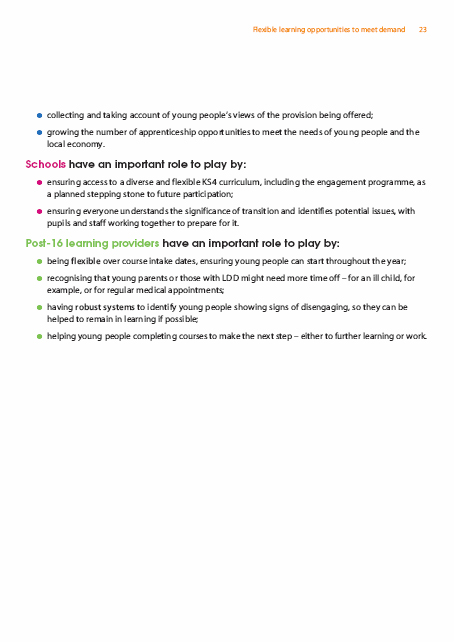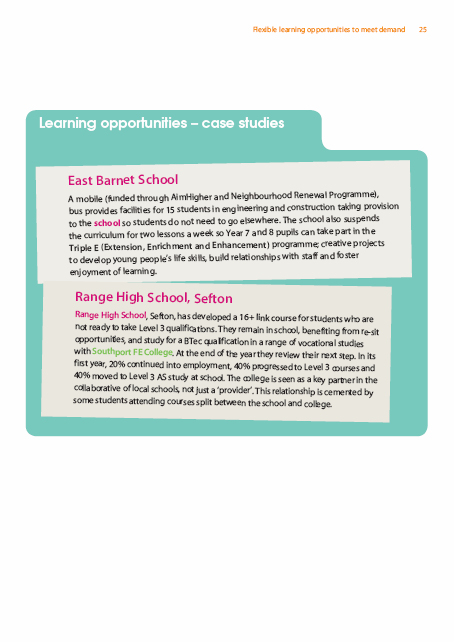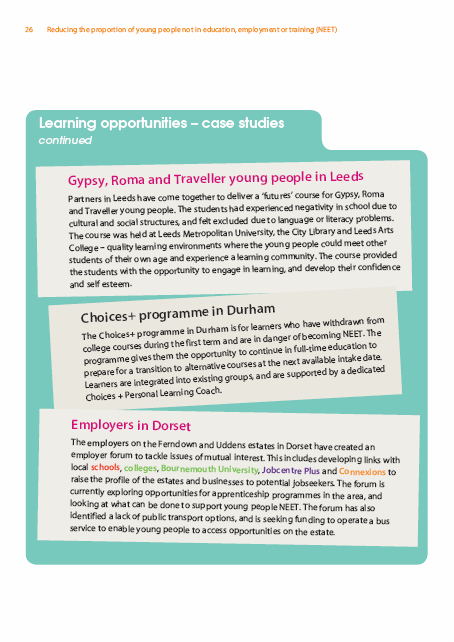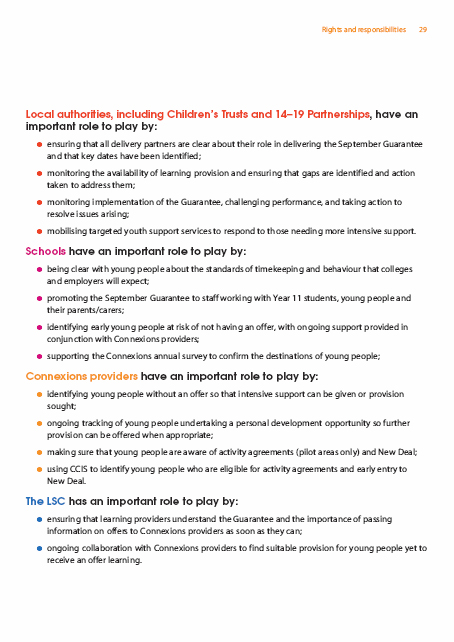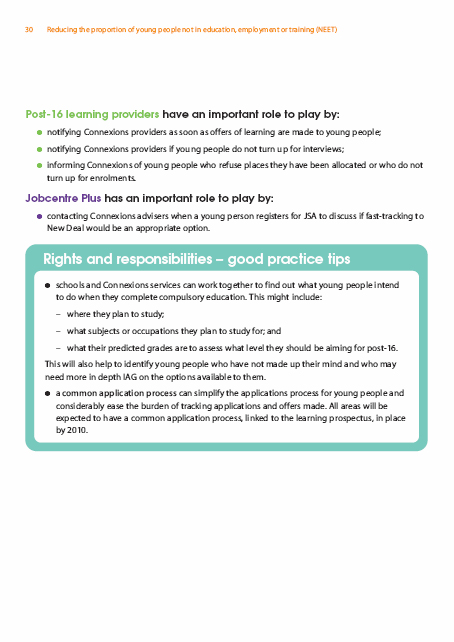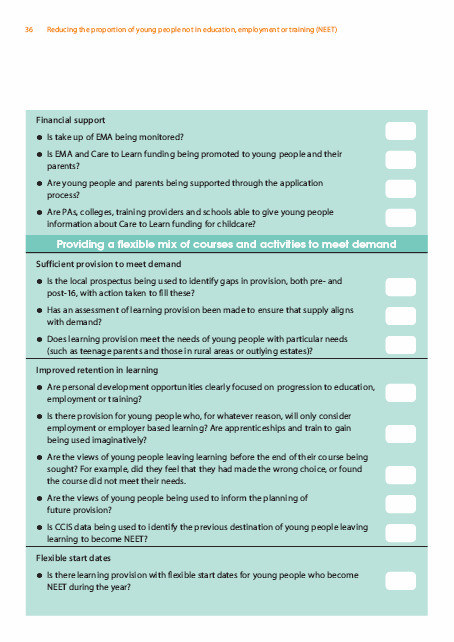This briefing note was commissioned by the Committee for Employment and Learning to provide a discussion of academic research on the effect of free school meals (FSM) on educational attainment.
The paper provides a review of existing research including studies based on Jamie Oliver's "Feed Me Better" campaign, the effects of nutritional intake on children and the economic benefits of introducing healthier meals into schools.
2 Background
A number of studies have been carried out on child nutrition, spurred in part by the work of celebrity chef Jamie Oliver and the television programme "Jamie's School Dinners" highlighting the poor quality of some of the food being provided in school canteens (such as the infamous and now banned "turkey twizzler").
The programme followed Oliver as he tried to convince local councils in England and the UK Government to improve the quality and nutritional content of school meals.
Whilst Jamie Oliver did not take the most scientific of approaches during the programme, it did highlight the importance of good quality food being available in schools. The campaign resulted in a number of schools across the UK altering their canteen menus to improve food quality with moves to expand the provision and quality of school lunches across the UK and highlighted the potential importance of good nutrition at an early age.
In 2009 the Labour Government introduced the Healthy Lives, Brighter Futures strategy which launched a series of initiatives on child development[1].
The strategy paid particular attention to health including developing healthy opportunities. In terms of school meals, the strategy wanted to increase the uptake of healthy school meals via:
- The Department for Children, Schools and Families and the Department of Health have initiated pilots to test the health and educational outcomes expected from introducing FSM for all Primary pupils. The pilots also test extending FSM eligibility to a wider group of low income families than current rules allow;
- The pilots are to run for 2 years to July 2011. The Departments will set up a joint fund of £20 million to implement and evaluate the pilots, which will be matched by £20 million from local authorities and Primary Care Trusts (PCTs); and
- The government stated they will consult on whether to change the law to allow those local authorities and schools that wish to develop different approaches to offering subsidised meals to do so.
- One year on from the publication of this strategy it was reported by the Department of Health that three pilots were underway on extending FSM, with more to follow. In addition there was a proposed extension to FSM eligibility which would increase the number of primary pupils able to receive FSM by 500,000. This project was expected to commence in September 2010.
3 Northern Ireland's Current FSM System
In Northern Ireland FSMs are not universally available to school pupils. Suitability is determined via means testing of the child's parent's income and whether or not they are in receipt of any benefits.
Pupils are eligible to Free School Meals if[2]:
- the parent/guardian is in receipt of Income Support, Income-Based Jobseeker's Allowance, Income-Related Employment and Support Allowance, or if a pupil claims Income Support in their own name; or,
- the parents receive the Child Tax Credit; and are ineligible for the Working Tax Credit because they work less than 16 hours per week; and have an annual taxable income of £16,190 or less; or,
- the parents receive Working Tax Credit; and have an annual taxable income of £16,190 or less and whose child/children are born on or after 2 July 2002 and attends full-time nursery school, primary school or special school; or
- he/she has a statement of special educational needs and is designated to require a special diet; or
- he/she is a boarder at a special school; or,
- he/she is the child of an asylum seeker supported by the Home Office National Asylum Support Service (NASS); and
- the parent receives the Guarantee element of State Pension Credit.
Education and Library Boards are responsible for administering the award of FSM.
The Office of the First Minister and Deputy First Minister (OFMDFM) developed a ten year strategy for children and young people in Northern Ireland[3]. Part of this strategy is the:
…development of a new policy framework for health promoting schools to assist schools to make effective arrangements for supporting the health and well being of pupils and staff.
In addition, the strategy intends to develop a major initiative to improve the quality of food provision in schools.
4 Scotland's Current FSM System
The Scottish Government has introduced a number of initiatives regarding school lunches, starting in 2003 with 'Hungry for Success'.
Since this programme began, a number of Acts and Regulations have been passed to promote healthy eating in schools, with the focus on getting the balance right regarding meals and encouraging pupils to make informed choices.
In Scotland free school meals can be claimed if a parent/guardian is receiving[4]:
- Income Support (IS);
- Income based Jobseekers Allowance (JSA);
- Child Tax Credit (CTC) but not Working Tax Credit and your income is less than £16,190 (with effect from April 6 2010); and
- Both maximum child tax credit and minimum working tax credit and your income is below £6,420 (with effect from April 6 2010).
Legislation was passed in November 2008 to enable local authorities to provide free school lunches to all Primary 1 to 3 pupils from August 2010. However, as a result of the increased strain on the public sector caused by the financial crisis this will be phased in, with schools that are in the 20 per cent most deprived communities in a Council area being targeted as a priority. Councils will subsequently work towards providing a nutritious free meal to all children in Primaries 1 to 3.
Discussions with Scottish civil servants found that regulations regarding the food and drink provided in Primary Schools were only introduced in 2008 and for Secondary Schools in 2009. As such no studies have yet been carried out by the Scottish government on the effect these guidelines have had on children's educational attainment or eating habits.
5 England and Wales Current FSM System
In England and Wales, as with the other regions, parents do not have to pay for school lunches if they receive any of the following:
- Income Support;
- income-based Jobseeker's Allowance;
- income-related Employment and Support Allowance;
- support under Part VI of the Immigration and Asylum Act 1999;
- the Guarantee element of State Pension Credit;
- Child Tax Credit, provided they are not entitled to Working Tax Credit and have an annual income (as assessed by HM Revenue & Customs) that does not exceed £16,190; or
- Working Tax Credit during the four-week period immediately after their employment finishes or after they start to work less than 16 hours per week.
Children who receive any of the qualifying benefits listed above in their own right are also eligible to receive free school meals.
The School Food Trust carried out a review of school meal take up in England for the year 2009 – 2010[5].
It found that the take up of school meals rose by 2.1 per cent from 39.3% in 2008 – 09 to 41.4% in 2009 – 10 for Primary Schools. In real terms, the number of pupils taking school lunches rose by 321,000 with just under half of this increase receiving FSM.
Reasons cited by LAs for the increase include:
- School policy on food;
- Marketing of meals to pupils, parents and head teachers (in the Primary sector);
- Increased eligibility and take up of FSM;
- Stay on site policies in Secondary Schools;
- Static and better attitudes to healthier meals; and
- Positive support (or a neutral attitude) to the provision of school meals on behalf of head teachers, governors and local councillors.
As stated in the report:
This represents a substantial change since the Jamie Oliver broadcasts in 2005, and a growing awareness that the quality of school food has improved dramatically.
The study identified issues still needing to be addressed within the sector:
- Poor kitchen and dining facilities;
- Reluctance by some pupils, parents and head teachers to engage with the healthy eating agenda;
- The need for longer lunchtimes balanced with the needs for physical activity; and
- The wider environment around schools.
- The study sums up by stating:
It will require further research outside the scope of this survey to evaluate the impact of healthier eating at school on the health, well-being, behaviour and attainment of children in England.
- It must be noted that following the recent change in the UK Government, Education Minister Michael Gove has announced plans to axe free school meals for half a million primary school children from low income families[6] in England.
6 Studies on School Meals and Nutritional Content
One of the larger studies conducted on the impact of school meals on academic achievement was completed in 2006 by the Centre for Research on the Wider Benefits for Learning[7]. The review asked two main research questions:
- How does nutrition impact upon health outcomes in children?; and
- How can the health outcomes that manifest as a result of nutrition impact upon school life experiences and outcomes?
To answer these questions the study's authors carried out an extensive literature review. The literature review examined research that looked at areas such as nutrition, socio-economic background of parents, breastfeeding and other variables which may have an impact on a child's academic achievement.
The study made a number of key findings:
- There is a complex interrelationship between nutrition, health, education, social and economic factors;
- Nutritional deficiencies prior to school entry have the potential to impact upon cognition outcomes in school age and adolescent children;
- Children with nutritional deficiencies are susceptible to moment to moment metabolic changes that impact upon cognitive ability and performance of the brain. Treatment with nutritional supplements can result in improved performance;
- Maintaining adequate levels of glucose throughout the day contributes to optimising cognition, suggesting nutritional intake should be designed to sustain an adequate level of glucose and to minimise fluctuations between meals;
- Nutrition, especially in the short term, is believed to impact upon individual behaviour (for example a lack of vitamin B has a causal relationship with aggressive behaviour and personality changes in teenagers);
- The development of food preferences in children depends on a range of biological and social factors;
- Food preferences in children are largely determined outside school (i.e. via parents, advertising and marketing);
- The constraints of low income create practical barriers to healthy eating. Additional socio-economic factors reinforce the effects of deprivation; and
- Obesity has adverse health implications but there are also important social repercussions of obesity experienced in youth.
The study went on to make the following recommendations;
- It may be helpful to have curriculum developed that incorporate children's understanding of nutrition and thus be more likely to encourage change;
- There may be a need to adopt a collaborative approach between schools and parents to address children's nutritional choices;
- There is an opportunity to capitalise on initiatives such as the extended schools policy, which have created an opportunity for schools to engage with parents and local communities, to improve diets and promote healthy eating among children; and
- It may be appropriate to consider changes to the structure of the school day, to improve the maintenance of glucose levels and promote better cognition among students.
A study carried out by the University of Teesside and the Food Standards Agency in 2006 involved a review of research on the effect of nutrition and dietary change on learning, education and performance of children[8].
The study was unable to draw any firm conclusions as a result of the variety of research methods used and inconclusive results, stating that:
The findings from this report suggest that currently there is not enough evidence to show that diet / nutrition effects education, learning and performance of school aged children. This report is important, as it will inform policy makers and practitioners of the need to carry out more research (particularly within the UK) before any decisions can be made with regard to the role of nutrition in education.
In addition, a number of the studies reviewed failed to take account of factors such as socio-economic background, poverty rates of individual maturation and neurodevelopment, all of which have implications on cognition[9].
The School Food Trust carried out an overview of research in the UK on the link between child nutrition and health. The review identified and summarised recent and ongoing research relevant to the remit of the Trust[10].
It reached conclusions in three areas:
- Diet and food choice;
- School based research and school food; and
- Food related research associated with health and cognitive function.
In terms of results relevant to this paper, the review found that:
- There is limited evidence to conclude that the introduction of breakfast clubs has a positive influence on nutrient intake, behaviour or academic attainment; and
- More research is needed to provide evidence of the relationship between a healthy diet and subsequent physical and mental well being. Developing collaborative research programmes and working with partners will strengthen messages about the need for healthy eating and tackling obesity.
The review concludes by stating:
Limited research activities investigating the impact of diet and nutrition on health, behaviour and academic achievement highlights the need for continuing research activities to build a robust evidence base that supports the case for change.
7 Studies on School Meals and Academic Achievement and Behaviour
Studies on academic achievement and behaviour in school are relatively limited, with the focus generally around health outcomes rather than educational. However, a few studies do focus on this area.
A study by Feinstein et al[11] in 2008 tested the impact of diet at several points in childhood on children's school attainment. The study, using longitudinal data from the Avon Longitudinal Study of Parents and Children (ALSPAC)[12], examined differences between children who used packed lunches and those who ate school meals. It also took into consideration children's diet before they started school.
The study used three measures of attainment:
- School entry assessments at ages 4-5;
- Key Stage 1 tests at ages 6-7; and
- Key Stage 2 tests at ages 10-11.
Diet and achievement are influenced by a number of socioeconomic, demographic and lifestyle factors. In order to ensure these did not influence the outcome of the study, controls were applied in order to remove any confounding bias.
The study found that a child who eats a higher level of junk food at age 3 than their peers are associated with lower test scores at Key Stage 2. For children with a 'health conscious diet' it was found that they had higher test scores at Key Stage 2.
However:
Although there was a negative association between early 'junk food' consumption and later attainment scores, the estimated effect was small, suggesting that nutrition may have a diminishing role in attainment as children grow older…This may indicate a developmental period or stage where children are more susceptible to the long term cognitive impact of poor nutrition.
Feinstein et al identified policy implications for the study, stating that it:
…highlights the importance of diet before entry into formal education for later school attainment and calls for a concerted effort between schools, families, government departments and other agencies to improve the nutritional intake of children.
The School Food Trust is a non-departmental public body created by the Department for Education and Skills in 2005 to promote the education and health of children and young people by improving the quality of food supplied and consumed in schools.
It has carried out a study on school lunches to determine if the introduction of healthier food has a positive impact on learning behaviour in primary schools[13].
The study involved six primary schools over a twelve week period with four intervention schools and two control schools.
The four intervention schools had a variety of food interventions, such as new menus compliant with food based standards, health eating workshops and providing better marketing materials (such as menus with pictures of the meals). The schools also had changes made to the dining environment such as alterations to the layout, the queuing system and the redecorating of the dining room.
In order to test changes to pupil behaviour, students were initially observed prior to the beginning of the 12 week period to establish a baseline and again at the end of the intervention.
Behaviour was observed in three ways:
- Pupil-teacher interaction;
- Pupil-pupil interaction; and
- Working alone.
- Behaviour was determined as either on-task (pupils level of concentration) or off-task (pupils were disengaged and/or disruptive). They study found that following the intervention, pupils were 3.4 times more likely to be on task in pupil-teacher interaction compared with pupils from the control schools. Conversely, pupils from the intervention schools were 2.3 times more likely to be off task in pupil-pupil interactions than in the control schools.
- The study concluded that:
This study provides some objective evidence that an intervention in primary schools to improve school food and the dining environment has a positive impact on pupils' alertness and their ability to learn in the classroom after lunch. However, if this raised alertness is not appropriately channelled and supervised, it may result in increased off-task behaviour when pupils are asked to work together.
A recent study by Belot and James (2009)[14] used the "Jamie Oliver Feed Me Better" campaign as its source material. As the campaign focused on a specific area (the Greenwich Borough in London, England) it was possible to conduct a before and after study on the pupils of schools who joined the project.
The study used pupil and school level data from the National Pupil Database and School Census. It subsequently compares educational outcomes (at Keystage 2, which has three main components – English, Maths and Sciences) before and after the reform with neighbouring Local Educational Authorities (LEAs) acting as control groups.
Belot and James investigated three outcome variables:
- Educational Outcomes;
- Take-up Rates; and
- Sickness Absenteeism.
- The study found that Key Stage 2 results were significantly improved after the introduction of the improved school meals, with results in English and Science most effected. For English, between 3 and 6% more pupils scored level 4 and between 3 and 8% more pupils gaining level 5 in Science.
- Belot and James concluded that there was no evidence that the campaign helped children who take Free School Meals, with the authors suggesting that it is FSM pupils who would find the change in menu most difficult as:
…these pupils were probably eating the "unhealthy" meals on a daily basis and would therefore maybe the most put off by the change in menus.
In terms of take up rates of FSM, the study found no change.
Absenteeism is divided into authorised and unauthorised absences. Authorised absences are those that are formally pre-arranged with the school and are mostly linked to sickness. The study found that authorised absences dropped by 0.8% which may not seem a significant figure but equates to 15% of the average rate of absenteeism. There was no apparent effect on unauthorised absences.
The study also examined the costs and benefits of the project for the schools themselves. By September 2007, 28,000 children from the county benefited from the programme, at a cost of £1.2 million for the council (£43 per child). The majority of these costs were one off and capital based, such as new kitchens and equipment, as many of the schools were simply not outfitted for cooking food from scratch.
Whilst assessing the economic benefits of healthy school lunches, Belot and James used a similar process to that used by Machin and McNally (2008) for their analysis of the benefits of the Literacy Hour introduced to schools in the 1990s. Machin and McNally calculated the overall benefit of the programme in terms of future labour market earnings using the British Cohort Study, that includes wages at age 30 and reading age at 10. Machin and McNally estimated the benefit of literacy hour to be between £75.40 and £196.32 per annum per child, adding up to a lifetime benefit of between £2,103 and £5,476.
Belot and James state that:
The effects we have identified are comparable in magnitude to those estimates by Machin and McNall.
8 Studies on School Meals and Economic Benefit
It is important to consider the economic implications of nutritious school meals and academic achievement. As seen above in the Belot and James study, it can be suggested that pupils that achieve better through primary and secondary school will provide additional benefit to the economy.
A study by Shemil et al[15] evaluated school breakfast clubs and identified three areas where the introduction of clubs could have an economic impact:
- Individual (children, parents, school based staff);
- Institutional (school, family, service provider); and
- More widely (government, employers, etc).
The study examined four lines of enquiry:
- Description of financial structures and costs;
- Description of resource inputs and estimation of associated costs;
- Estimation of cost consequences that may result from the effects of clubs on schools, children, their families and communities; and
- An analysis of relationships between the net costs of implementing and maintaining the clubs and observed benefits of the clubs.
Qualitative data gathered from the study found that participants frequently suggested that improvements in attendance, punctuality, behaviour and concentration were attributable to the presence of a club and had improved the marginal efficiency of resources allocated to teaching and learning.
In addition, several parents who were questioned as part of the study stated that where breakfast was provided for free at school there was a reduction in household food costs, which could make a considerable financial contribution for the family. Other benefits include a reduction in childcare costs and increased opportunities for parents to work or study.
- The study's authors stated:
This factor would not only impact directly at the level of the family economy, but would also, from a societal perspective, precipitate changes in the indirect costs associated with the value of production.
However, the study concluded that:
The costs of a school breakfast club appears to be associated with some weak benefits (as well as some unmeasured societal benefits linked to employment and family economy) but it is not possible to conclude whether or not this initiative was the best way to use the available funding.
9 Summary
Consideration of the studies discussed in this paper has highlighted a number of key points:
- Nutrition has an effect on academic achievement and behaviour in children, however, the extent and duration of this effect is still unclear, although one study found an improvement in Key Stage test results following the Jamie Oliver Feed Me Better Campaign was introduced to schools in England;
- Junk food can have a negative impact on learning for children aged 3;
- Diet before entry into formal education has an impact on later school attainment;
- Interventions to improve school food and the dining environment can have a positive impact on pupils alertness, behaviour and their ability in the classroom; and
- There may be potentially significant long term economic benefits from improving the nutrition of school meals.
Whilst there is a body of evidence surrounding the effect of healthy school meals on children, it must be noted that a number of studies highlighted the need for more research in this area. Importantly, with regional governments rolling out FSM to more schools and greater numbers of children, the opportunity for research into its effects is improving, although these studies will by the nature of the topic being examined, necessitate longitudinal studies.
[1] Department of Health and the Department for children, schools and families, Healthy Lives, brighter futures: The strategy for children and young people's health http://www.dh.gov.uk/prod_consum_dh/groups/dh_digitalassets/documents/digitalasset/dh_094397.pdf (first accessed 16th July 2010)
[2] Education Support for Northern Ireland Benefits, Free School Meals http://www.education-support.org.uk/parents/benefits/free-school-meals (first accessed 27th July 2010)
[3] OFMDFM, 2006, Our Children and Young People – our pledge: A ten year strategy for children and young people in Northern Ireland 2006 - 2016
[4] Scottish Government, School Lunches, www.scotland.gov.uk/topics/Education/Schools/HLivi/schoolmeals
[5] School Food Trust, Nelson et al July 2010, School Lunch take up in England 2009 – 2010
[6] The Guardian 22nd June 2010 Free school meals: Health professionals join the backlash over cuts http://www.guardian.co.uk/education/2010/jun/22/free-school-meals-health-backlash-cuts (first accessed 21st July 2010)
[7] Centre for Research on the Wider Benefits for Learning June 2006 Sorhaindo, A and Feintstein, L What is the Relationship Between Child Nutrition and School Outcomes
[8] University of Teesside and Food Standards Agency, April 2006 A systematic review of the effect of nutrition, diet and dietary change on learning, education and performance of children of relevance to UK schools http://www.food.gov.uk/multimedia/pdfs/systemreview.pdf (First accessed 19th July 2010)
[9] Please note, the University of Teeside review was carried out on research conducted mainly in the USA and all papers discussed were pre 2006. Of the 29 papers considered in detail, 15 were on breakfast, 6 on sugar and ADHD, 5 on fish oil and 2 considered vitamin supplements. The final study examined good diet but was dropped due to poor quality.
[10] School Food Trust The Link Between Child Nutrition and Health: An Overview of Research in the UK
[11] Journal of Epidemiol Community Health 2008 Feinstein et al Dietary Patterns Related to Attainment in School: The Importance of Early Eating Patterns
[12] ALSPAC is an ongoing population based study designed to investigate the effects of environment, genetics and other influences on the health and development of children and has 13,988 participants born between 1 April 1999 and 31 December 1992.
[13] School Food Trust School Lunch and Learning Behaviour in Primary Schools: An Intervention Study www.schoolfoodtrust.org.uk/download/.../sft_slab1_behavioural_findings.pdf (first accessed 23rd July 2010)
[14]Institute for Social and Economic Research, January 2009, Belot, M and James, J Healthy School Meals and Educational Outcomes http://www.iser.essex.ac.uk/files/iser_working_papers/2009-01.pdf (first accessed 23rd July 2010)
[15] Childcare, Health and Development, September 2004 Shemil et al A National Evaluation of School Breakfast Clubs: Where Does Economics Fit in?
Northern Ireland Adviser on Employment and Skills
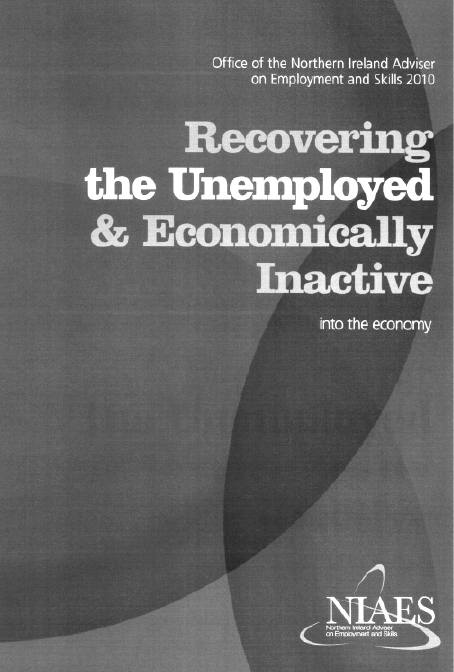




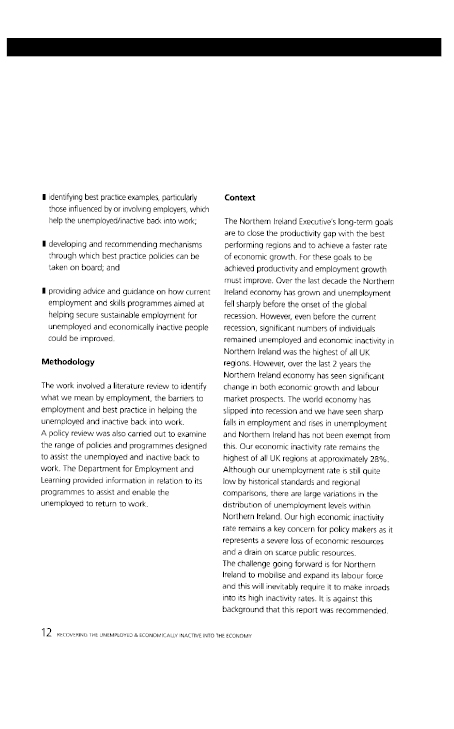
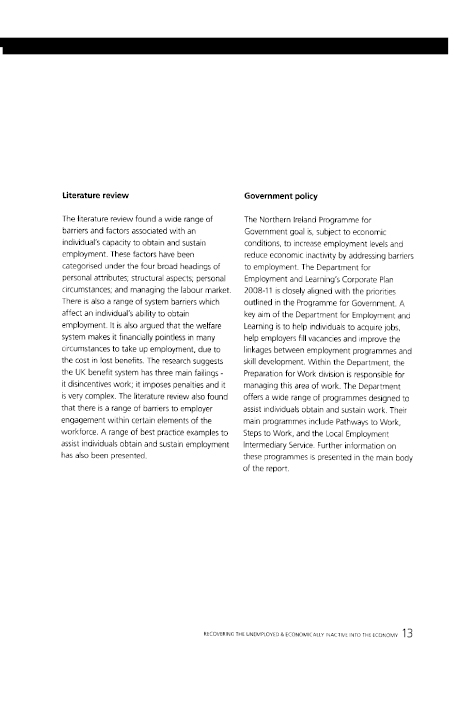
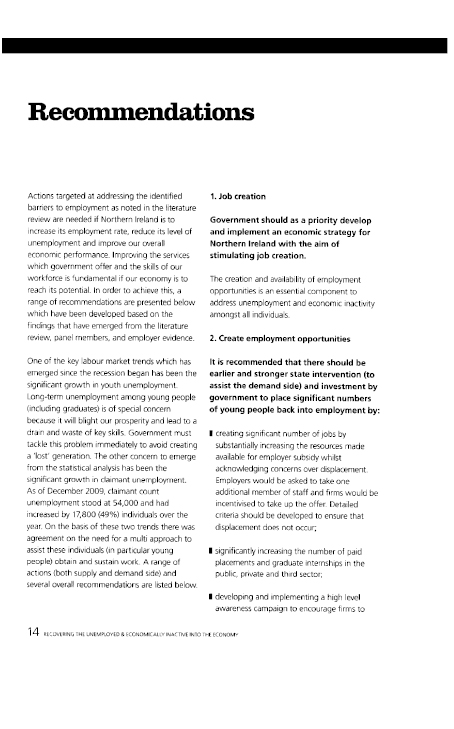



Department of Education
Committee for Employment and Learning
Room 283,
Parliament Buildings,
Stormont,
Ballymiscaw,
Belfast BT4 3XX
Telephone: (028) 9052 0379
Fax: (028) 9052 1433
E-mail: cel@niassembly.gov.uk
Caitriona Ruane MLA
Minister of Education
Department of Education
Rathgael House
Balloo Road
Bangor
BT19 7PR 2nd July 2010
Dear Caitriona,
Re: Bus passes for students who undertake study at more than one school
As you are aware, the Committee for Employment and Learning is currently undertaking an Inquiry into young people (16-24) who are not in education, employment or training (NEET). The Committee wanted to ensure that Members heard the views of rural people and decided it would be useful to ask the principal of a rural school what methods are available to attempt to ensure that pupils are less likely to find themselves NEET. Mr Errol McMaster, Principal of Glastry College on the Ards peninsula recently briefed the Committee on this issue.
The Committee was impressed by much of what Mr McMaster said about the issue of young people who are NEET. Members were particularly interested in the collaboration between Mr McMaster's school and other schools in the area under the North Down and Ards Collaborative Group. This group, amongst other things, allows schools to band together to provide a wider range of subject choices to pupils, particularly at A Level. Mr McMaster indicated a range of benefits provided by this collaborative approach and the Committee believes that it is a useful way to increase choices for young people in rural (and urban) areas which may contribute towards ensuring that they remain engaged in full-time education or training.
Mr McMaster indicated that the difficulty with this collaboration is bus passes. The Committee understands that currently students' bus passes will take them from their home bus stop to the school or college at which they are registered, but not to other schools or colleges where they may be studying and starting their day. The passes really only apply to a single route. Mr McMaster highlighted that this has caused significant problems. I understand that Mr McMaster and colleagues at St. Columbanus College in Bangor have already flagged this issue up to your officials and those of the SEELB.
The Committee agreed that I should write to you to ask you to examine this issue. It would seem that there should be a straightforward and practical solution to this issue.
I will be writing in similar terms to the Regional Development Minister as transport sits within his remit.
Yours sincerely,

Dolores Kelly MLA
Chairperson




Committee for Employment and Learning
Room 283,
Parliament Buildings,
Stormont, Ballymiscaw,
Belfast BT4 3XX
Telephone: (028) 9052 0379
Fax: (028) 9052 1433
E-mail: cel@niassembly.gov.uk
Dolores Kelly MLA, Chairperson
Committee for Employment and Learning
Caitríona Ruane MLA
Minister of Education
Department of Education
Rathgael House, Balloo Road, Bangor
BT19 7PR 10th September 2010
Dear Caitríona,
Re: Bus passes for students who undertake study at more than one school
Many thanks for your response of 25th August with regard to the above. The Committee considered your response at its meeting on 8th September and agreed that I should write to you again to seek greater clarification.
In your response you indicate that it would be "…both difficult and costly…" to make changes to the bussing system even if the change was just for the buses to and from schools at the beginning and end of the day. The Committee would be interested to know if any analysis of the costs involved in making the pupils' bus passes more flexible at the beginning and end of the day has actually been undertaken and, if so, what level of increased cost is involved.
The evidence submitted to the Committee thusfar, with respect to its Inquiry into young people who are not in education, employment or training (NEET), is very supportive of Area Learning Community (ALC) concept, which you mention in your response. The ALCs are a positive and progressive innovation and the Committee has firsthand experience of this model working very well in other jurisdictions to help combat the rise in the number of young people who are NEET and increase the options open to them. The Committee would be keen to hear more about your ideas around using the ALCs to resolve transport issues and issues surrounding the broadening of the curriculum.
The Committee is very supportive of this mode of working and looks forward to sharing the findings of its Inquiry with you. Members are committed to working in co-operation with other Committees and Executive Departments on the NEETs issue and greatly appreciate your assistance in achieving this end.
Yours sincerely,

Dolores Kelly MLA
Chairperson



Fastrack to IT Northern Ireland

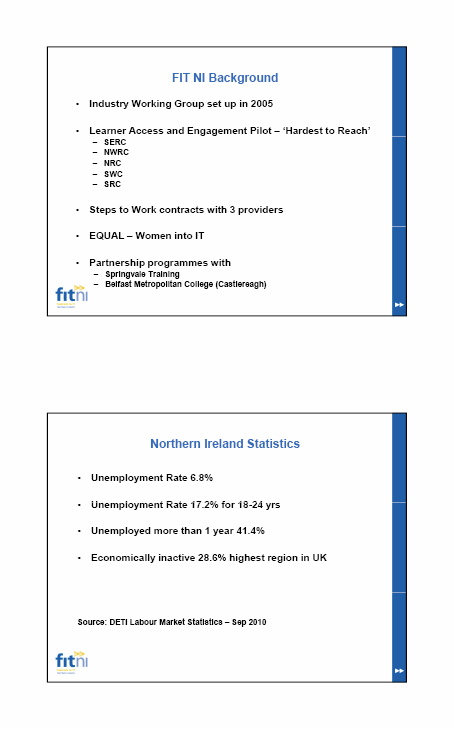
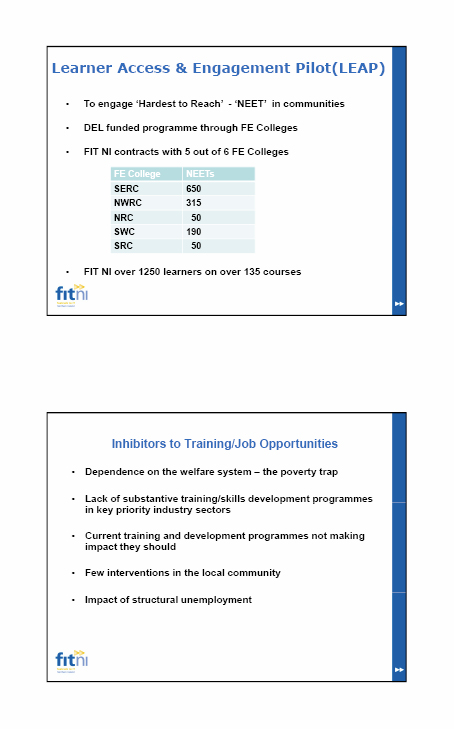

Queens University/Princes Trust/Save the Children
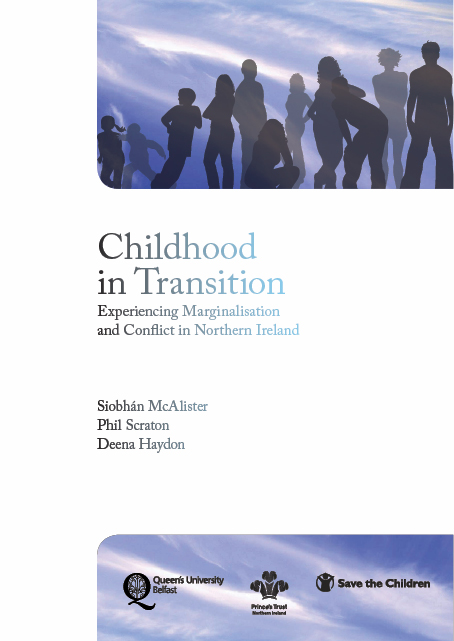
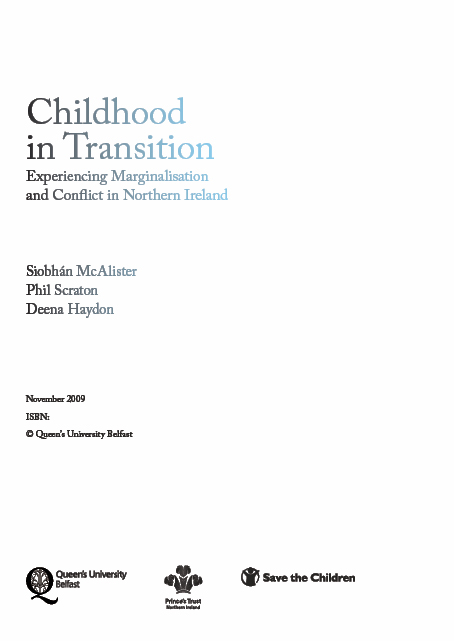

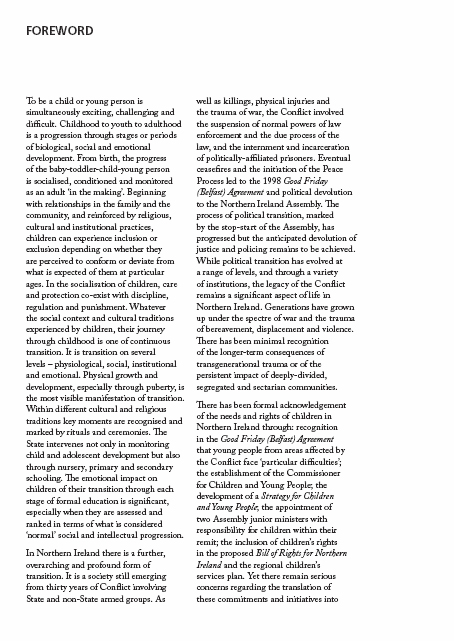


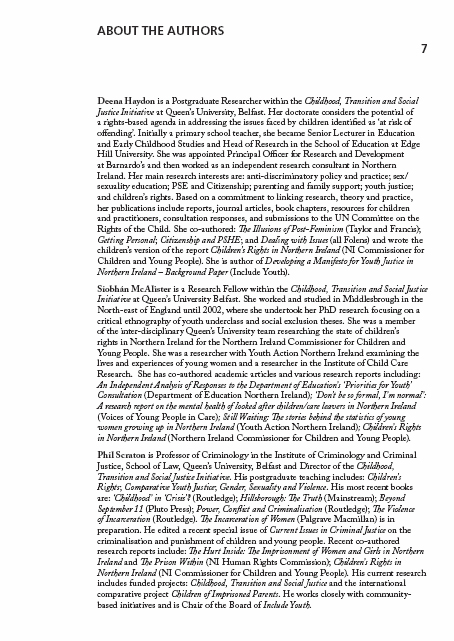

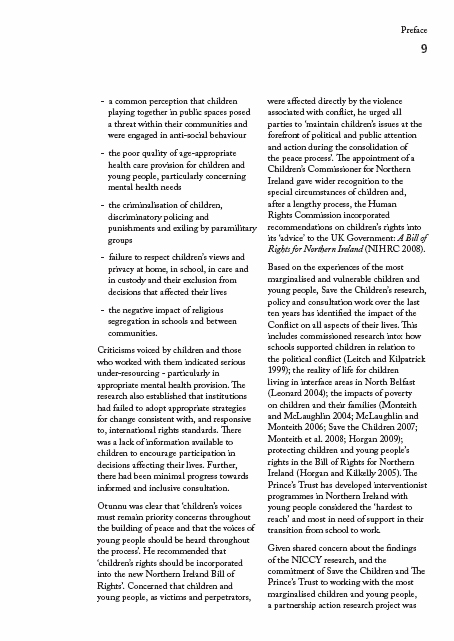
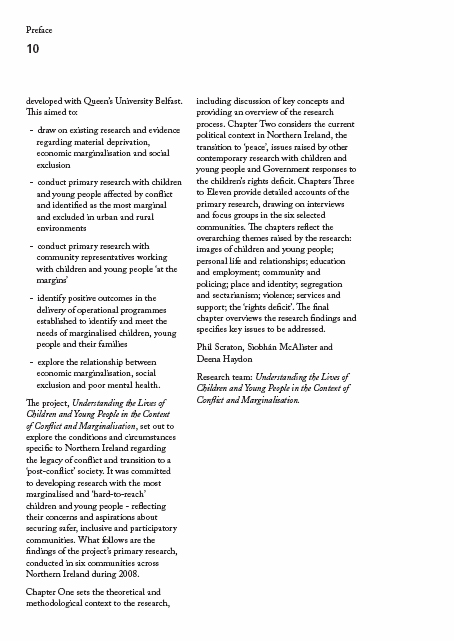



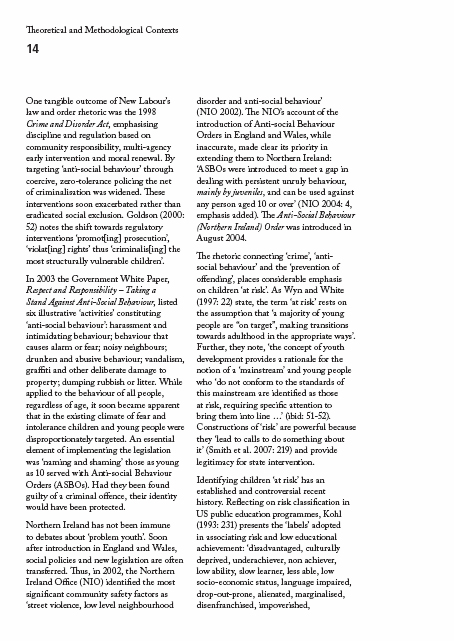
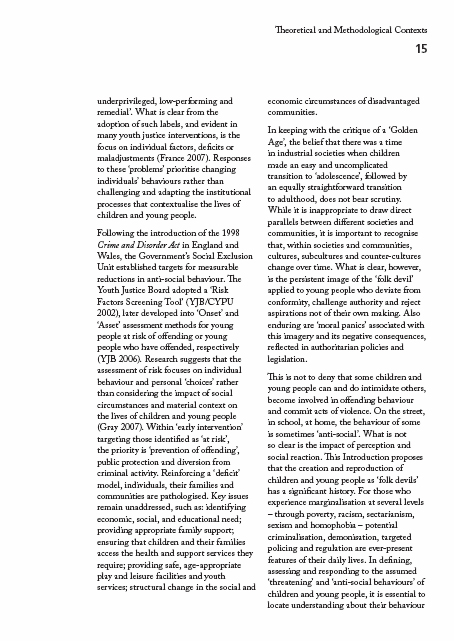
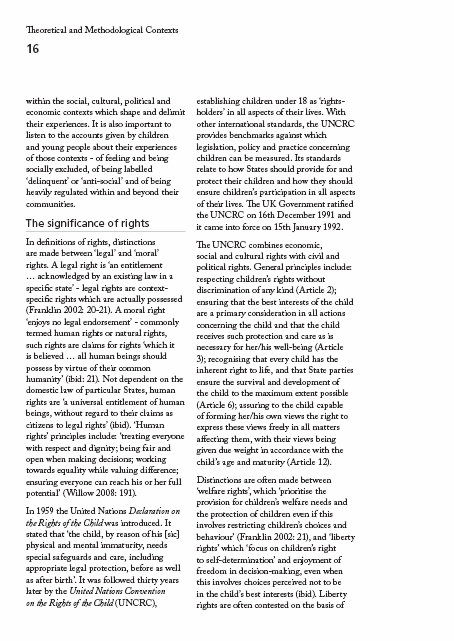

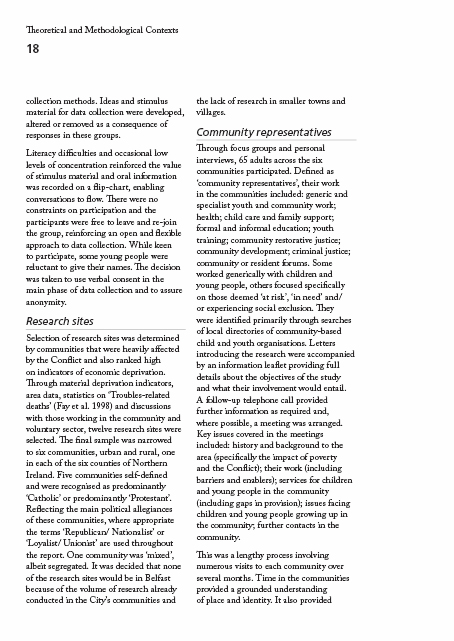






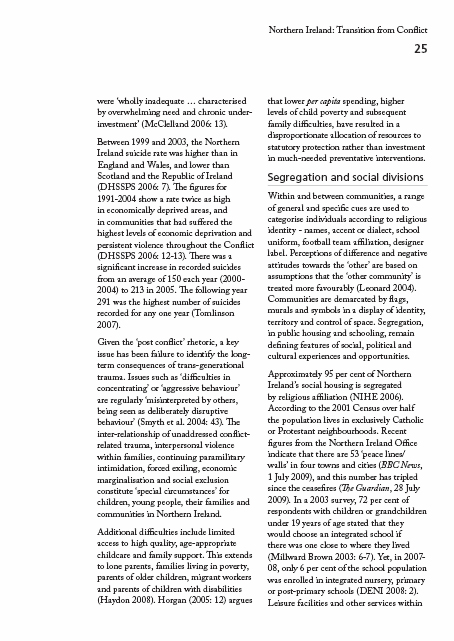
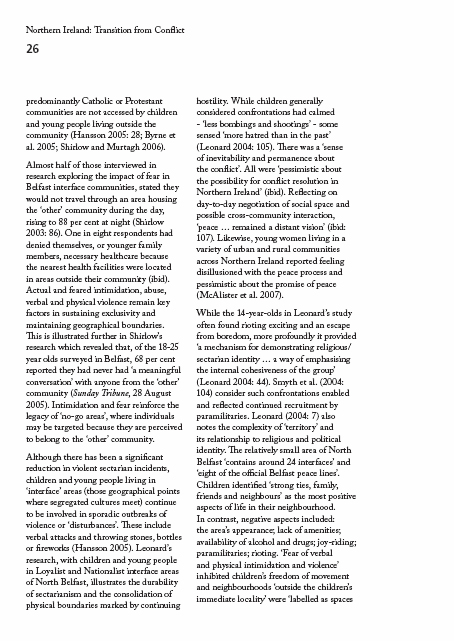

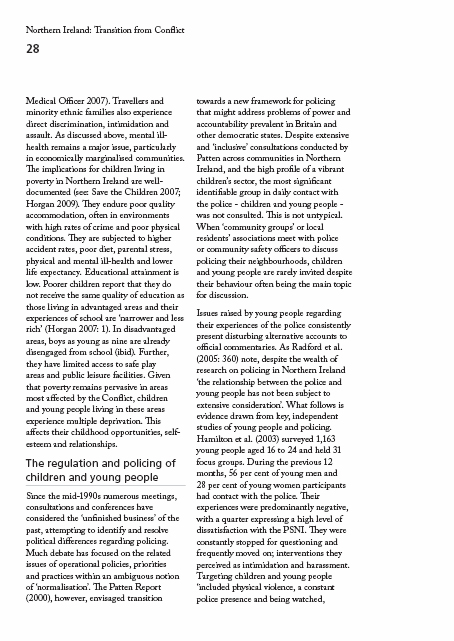


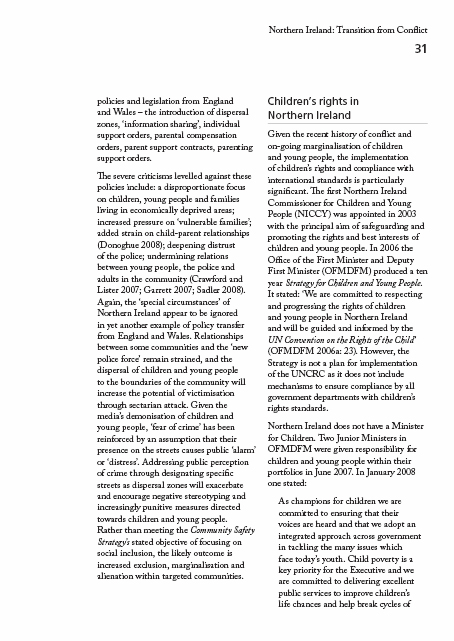
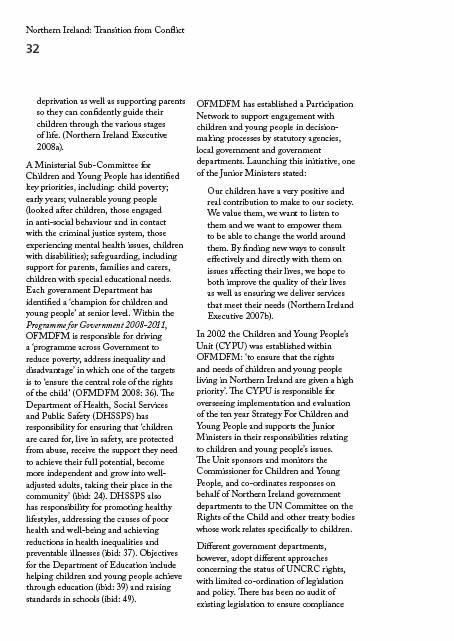
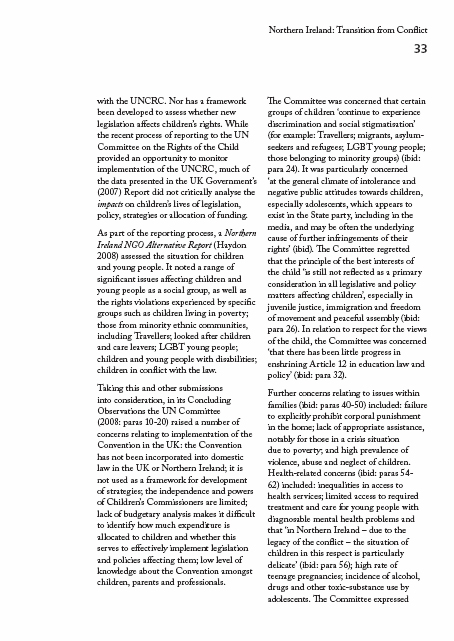







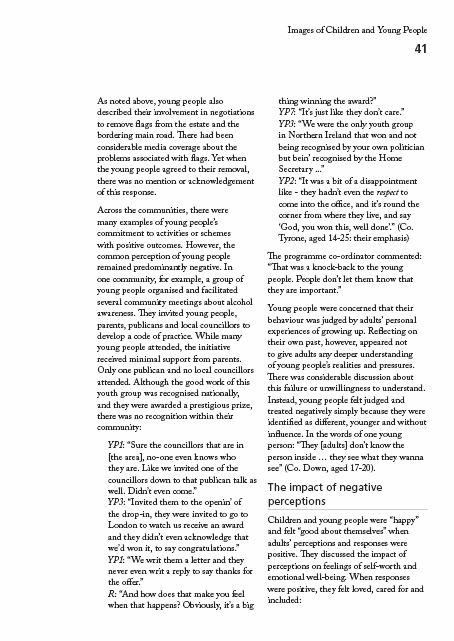


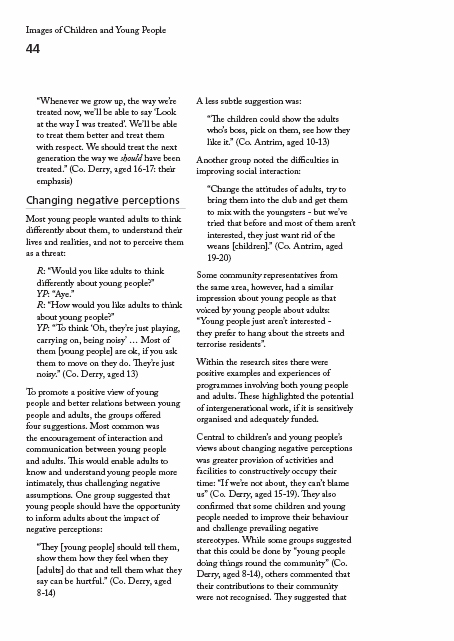











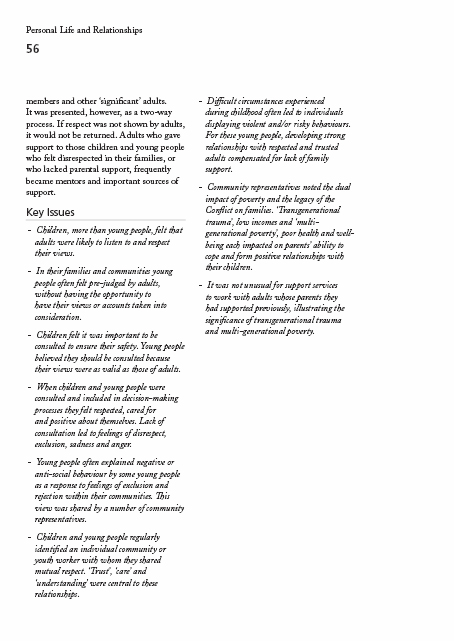





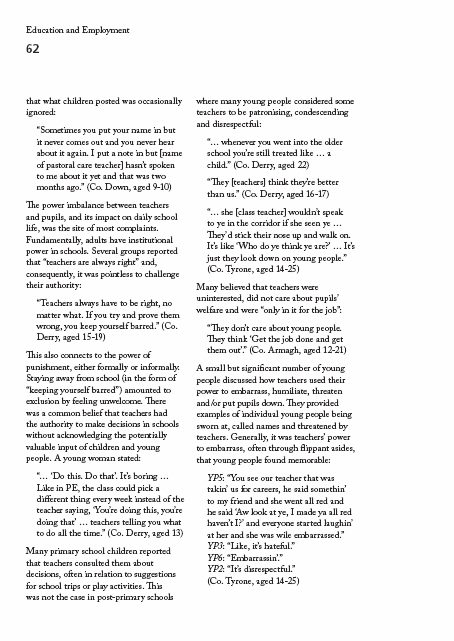



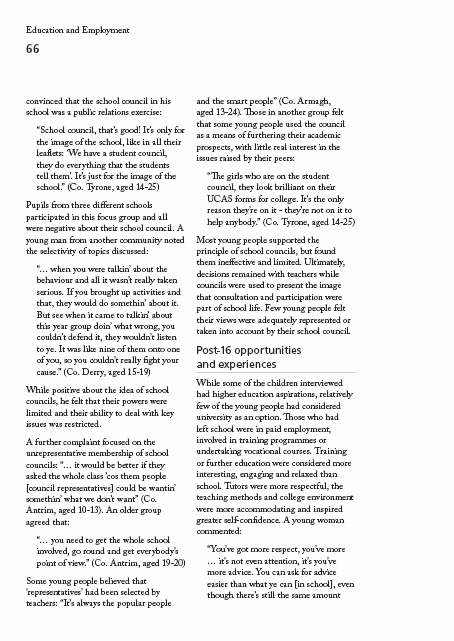

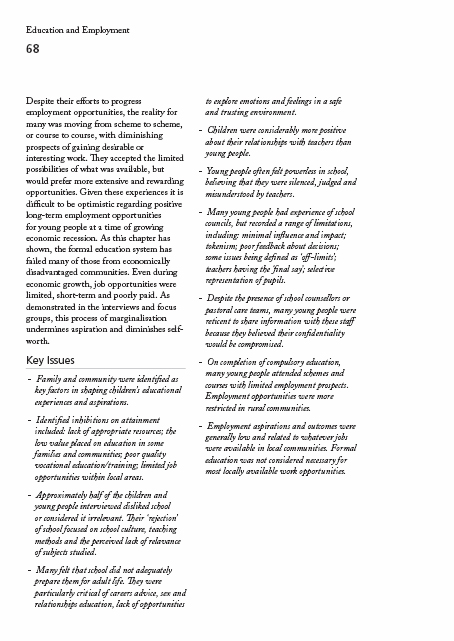




Childhood in Transition
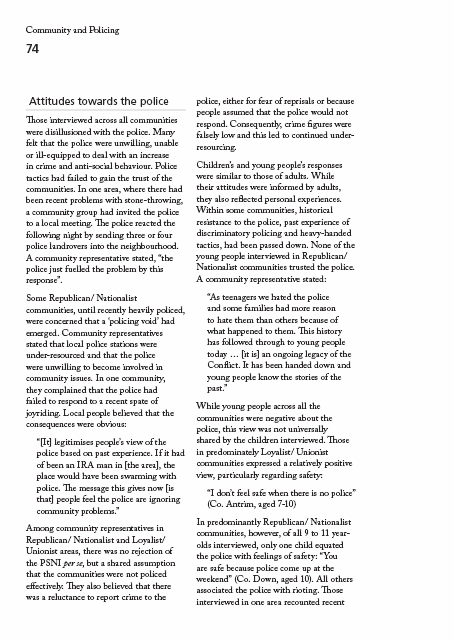






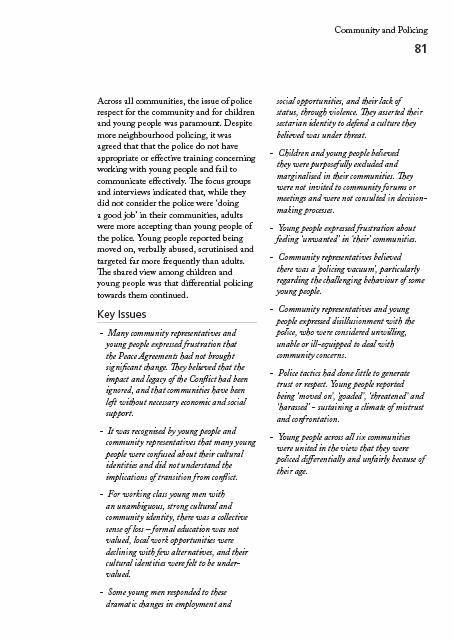
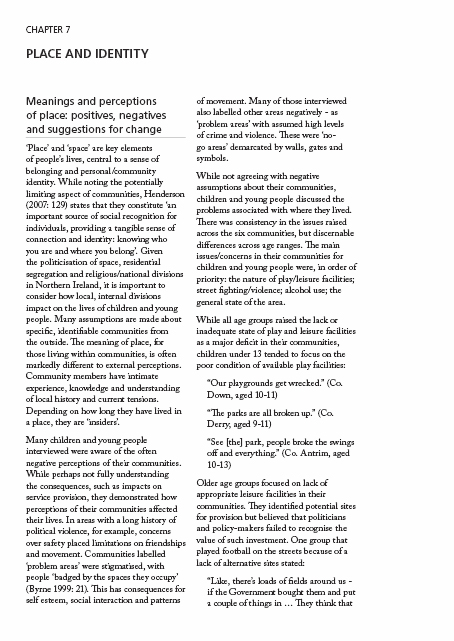

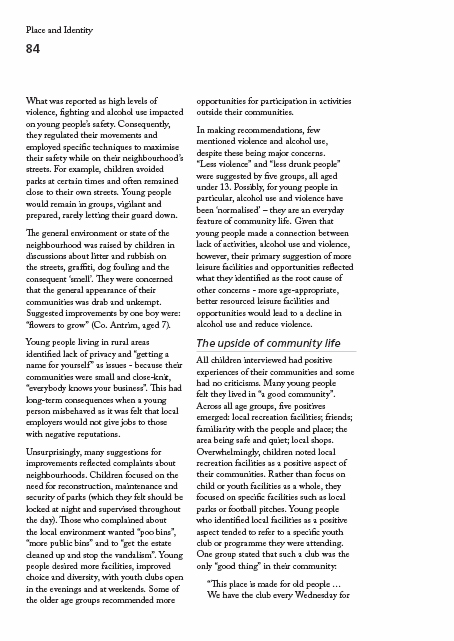

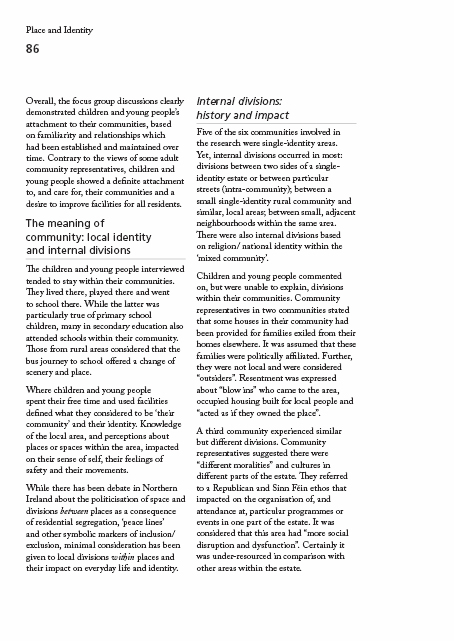

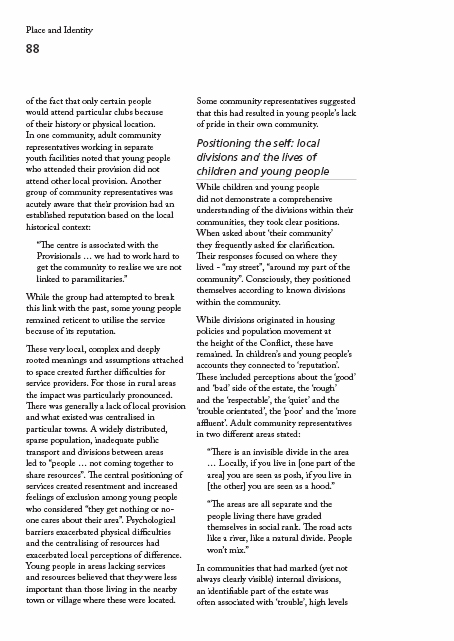


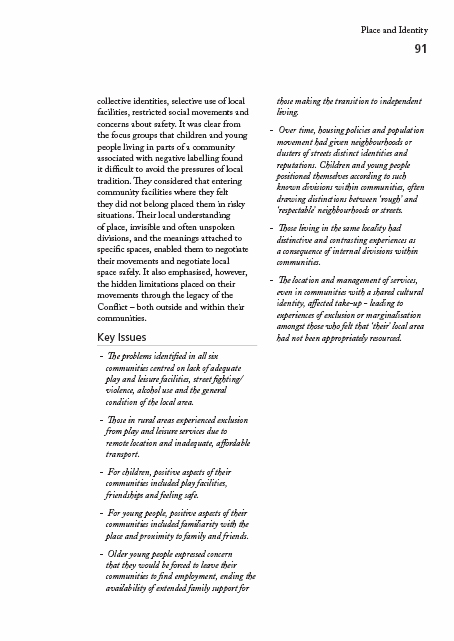
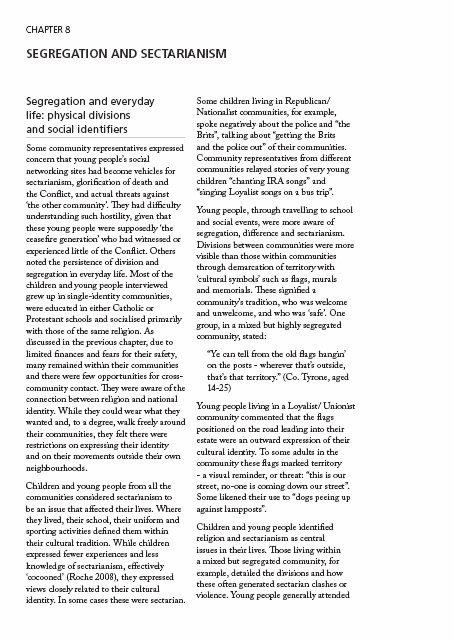
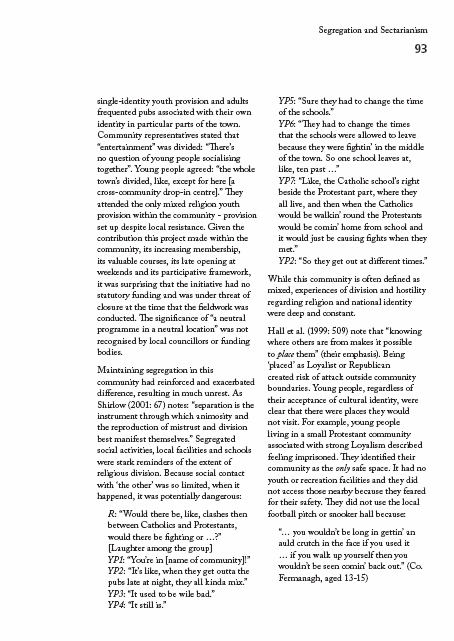

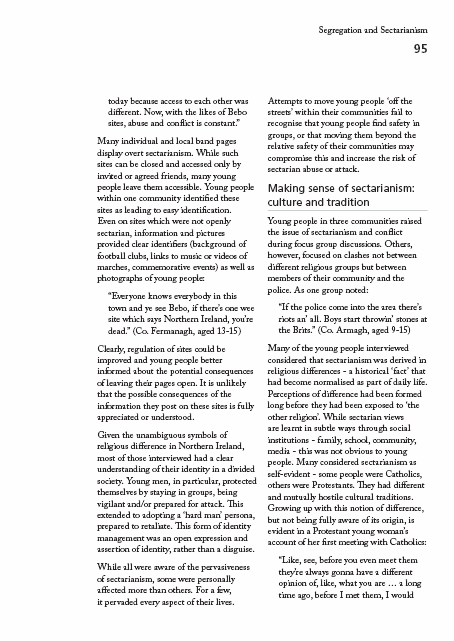



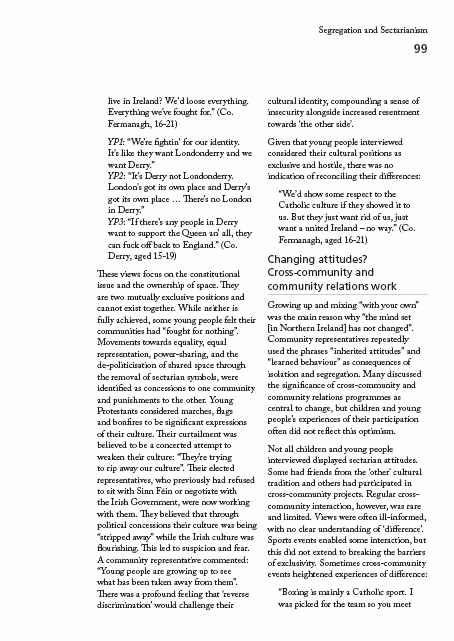




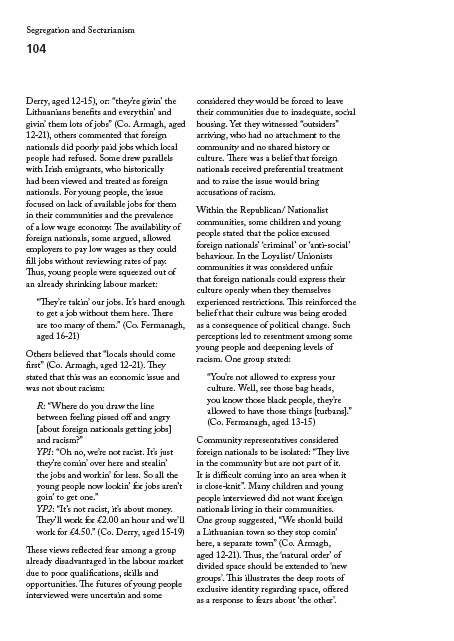
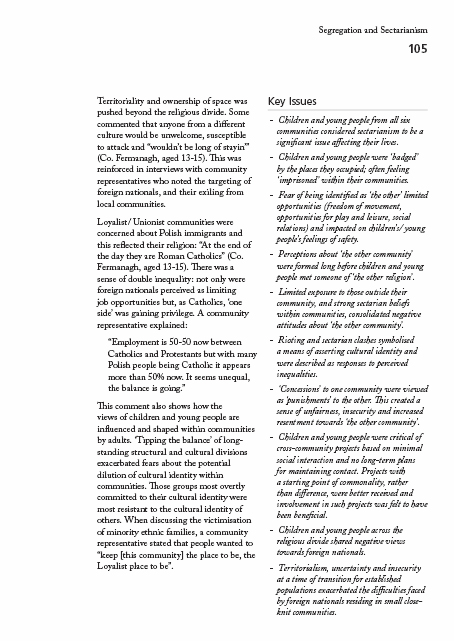
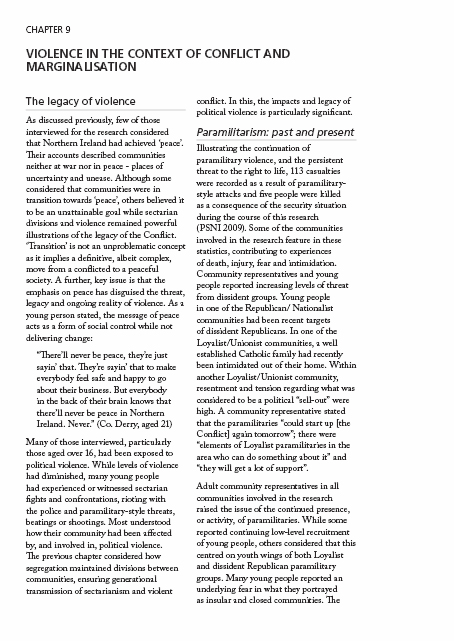






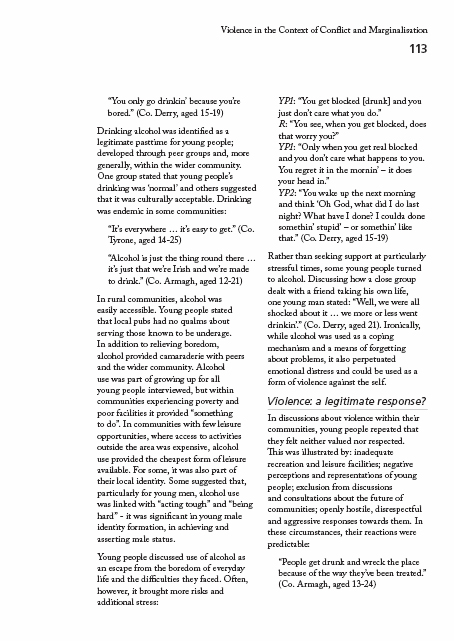

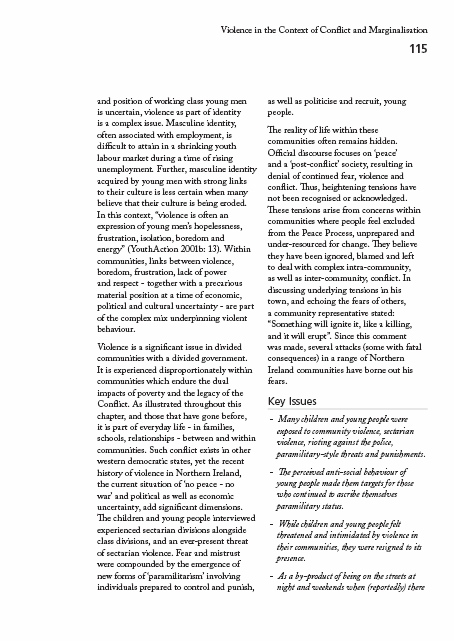









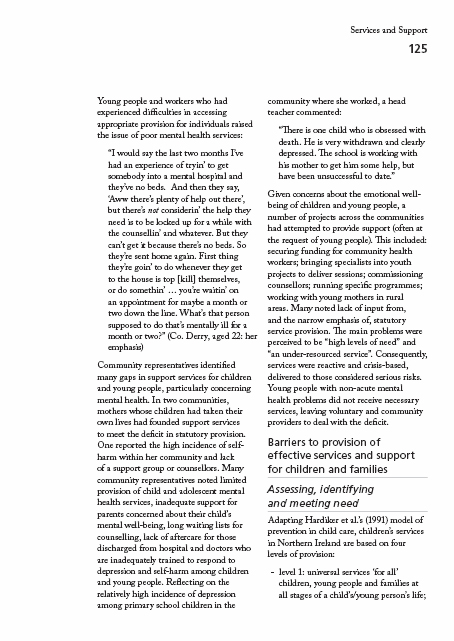



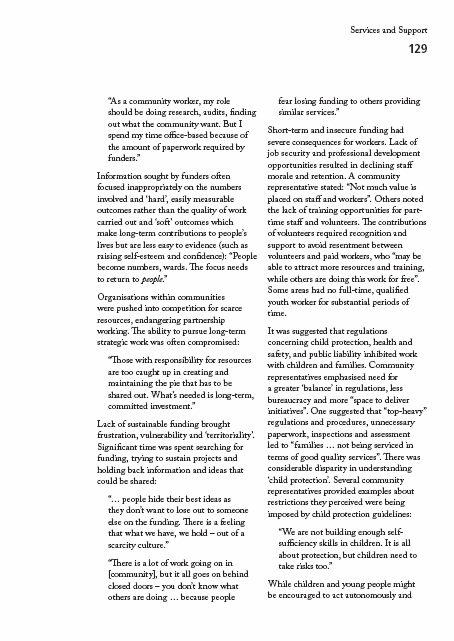

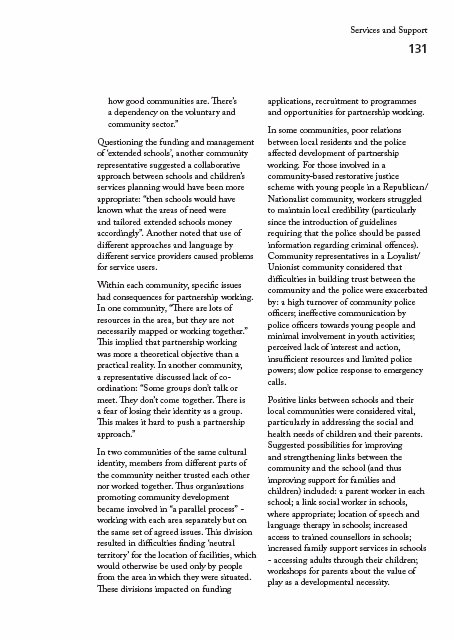

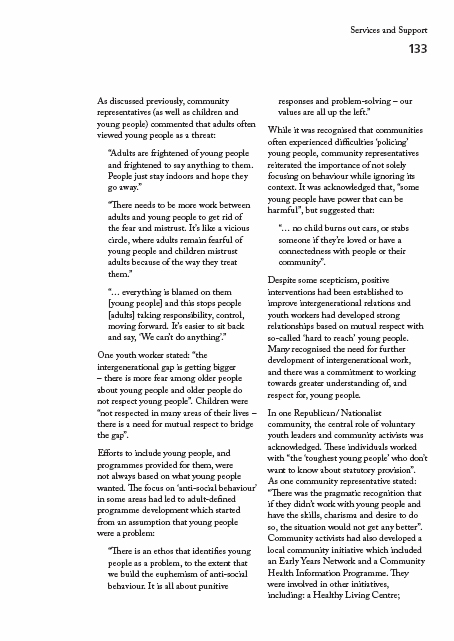
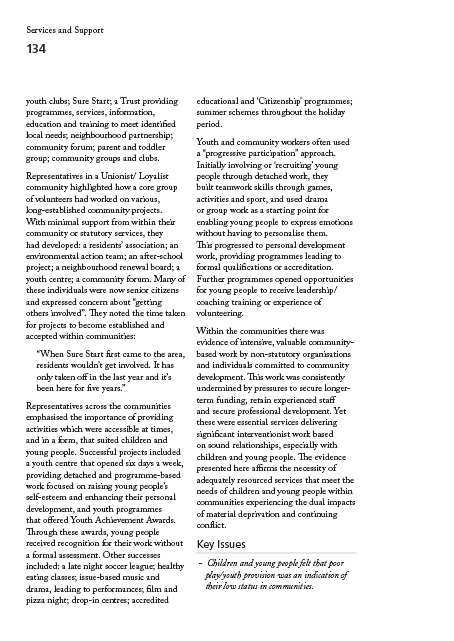
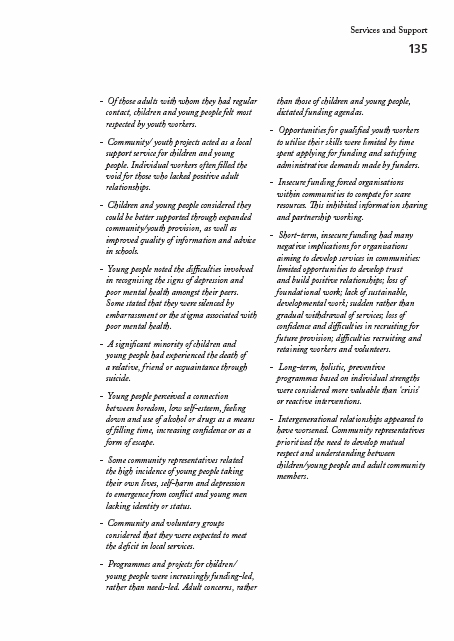








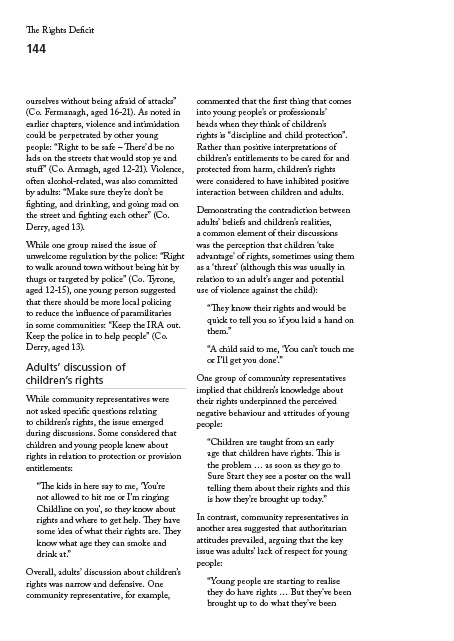
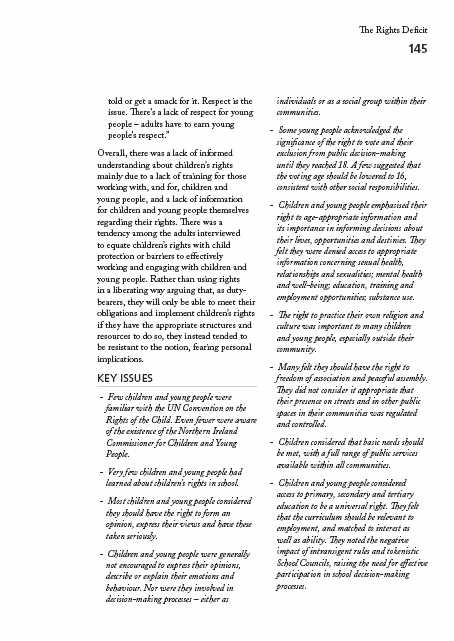



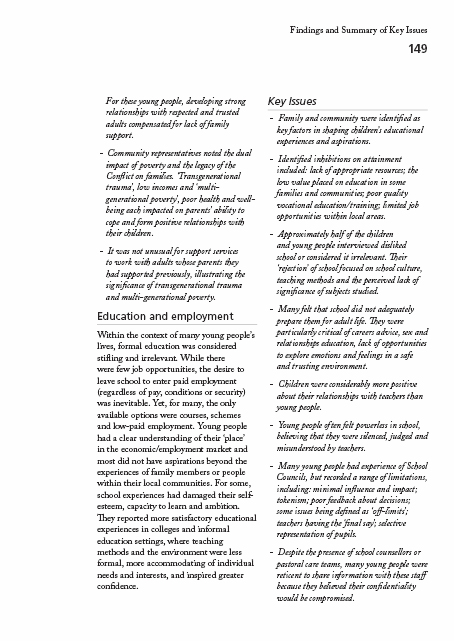

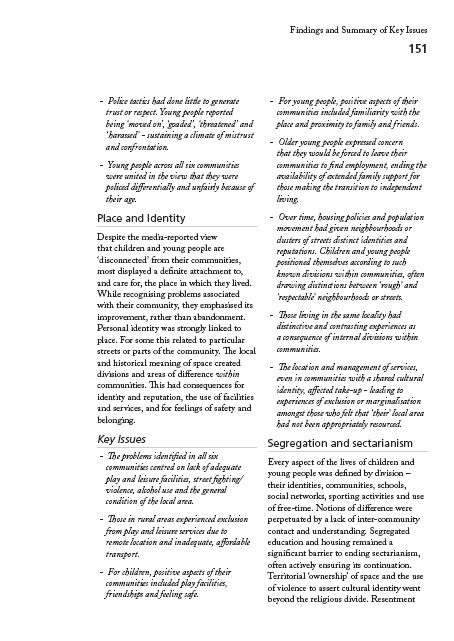
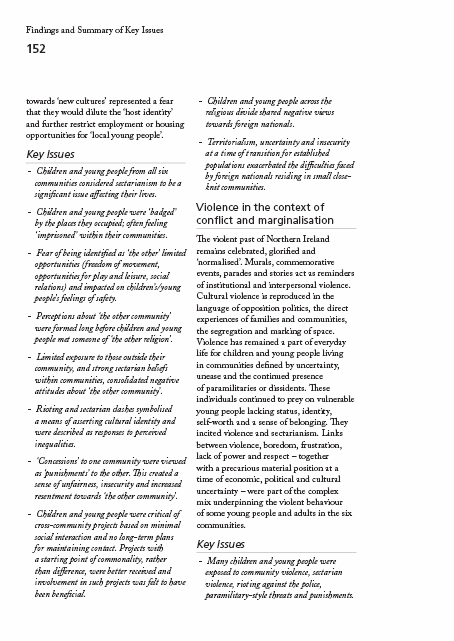
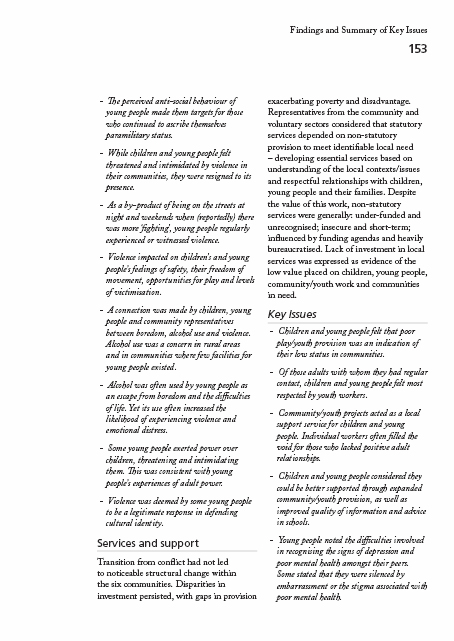
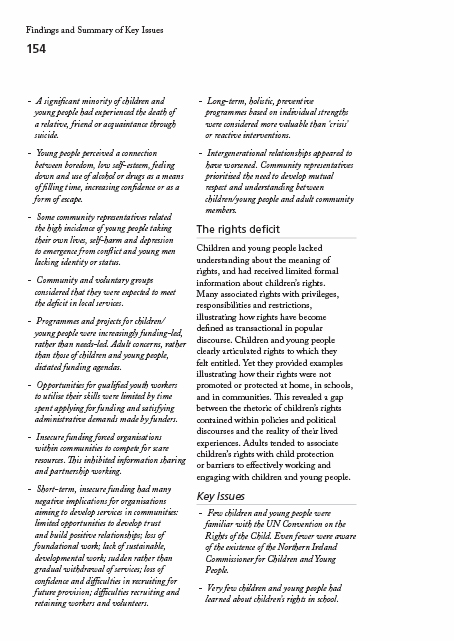

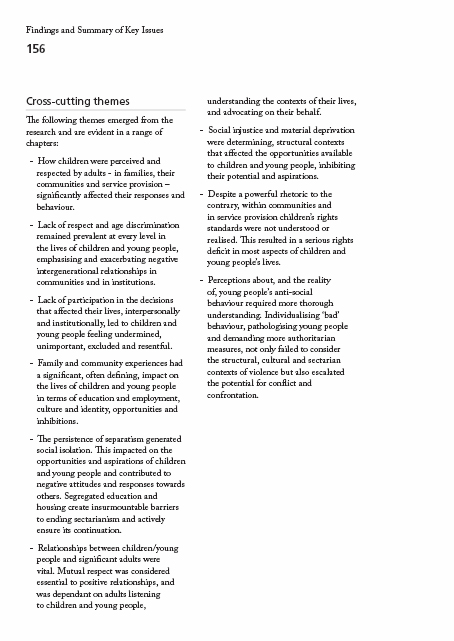
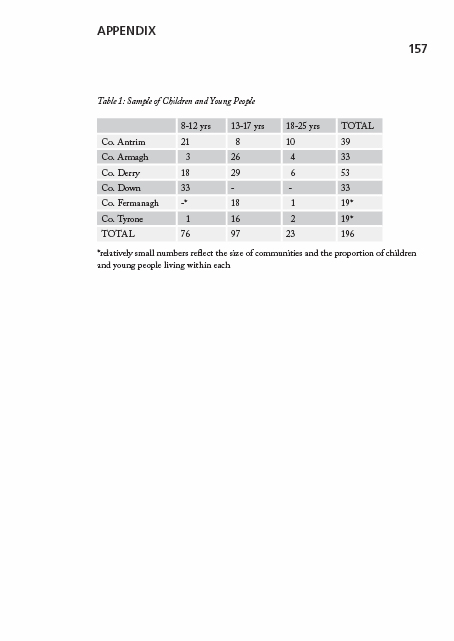
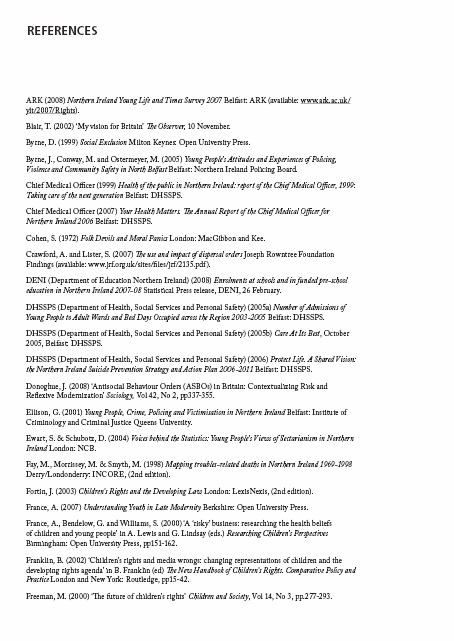






EU Commission
Brussels, 15.9.2010
COM(2010) 477 final
Communication from the Commission to the European Parliament, The Council, The European Economic and Social Committee and the Committee of the Regions
Youth on the Move
An initiative to unleash the potential of young people to achieve smart, sustainable and inclusive growth in the European Union
{SEC(2010) 1047}
An initiative to unleash the potential of young people to achieve smart, sustainable and inclusive growth in the European Union
1. Introduction
The Europe 2020 Strategy sets ambitious objectives for smart, inclusive and sustainable growth. Young people are essential to achieve this. Quality education and training, successful labour market integration and more mobility of young people are key to unleashing all young people's potential and achieving the Europe 2020 objectives.
Europe's future prosperity depends on its young people. There are close to 100 million in the EU, representing a fifth of its total population[1]. Despite the unprecedented opportunities which modern Europe offers, young people face challenges – aggravated by the economic crisis - in education and training systems and in accessing the labour market. Youth unemployment is unacceptably high at almost 21%[2]. In order to reach the 75% employment target for the population aged 20-64 years, the transition of young people to the labour market needs to be radically improved.
By 2020, it is estimated that 35% of all jobs will require high-level qualifications, combined with a capacity to adapt and innovate, compared to 29% today. This means 15 million more jobs requiring high-level qualifications[3]. An increasing number of jobs require e-skills, but the EU economy is hampered by a shortage of highly qualified ICT practitioners[4]. Fewer than one person in three in the EU (31.1%[5]) has a higher education degree compared to over 40% in the US and over 50% in Japan. The EU has a lower share of researchers in the labour force than its competitors[6]. The Europe 2020 Strategy has agreed the EU headline target that by 2020, at least 40% of 30-34 years olds should have completed tertiary or equivalent education.
Too many young people leave school early, increasing their risk of becoming unemployed or inactive, living in poverty and causing high economic and social costs. Currently, 14.4% of 18-24 years old in the EU have less than upper secondary education and are not in further education and training[7]. The EU benchmark is to reduce early school-leaving to 10%. Europe also has to do better on literacy – 24.1% of 15-year olds are low performers in reading literacy and this share has increased in recent years[8].
The implementation of national strategies for lifelong learning remains a challenge for many Member States, including developing more flexible learning pathways to allow people to move between different education levels and attract non-traditional learners.
1.1. Focus of the initiative
Youth on the Move is the EU's flagship initiative to respond to the challenges young people face and to help them succeed in the knowledge economy. It is a framework agenda announcing key new actions, reinforcing existing activities and ensuring the implementation of others at EU and national levels, while respecting the subsidiarity principle. Candidate countries should also be able to benefit from this initiative, through the appropriate mechanisms. It will harness the financial support of the relevant EU programmes on education, youth, and learning mobility, as well as the Structural Funds. All existing programmes will be reviewed to develop a more integrated approach to support the Youth on the Move initiative under the next Financial Framework. Youth on the Move will be implemented in close synergy with the "Agenda for New Skills and Jobs" flagship initiative, announced in Europe 2020.
Youth on the Move will focus on four main lines of action:
- Smart and inclusive growth depends on actions throughout the lifelong learning system, to develop key competences and quality learning outcomes, in line with labour market needs. Europe needs to extend and broaden learning opportunities for young people as a whole, including supporting the acquisition of skills through non-formal educational activities. Youth on the Move will support these actions, inter alia, by proposing a Council Recommendation to encourage Member States to tackle the high level of early school leaving, through the 2011 European Year of Volunteering and with a Council Recommendation on the validation of non-formal and informal learning. The Commission is also promoting apprenticeship-type vocational training and high quality traineeships as workplace learning experiences, building bridges to the labour market.
- Europe needs to raise the percentage of young people participating in higher education or equivalent to keep up with competitors in the knowledge-based economy and to foster innovation. It also needs to make European higher education more attractive and open to the rest of the world and to the challenges of globalisation, notably by promoting student and researcher mobility. Youth on the Move will seek to improve the quality, attractiveness and responsiveness of higher education and promote more and better mobility and employability, inter alia by proposing a new agenda for the reform and modernisation of higher education, including an initiative on benchmarking university performance and a new EU international strategy to promote the attractiveness of European higher education and to foster academic cooperation and exchanges with world partners.
- The EU's support for learning mobility through programmes and initiatives will be reviewed, expanded and linked up with national and regional resources. The international dimension will be reinforced. Youth on the Move will support the aspiration that by 2020 all young people in Europe should have the possibility to spend a part of their educational pathway abroad, including via workplace-based training. A Council Recommendation aimed at removing obstacles to mobility is proposed as part of the Youth on the Move package, accompanied by a 'Mobility Scoreboard' to measure Member States' progress in this regard. A dedicated website on Youth on the Move giving access to information on EU mobility and learning opportunities[9] will be set up and the Commission will propose a Youth on the Move card to facilitate mobility. The new intra-EU initiative "Your first EURES Job" will support young people to access employment opportunities and take up a job abroad, as well as encouraging employers to create job openings for young mobile workers. The Commission will also consider transforming the preparatory action "Erasmus for young entrepreneurs" into a programme to promote entrepreneurs' mobility.
- Europe must urgently improve the employment situation of young people. Youth on the Move presents a framework of policy priorities for action at national and EU level to reduce youth unemployment by facilitating the transition from school to work and reducing labour market segmentation. Particular focus is put on the role of Public Employment Services, encouraging a Youth Guarantee to ensure all young people are in a job, in education or in activation, creating a European Vacancy Monitor and supporting young entrepreneurs.
2. Developing Modern Education and Training Systems to Deliver Key Competences and Excellence
There is a need for better targeted, sustained and enhanced levels of investment in education and training to achieve high quality education and training, lifelong learning and skills development. The Commission encourages Member States to consolidate and, where necessary, expand investment, combined with strong efforts to ensure the best returns to public resources. In a climate of pressure on public funds, diversification of funding sources is also important.
In order to reduce early school leaving to 10%, as agreed under the EU 2020 Strategy, action should be taken early, focused on prevention and targeting pupils identified as being at risk of dropping-out. The Commission will propose a Council Recommendation to reinforce Member State action to reduce school drop-out rates. The Commission will also establish a High-Level expert Group to make recommendations on improving literacy and will present a Communication to strengthen early childhood education and care.
Young people are confronted with an increasing number of educational choices. They need to be enabled to take informed decisions. They need to get information about education and training paths, including a clear picture of job opportunities, to lay the basis for managing their career. Quality career guidance services and vocational orientation need to be further developed, with strong involvement of labour market institutions, supported by actions to improve the image of sectors and professions with employment potential.
High quality learning and teaching should be promoted at all levels of the education system. Key competences for the knowledge economy and society, such as learning to learn, communication in foreign languages, entrepreneurial skills and the ability to fully exploit the potential of ICT, e-learning and numeracy[10], have become ever more important[11]. The Commission will present a Communication on competences supporting lifelong learning in 2011, including proposals to develop a common language between the world of education and the world of work[12].
The demand for qualifications is being driven upwards, including in low-skilled occupations. Projections foresee that around 50% of all jobs in 2020 will continue to depend on ediumlevel qualifications provided through vocational education and training (VET). The Commission has underlined in its 2010 Communication on European cooperation in VET[13] that it is vital for this sector to modernise. Priorities include ensuring that pathways and permeability between VET and higher education are facilitated, including through the development of national qualifications frameworks, and maintaining close partnerships with the business sector.
Early workplace experience is essential for young people to develop the skills and competences required at work[14]. Learning at the workplace in apprenticeship-type training is a powerful tool for integrating young people gradually into the labour market. The provision and quality of apprenticeship-type training greatly varies among Member States. Some countries have recently started to set up such training schemes. The involvement of Social Partners in their design, organisation, delivery and funding is important for their efficiency and labour market relevance. These actions should be further pursued in order to increase the skills base in vocational pathways, so that by the end of 2012 at least 5 million young people in Europe should be able to enrol in apprenticeship training (currently, the figure is estimated to be 4.2 million[15]).
Acquiring initial work experience through traineeships has gained importance for young people in recent years, allowing them to adjust to labour market demands. Some Member States have also set up work experience schemes in response to reduced job openings for young people. These schemes should be accessible to all, of high quality and with clear learning objectives and should not substitute regular jobs and probation periods.
Unemployment among graduates from different levels of education and training is increasingly a cause for concern. European systems have been slow to respond to the requirements of the knowledge society, failing to adapt curricula and programmes to the changing needs of the labour market. The Commission will propose an EU benchmark on employability in 2010 in response to the Council request of May 2009.
Youth on the Move should also aim to expand career and life-enhancing learning opportunities for young people with fewer opportunities and/or at risk of social exclusion. In particular, these young people should benefit from the expansion of opportunities for nonformal and informal learning and from strengthened provisions for the recognition and validation of such learning within national qualifications frameworks. This can help to open the doors to further learning on their part. The Commission will propose a Council Recommendation to facilitate the validation of this type of learning[16].
Key new actions:
- Propose a draft Council Recommendation on reducing Early School leaving (2010): The Recommendation will set out a framework of effective policy responses related to the different causes of high school drop-out rates. It will focus on pre-emptive, preventive as well as remedial measures.
- Launch a High Level Expert Group on Literacy (2010) to identify effective practice in Member States to improve reading literacy among pupils and adults and formulate appropriate recommendations.
- Raise the attractiveness, provision and quality of VET as an important contribution to the employability of young people and the reduction of early school leaving: The Commission, together with Member States and the social partners, will re-launch cooperation in the area of VET, at the end of 2010, and propose measures at national and European level.
- Propose a quality framework for traineeships, including addressing the legal and administrative obstacles to transnational placements. Support better access and participation in high quality traineeships, including by stimulating companies to offer traineeship places and be good host enterprises (e.g. through quality labels or awards), as well as through Social Partner arrangements and as part of a Corporate Social Responsibility (CSR) policy.
- Propose a draft Council Recommendation on the promotion and validation of non-formal and informal learning (2011) to step up Member State action to promote recognition of skills acquired through these learning activities.
3. Promoting the Attractiveness of Higher Education for The Knowledge Economy
Higher education is a major driver of economic competitiveness in the knowledge-driven economy, making high quality third-level education essential in achieving economic and social objectives. With an increasing number of jobs requiring high-level skills, more young people will need to enter and complete higher education in order for the EU to reach the Europe 2020 target of 40% attainment of higher education or equivalent. In addition, research should attract and retain more young people by providing attractive employment conditions. Realising these objectives will require a multi-faceted approach, aiming at modernising higher education, ensuring quality, excellence and transparency and stimulating partnerships in a globalised world.
Some European universities are amongst the best in the world, but are hampered in realising their full potential. Higher education has suffered a long period of under-investment, alongside major expansion in student numbers. The Commission reiterates that for a modern and well-performing university system, a total investment of 2% of GDP (public and private funding combined), is the minimum required for knowledge-intensive economies.[17] Universities should be empowered to diversify their income and take greater responsibility for their long-term financial sustainability. Member States need to step up efforts to modernise higher education[18] in the areas of curricula, governance and funding, by implementing the priorities agreed in the context of the Bologna process, supporting a new agenda for cooperation and reform at EU level and focusing on the new challenges in the context of the Europe 2020 Strategy.
Maintaining a high level of quality is crucial for the attractiveness of higher education. Quality assurance in higher education needs to be reinforced at European level, by supporting cooperation among stakeholders and institutions. The Commission will monitor progress and set out priorities in this field in a report to be adopted in 2012, in response to a Recommendation of the European Parliament and of the Council[19].
In a more global and mobile world, transparency regarding performance of higher education institutions can stimulate both competition and cooperation and be an incentive for further improvements and modernisation. However, existing international rankings can give an incomplete picture of the performance of universities, over-emphasising research, while excluding other key factors that make universities successful, such as teaching quality, innovation, regional involvement and internationalisation. The Commission will present in 2011 the results of a feasibility study to develop an alternative multi-dimensional global university ranking system, which takes into account the diversity of higher education institutions.
Europe's innovation capacity will require knowledge partnerships and stronger links between education, research and innovation (the 'knowledge triangle'). This includes fully exploiting the role of the European Institute of Innovation and Technology (EIT) and the Marie Curie Actions, while drawing out the lessons learned in both. In this context, the Commission will reinforce and extend the activities of the European platform for dialogue between universities and business (EU Forum for University Business Dialogue), with a view to increasing the employability of students and to developing the role of education in the 'knowledge triangle'.
Higher education is becoming increasingly internationalised. More mobility, international openness and transparency are needed to attract the best students, teachers and researchers, to create and reinforce partnerships and academic cooperation with universities from other parts of the world. This will require a specific emphasis on reinforcing international cooperation, programmes and policy dialogue in higher education. A Communication setting out the key challenges and actions needed for higher education in Europe in a 2020 perspective will be presented in 2011, including an EU internationalisation strategy[20].
Key new actions:
- Support the reform and modernisation of higher education, by presenting a Communication (2011), which will set out a new reinforced agenda for higher education: This will focus on strengthening the employability of graduates, encouraging mobility, including between academia and industry, promoting transparent and high quality information on study and research possibilities and the performance of institutions. It will also focus on opening up opportunities to non-traditional learners and facilitating access for disadvantaged groups, including through adequate financing. The reinforced agenda will also propose an EU internationalisation strategy, promoting the attractiveness of European higher education.
- Benchmark higher education performance and educational outcomes: The Commission will present the results of a feasibility study in 2011, to develop a multi-dimensional global university ranking system, taking into account the diversity of higher education institutions.
- Propose a multiannual Strategic Innovation Agenda (2011), defining the role of the EIT in Europe's multi-polar innovation context and laying down priorities for higher education, research, innovation and entrepreneurship over the next seven years.
4. Supporting A Strong Development of Transnational Learning and Employment Mobility for Young People
While mobility among the overall population in the EU is not particularly high, studying and working abroad is particularly attractive for young people. The majority of 'mobile' people in the EU are between 25 and 34 years old. This age group tends to have better knowledge of languages and fewer family obligations. Increased mobility is also due to increasingly open borders and more comparable education systems. This trend should be supported by providing young people with access to more opportunities for enhancing skills or finding a job.
4.1. Promoting learning mobility
Learning mobility is an important way in which young people can strengthen their future employability and acquire new professional competences, while enhancing their development as active citizens. It helps them to access new knowledge and develop new linguistic and intercultural competences. Europeans who are mobile as young learners are more likely to be mobile as workers later in life. Employers recognise and value these benefits. Learning mobility has also played an important role in making education and training systems and institutions more open, more European and international, more accessible and more efficient[21]. The EU has a long and successful track record of supporting learning mobility through various programmes and initiatives, of which the best known is the Erasmus programme[22]. Future schemes, such as the creation of the European Voluntary Humanitarian Aid Corps foreseen by the Lisbon Treaty, could also contribute to this process. Some Member States also use the Structural Funds, particularly the European Social Fund, for transnational learning and job mobility. Mobility and exchanges of higher education staff and students between European and extra-European universities is supported under the Erasmus Mundus and Tempus programmes.
The Commission's aim is to extend opportunities for learning mobility to all young people in Europe by 2020 by mobilising resources and removing obstacles to pursuing a learning experience abroad[23].
The Green paper on Learning Mobility (July 2009)[24] launched a public consultation on how best to tackle obstacles to mobility and open up more opportunities for learning abroad. This led to over 3,000 responses, including from national and regional Governments and other stakeholders[25]. These show a widespread wish to boost learning mobility in all parts of the education system (higher education, schools, vocational education and training), but also in non-formal and informal learning settings, such as volunteering. At the same time, the responses confirm that many obstacles to mobility remain. Therefore, in conjunction with this Communication, the Commission is proposing a Council Recommendation on Learning Mobility, as a basis for a new concerted campaign among Member States to finally remove obstacles to mobility. Monitoring of progress will be reflected in a 'Mobility Scoreboard', which will provide a comparative picture of how Member States are progressing in dismantling these barriers.
To improve understanding of the rights of students studying abroad, the Commission is publishing, alongside this Communication, guidance on relevant European Court of Justice rulings. This deals with issues such as access to educational institutions, recognition of diplomas and portability of grants, to help public authorities, stakeholders and students understand the implications of established case law.
The "Bologna" Ministers for Higher Education, representing 46 countries, set a benchmark in 2009 that at least 20% of those graduating in the European Higher Education Area should have had a study or training period abroad by 2020[26]. In response to the Council request of May 2009, the Commission will propose in 2010 EU benchmarks on learning mobility, focusing in particular on students in higher education and VET.
European instruments and tools to facilitate mobility, such as European Credit Transfer and Accumulation System (ECTS), the European Qualifications Framework for lifelong learning (EQF) and Europass, should be fully implemented in order to provide their full benefit for mobile learners[27]. Virtual mobility, through the use of ICT and e-learning, should be promoted to complement physical mobility. The Commission will develop existing Europass elements into a European skills passport, to increase transparency and transfer of competences acquired through both formal and non-formal learning across the European Union. In this context, it will develop tools to identify and recognise competences of ICT practitioners and users, including a European Framework for ICT Professionalism in line with the EU e-skills strategy[28]. The Commission will also seek to develop a Youth on the Move card to speed up the integration process for mobile learners when moving abroad and provide other advantages in line with national youth or student cards.
EU funding supports student, researcher, youth and volunteer mobility through a number of programmes, although the number of young people who are able to benefit from these remains relatively small at around 380,000 per annum. The Commission will improve the efficiency and functioning of these programmes and promote an integrated approach to support Youth on the Move under the next Financial Framework.
Key new actions:
- Set up a dedicated Youth on the Move website for information on EU learning and mobility opportunities (2010): This website should give full transparency to all relevant EU programmes, opportunities and rights related to learning mobility for young people, and be progressively developed, e.g. linking EU actions to national and regional initiatives, providing information about funding possibilities, education and training programmes across Europe (taking account of ongoing work on transparency tools and the existing PLOTEUS portal), listing quality enterprises providing traineeships and similar.
- Propose a draft Council Recommendation on promoting the learning mobility of young people (2010), addressing obstacles to learning mobility at national, European and international level. This builds on the feedback from the 2009 public consultation on the Green Paper "Promoting the learning mobility of young people". Through regular monitoring, a "Mobility Scoreboard" will benchmark and measure progress in removing these obstacles in the Member States.
- Develop a Youth on the Move card to facilitate mobility for all young people (i.e. students, pupils, apprentices, trainees, researchers and volunteers), helping to make the integration process of mobile learners smoother.
- Publish guidance on the European Court of Justice rulings on the rights of mobile students (2010): This covers issues such as access, recognition and portability of grants.
- Propose a European Skills Passport (2011), based on existing elements of Europass, to record in a transparent and comparable way the competences acquired by people throughout their lives in a variety of learning settings, including e-skills and informal and non-formal learning. This should facilitate mobility by easing the recognition of skills across countries.
4.2. Promoting employment mobility
As underlined most recently in the Monti report[29], even in the economic downturn, jobs remain unfilled in the EU. This is partly due to a lack of labour mobility within the Union. However, a majority of Europeans (60%) think that people moving within the EU is a good thing for European integration, 50% think it is a good thing for the labour market and 47% think it is a good thing for the economy[30].
Working abroad is particularly attractive for young people. Yet there are still many obstacles that, in practice, hinder free movement: these need to be removed to make it easier for young workers to move and work within the Union and acquire new skills and competences. Young people are often willing to work abroad, but do not take up job opportunities in other countries because they are not aware of them, and because of the costs of moving. Advice and financial support to cover the relocation costs of young job applicants in the new country, as well as some of the integration costs usually borne by the employer, could contribute to better matching labour supply with labour demand, while giving young workers valuable experiences and skills.
Young labour market newcomers and businesses often do not connect easily, and Public Employment Services (PES) do not always offer services suited to young people and do not engage companies enough in recruiting young people all over Europe. EURES and the employment opportunities it offers are not fully exploited by the PES, even if 12% of Europeans know about it and 2% have actually used it[31].
Facing future labour shortages, Europe needs to retain as many highly skilled workers as possible and also attract the right skills for the expected increase in labour demands. Special efforts will be needed to attract highly skilled migrants in the global competition for talent. A wide range of aspects beyond traditional employment policy contribute to the relative attractiveness of a work location. As certain professions see too many Europeans emigrating and too few third country immigrants coming in, policies should address this. This includes raising awareness of citizens' rights when moving within the EU, in particular in the field of social security coordination and free movement of workers, simplified procedures for social security coordination taking into account new mobility patterns, reducing obstacles to free movement of workers (e.g. access to jobs in the public sector), improving information to young people about professions in demand, raising the attractiveness of jobs in professions which see brain-drain (e.g. scientific and medical professions) and identifying within the New Skills and Jobs initiative those occupations with shortages to which young talent within and outside the EU should be attracted.
Key new actions:
- Develop a new initiative: "Your first EURES job", as a pilot project (subject to it receiving the required financial support by the budgetary authority) to help young people with finding a job in any of the EU-27 Member States and moving abroad. Looking for a job abroad should be as easy as searching in one's own country: "Your first EURES job" will provide advisory, job search, recruitment and financial support to both young jobseekers willing to work abroad and companies (in particular SMEs) recruiting young European mobile workers and providing a comprehensive integration programme for the newcomer(s). This new mobility instrument should be managed by EURES, the European job mobility network of Public Employment Services.
- Create in 2010 a "European Vacancy Monitor", to show young people and employment advisers where the jobs are in Europe and which skills are needed. The European Vacancy Monitor will improve transparency and information on available jobs for young jobseekers by developing an intelligence system on labour and skills demand all over Europe.
- Monitor the application of the EU legislation on freedom of workers, to ensure that incentive measures in Member States for young workers, including in vocational training, are also accessible to mobile young workers, and identify, in 2010, areas for action to promote youth mobility with Member States in the Technical Committee on the free movement of workers.
5. A Framework for Youth Employment
While all Member States have youth employment policies in place, and many have taken additional action during the crisis - often with close involvement of the Social Partners -, much still needs to be done[32], [33]. Measures for reducing high youth unemployment and raising youth employment rates in times of tight public budgets must be efficient in the short term and sustainable in the longer term to address the challenge of demographic change. They should cover in an integrated manner the sequence of steps for young people in the transition from education into work and ensure safety nets for those who risk dropping out from education and employment. The existing EU legislation to protect young people at work must be implemented fully and adequately[34].
Evidence shows that robust policy coordination at European level within the common principles for flexicurity can make a real difference for young people. Together with stakeholders including Public Employment Services (PES), Social Partners, and NGOs, specific EU and national endeavours are needed. They should be based on the following priority actions to reduce youth unemployment and improve youth job prospects. The priorities for action should be seen as a contribution towards the employment target of 75% set out in Europe 2020.
The lack of decent job opportunities for young people is a widespread challenge throughout the global economy. Raising youth employment in our partner countries and notably in the EU's Neighbourhood will not only benefit them, but also have a positive impact for the EU. Youth employment has come even further to the fore of the global political debate in response to the crisis and recovery, underlining a convergence of policy priorities and stimulating policy exchange. This was highlighted by the ILO Global Jobs Pact, recommendations from the G20 Employment and Labour Ministers, the G20 Global Training Strategy or the OECD Youth Forum.
5.1. Help to get the first job and start a career
After finishing secondary school, young people should either get a job or enter further education - and if not, they must receive appropriate support through active labour market or social measures, even if they are not entitled to benefits. This is important, particularly in Member States with few job openings, so that young people are not left behind at an early stage. A prerequisite is to ensure that young people have wider, earlier access to these measures, even if they are not registered as jobseekers. For young people with a migrant background or belonging to specific ethnic groups, more tailored measures may be needed to improve the progress made by this fast growing youth population, who often experience particular difficulties in starting their career.
Graduates from vocational pathways and from higher education also need support to move as quickly as possible into their first full-time job. Labour market institutions, especially Public Employment Services, have the expertise to inform young people about job opportunities, and to give them job search assistance – but they need to adapt their support to the specific needs of young people, particularly through partnerships with training and education institutions, social support and career guidance services, trade unions and employers, who can also offer this kind of support as part of their Corporate Social Responsibility (CSR) policy.
Employers, when offered a choice between an experienced worker and a novice, will often prefer the former. Wage arrangements and non-wage labour costs can provide an incentive to employ new entrants, but should not contribute to precariousness. Collective bargaining can also play a positive role in setting agreed differentiated entry wages. Such measures should also be complemented by secondary benefits and access to training to help young people remain in a job.
Young workers are very often hired via temporary contracts, which may allow firms to test skills and productivity of workers before offering them an open-ended job. However, too often, temporary contracts are just a cheaper alternative to permanent ones, particularly in countries where the gap in dismissal regulations between these contracts is high (i.e. severance pay, notice periods, possibility to appeal to courts): then the result is a segmented labour market, where many young workers experience a sequence of temporary jobs alternating with unemployment, with little chance of moving to a more stable, open-ended contract and incomplete contributions to pension provisions. Young women are particularly at risk of falling into this segmentation trap. The successive use of such contracts should be limited, since its is bad for growth, productivity and competitiveness[35]: it has long-lasting negative effects on human capital accumulation and earnings capacity, as young temporary workers tend to receive lower wages and less training. Possible ways to tackle this are to introduce fiscal incentives to firms using permanent contracts or for the conversion of temporary contracts into permanent ones. In order to shed further light on this particular context, the Commission will present in 2010 a comprehensive analysis of factors affecting the labour market outcomes for young people and the risks of labour market segmentation affecting young people.
5.2. Support youth at risk
Indicators for youth labour market performance do not fully capture the fact that an astonishing 15% of European 20-24 year olds are disengaged from both work and education (NEET youth: neither in employment, education or training) and risk being permanently excluded from the labour market and dependent on benefits. It is essential, as a first priority, to tackle this problem, to provide suitable pathways for these young people to get back into education and training if needed or to bring them in contact with the labour market. Every effort should also be made to ensure as many young people with disabilities or health problems as possible are in work, to minimise risks of future inactivity and social exclusion. Public Employment Services are crucial to boost and coordinate such efforts. One option is to develop partnerships and agreements with employers who are offered special support for recruitment of youth at risk.
5.3. Provide adequate social safety nets for young people
Active inclusion of young people, with particular focus on the most vulnerable groups, requires a combination of adequate income support, inclusive labour markets and access to quality services[36]. Many unemployed young people, especially if they have never worked, have no access to unemployment benefits or other income support. To address this problem, access to social benefits, where appropriate, should be ensured, and where necessary, expanded to provide income security, while, at the same time, effective and efficient activation measures and conditionality should ensure that benefits are only awarded if the young person is engaged in active job search or in further education or training. This is of key importance to avoid benefit traps. Modernisation of social security systems should address the precarious situation of young people.
A growing number of young people are being moved onto (permanent) disability benefits. While some may not be able to work fully, even with suitably adapted workplaces, others could find a way back to the labour market through well designed activation policies.
5.4. Support young entrepreneurs and self-employment
A life-time job with the same employer is certainly not going to be the norm: most workers will change companies several times, and most current and future jobs are in SMEs and micro-enterprises. In addition, self-employment is an important driver of entrepreneurship and can thus significantly contribute to job creation, especially in the services sector.
Self-employment offers a valuable opportunity for young people to make use of their skills and shape their own job. It is also an option to be considered seriously by those helping young people to plan their career paths. The interest and potential of young people to become entrepreneurs needs to be strongly encouraged by fostering entrepreneurial mindsets and attitudes in education and training. This should be supported by the public and private sectors. To this end, young people need more opportunities to have entrepreneurial experiences, to receive support and guidance on business plans, access to start-up capital and coaching within the starting period. Here also, Public Employment Services have an important role, in informing and advising young jobseekers about entrepreneurship and self-employment opportunities.
Key new actions:
The Commission will:
- In order to address public spending constraints, work with Member States to identify the most effective support measures, including job placement, training programmes, recruitment subsidies and wage arrangements, security measures and benefits combined with activation and propose adequate follow-up actions.
- Establish a systematic monitoring of the situation of young people not in employment, education or training (NEETs) on the basis of EU-wide comparable data, as a support to policy development and mutual learning in this field.
- Establish, with the support of the PROGRESS programme, a new Mutual Learning Programme for European Public Employment Services (2010), to help them reach out to young people and extend specialised services for them. This programme will identify core elements of good practices in Public Employment Services and support their transferability.
- Strengthen bilateral and regional policy dialogue on youth employment with the EU's strategic partners and the European Neighbourhood, and within international fora, particularly the ILO, OECD and G20.
- Encourage the greater use of support to potential young entrepreneurs via the new European Progress Micro-finance Facility[37]. The Facility increases the accessibility and availability of microfinance for those wanting to set up or further develop a business, but having difficulties in accessing the conventional credit market. In many Member States young micro-entrepreneurs who seek funding under the Micro-finance Facility will also benefit from guidance and coaching with the support of the ESF.
In the framework of Europe 2020 and the European Employment Strategy, Member States should focus on:
- Ensuring that all young people are in a job, further education or activation measures within four months of leaving school and providing this as a "Youth Guarantee". To this end, Member States are asked to identify and overcome the legal and administrative obstacles that might block access to these measures for young people who are inactive other than for reasons of education. This will often require extending the support of PES, using instruments adapted to the needs of young people.
- Offering a good balance between rights to benefits and targeted activation measures based upon mutual obligation, in order to avoid young people, especially the most vulnerable, falling outside any social protection system.
- In segmented labour markets, introducing an open-ended "single contract" with a sufficiently long probation period and a gradual increase of protection rights, access to training, life-long learning and career guidance for all employees. Introducing minimum incomes specifically for young people and positively differentiated non-wage costs to make permanent contracts for youngsters more attractive and tackle labour market segmentation, in line with common flexicurity principles.
6. Exploiting the Full Potential of EU Funding Programmes
Several existing programmes already support the Youth on the Move objectives. For education and training, the Lifelong Learning programme (including Erasmus, Leonardo da Vinci, Comenius and Grundtvig), Youth in Action, Erasmus Mundus, Tempus and Marie Curie Actions address specific target groups. Their objectives should be strengthened, rationalised and better used to support the Youth on the Move objectives.
Teachers, trainers, researchers and youth workers can act as mobility multipliers at different levels: persuading young people to participate in a mobility experience, preparing the participants, staying in contact with the host institution, organisation or enterprise. In the next generation of mobility programmes, the Commission will propose a greater focus on increasing mobility of multipliers, such as teachers and trainers, to act as advocates for mobility.
The Commission will examine the possibility to step up the promotion of entrepreneurship mobility for young people, in particular by increasing Erasmus work placement mobility, promoting entrepreneurship education in all levels of the education system and in the EIT, enhancing business participation in Marie Curie actions and by supporting the "Erasmus for young entrepreneurs" initiative.
These programmes alone, however, will not be able to cater for all demands. Hence, there is a need to link up funding from many sources and have wider engagement of public authorities, civil society, business and others in support of the Youth on the Move objectives, to achieve the critical mass required.
The European Social Fund (ESF) provides considerable help to young people. It is the main EU financial instrument to support youth employment, entrepreneurship and the learning mobility of young workers, to prevent school drop-out and raise skill levels. A third of the 10 million ESF beneficiaries supported each year are young people, and about 60% of the entire ESF budget of 75 billion euros for 2007-2013 plus national co-financing benefits young people. The ESF also significantly supports the reforms of Member States' education and training systems and participation in life long learning, contributing 20.7 billion euros.
Yet the potential of the ESF must be maximised, given the drastic deterioration in the situation of young people since the design of ESF programmes. To this end, the Commission will carry out a stock-taking of current ESF measures and then work with Member States to identify the key target measures and policy actions which should urgently receive ESF support. This will be done through the ESF reporting and the Europe 2020 multilateral surveillance. Awareness-raising must also be stepped up, so young people can make the most of the opportunities offered by the ESF.
The Commission will examine, together with the Member States and the regions, how to better support youth employment, educational opportunities and higher education infrastructure through other structural and cohesion funds, in particular the European Regional Development Fund. In addition, PROGRESS and the new European Micro-finance Facility will be exploited further, as should national and regional funding.
The Commission is also examining whether to create at EU level, in cooperation with the European Investment Bank, a student lending facility as a complement to Member State schemes. The availability of study loans for young people could be increased and contribute to more cross-border mobility in education, including the option for students to undertake an entire study programme abroad. Complementarity with the existing EU programmes on education and training should be ensured. A study is currently being carried out, with results expected in 2011.
The Commission has announced that it will propose measures, in its recently adopted Communication "A Digital Agenda for Europe"[38], for 'light and fast' access to EU research funds in ICT, making them more attractive to SMEs and young researchers.
A coordinated review of existing education and training programmes will be undertaken with a view to developing an integrated approach under the post-2013 Financial Framework underpinning the Youth on the Move strategy. The aim is to support wider learning and mobility opportunities for all young people in Europe, as well as supporting the modernisation of education and training systems and the development of the youth sector, in particular through transnational and international cooperation projects and networks. This would include the creation of education partnerships, capacity building actions, international policy dialogue and the promotion of Europe as an attractive study and research destination.
The Commission will launch a public consultation in September 2010, to allow all interested parties to express their views on the future education and learning programmes. It will present proposals in 2011.
In the next programming period, ESF support should be linked even more closely to the policy priorities of the Integrated Guidelines and the EU and national employment and education targets of Europe 2020.
Key new actions:
- Given the growing importance of the issue, the Commission and the Member States will examine ESF interventions and make a proposal to increase awareness of and maximise the potential of the ESF to support young people.
- Member States should ensure that ESF swiftly supports young people and the achievement of Europe 2020 targets. The Commission will identify good practices for the efficient use of money to enhance youth employment opportunities and inspire their application more widely in the Member States' programmes.
- Undertake a review of all relevant EU programmes fostering learning mobility and education, including via an open consultation of stakeholders, to be launched in September 2010, and make proposals in 2011 for the new Financial Framework.
- Examine the feasibility for the creation of an EU-level student loan facility, in cooperation with the EIB Group and other financial institutions, to reinforce transnational student mobility and improve young people's access to higher education, complementing Member State schemes. Results of a feasibility study are expected in 2011.
7. Monitoring and Reporting Arrangements
The Commission and the Member States should cooperate on the follow-up to the Youth on the Move initiative in the context of the follow-up to the Europe 2020 Strategy, the existing arrangements for the Strategic Framework for European cooperation in Education and Training ('ET 2020'), the European Employment Strategy and the EU Youth strategy[39]. The new Integrated Guidelines, especially the employment guidelines, are the framework for coordinated policy actions, most of which are the responsibility of Member States. The Commission will support Member States in the design and implementation of actions through funding and the open methods of coordination, notably through reinforced mutual learning and peer reviews with national governments, regional and local policy makers and other stakeholders and practitioners, as well as through regular monitoring of, and co-operation on, ESF programmes.
The actions announced in this Communication will be reviewed and updated over time, within the 2020 horizon.
8. Information Campaign
The Commission will launch an information campaign in 2010 to support the Youth on the Move initiative for the next decade. The campaign will include a specific Youth Employment awareness-raising and mobilisation action in 2011, directed at young citizens and labour market stakeholders in the Member States, to focus national and EU efforts on reversing youth unemployment trends and to encourage young people to take up opportunities. The campaign will actively involve national and regional authorities, the business sector, in particular SMEs, and other key stakeholders.
9. Conclusion
The Europe 2020 flagship initiative Youth on the Move puts young people at the centre of the EU's agenda to create an economy based on knowledge, research and innovation, high levels of education and skills in line with labour market needs, adaptability and creativity, inclusive labour markets and active participation in society. All these represent key components of Europe's future prosperity. Urgent action is needed from Member States and where relevant from candidate countries, at both national and regional levels, as well as the EU level, to address the challenges faced by young people outlined in this Communication and ensure that education and training systems, as well as labour market structures, are equipped for economic recovery and beyond. Given the global nature of these challenges for the EU, dialogue, exchanges and cooperation with the EU's external partners should be promoted.
This initiative counts on the support of other European institutions and on the active participation of all stakeholders to make it a success.
[1] Eurostat, 2009, 15-30 year olds.
[2] Eurostat, June 2010, < 25 y.
[3] CEDEFOP projections.
[4] eSkills Monitor study, European Commission, 2009.
[5] Eurostat, 2008, 30-34 year olds.
[6] MORE study, European Commission, 2010.
[7] Eurostat, 2009.
[8] OECD, PISA, 2006.
[9] Linking to existing PLOTEUS portal on learning opportunities. The Commission has also published on the 'Your Europe' portal, an 'education and youth' section containing information on rights and opportunities for students and young people in Europe.
[10] The Commission will in 2010 establish a thematic working group of policy-makers and experts from the Member States to examine the causes of low performance of school students in maths (including numeracy) and science.
[11] Recommendation of the European Parliament and of the Council of 18 December 2006 (OJ L 394, 30.12.2006).
[12] European Skills, Competencies and Occupations taxonomy (ESCO).
[13] COM(2010) 296.
[14] See own initiative European Parliament report by Ms E Turunen "Promoting youth access to the labour market, strengthening trainee, internship and apprenticeship status", June 2010.
[15] Report from the Working Group on Mobility for Apprentices, February 2010 (European Commission).
[16] Volunteering, participation, activities within youth organisations and youth work provide opportunities for learning outside formal structures. They can help reinforce other activities of Youth on the Move and engage young people otherwise at risk of being bypassed. The European Year of Volunteering 2011 will provide fresh impetus to develop these activities further.
[17] COM(2005) 15.
[18] COM(2006) 208.
[19] Recommendation of the European Parliament and of the Council of 15 February 2006 on further European cooperation in quality assurance in higher education (2006/143/EC) (OJ L 64, 4.3.2006).
[20] Council Conclusions on the internationalisation of higher education of 11 May 2010.
[21] See COM(2009) 329 for references to studies and research.
[22] They include the following: higher education (Erasmus, Erasmus Mundus, Marie Curie) for students, doctoral candidates and staff; higher education and research (Marie Curie, mobility within Networks of Excellence and Technology Platforms); from higher education to business (placements within Erasmus and Marie Curie); vocational education and apprentices (Leonardo); second level education (Comenius) adult learning and senior volunteering (Grundtvig); the cultural sphere (Culture Programme); youth exchanges and volunteering (Youth in Action); volunteering (European Voluntary Service within the Youth in Action Programme); the civil society (Europe for Citizens Programme) and the preparatory action "Erasmus for Young Entrepreneurs".
[23] http://ec.europa.eu/commission_2010-2014/president/about/political/index_en.htm
[24] COM(2009) 329.
[25] See Commission Staff Working Paper SEC(2010) 1047 for an analysis of the responses received.
[26] http://www.ond.vlaanderen.be/hogeronderwijs/bologna/conference/documents/Leuven_Louvain-la-Neuve_Communiqué_April_2009.pdf
[27] In particular, the European Qualifications Framework for Lifelong Learning (EQF), the Europass, the Diploma Supplement, the European Credit Transfer and Accumulation System (ECTS, for higher education), the European Credit System for Vocational Education and Training (ECVET) and Youthpass.
[28] Announced in the Digital Agenda - COM(2010) 245; "e-Skills for the 21st Century" COM(2007) 496.
[29] "A new strategy for the single market", report by M. Monti, 9 May 2010, p. 57.
[30] "Geographical and labour market mobility", Special Eurobarometer 337, June 2010.
[31] Special Eurobarometer 337, June 2010.
[32] Sources: Youth Employment Study (2008) providing an inventory of main policies in place for all EU-27 Member States. The Employment Committee report on youth employment (2010) gives an overview of recent measures enacted in Member States.
[33] OECD series of thematic reviews on Youth Employment in selected OECD countries (2008-2010)
[34] The Commission will soon present an analysis (through a staff working paper) of the application of Council Directive 94/33/EC of 22 June 1994 on the protection of young people at work.
[35] See Directive 1999/70/EC.
[36] Commission Recommendation on the active inclusion of people excluded from the labour market of 03.10.2008 (OJ L 307, 18.11.2008), endorsed by the Council on 17 December 2008 and by the European Parliament in its Resolution of 6 May 2009.
[37] www.ec.europa.eu/epmf
[38] COM(2010) 245.
[39] COM(2009) 200.
Department of Employment and Learning
Annex 1
A Scoping Study of those young people Not in Education, Employment or Training (NEET) in Northern Ireland
Contents
1. Introduction
2. Executive Summary
3. Data Sources and Available Information
4. Characteristics of Groups
5. Actions in England, Scotland, Wales, Republic of Ireland and Northern Ireland
6. Conclusions and Recommendations
Annex A – Identification and Characteristics of Groups – detailed information
Annex B – Further Detail on Actions in England, Scotland, Wales and RoI
Annex C – Further Detail on Actions in NI
Glossary of Terms and Acronyms
1. Introduction
1.1 This report outlines the findings of a scoping study of those young people not in Education, Employment or Training (NEET) in Northern Ireland. The report was commissioned following a debate held in the Northern Ireland Assembly in recognition of the issues faced by these young people and the implications of their disengagement for the economy and society as a whole. The aims of the study were to:
- Research further data on 16-19 year olds (this has subsequently been expanded to include data on 16-24 year olds where available) not in education, employment or training in Northern Ireland.
- Identify the relevant actions in place.
- Recommend whether a cross-departmental strategy could achieve better outcomes for the group in the future.
1.2 Before any decision can be made on the need for a specific overarching strategy for Northern Ireland it is important to understand two factors:
1. why does a young person disengage from education, employment or training and are there any triggers which can be identified early enough for some preventative measures to be effective; and
2. once disengaged, do all young people have the same aspirations which will lead them to respond in the same way to any measures introduced.
1.3 This scoping study aims to answer both these questions thereby informing any debate on a Preventative or Intervention Strategy in Northern Ireland. The report does not represent a strategy and it does not answer the questions which a strategy will need to address. What it does aim to do is illuminate this difficult area, to look at the data that is available and is not available within Northern Ireland and use this to identify the major characteristics within this diverse group in order to provide a strong foundation for future work.
1.4 The study also examined the policies and initiatives introduced by government and the voluntary and community sector to address the particular needs of the individual groups who are most prevalent in the NEET population. In Northern Ireland the poverty and social inclusion agenda and a wide and numerous range of actions by statutory and non-statutory authorities are in place and are designed to tackle the barriers which often lead to disengagement. In addition to the specific measures to address the needs of those who share specific characteristics, there is a significant number of policies and initiatives designed to encourage all young people to continue in education or to progress to training or employment. Much of this work is carried out by the Department for Employment and Learning (DEL).
1.5 The information presented in these sections was obtained through first hand interviews with departmental officials and representatives from the voluntary and community sector.
1.6 The report concludes with a section which draws the information together. The purpose of this section is to draw out the main issues raised in the report. The identification of these issues is the main output from the scoping study.
The report consists of 8 sections:
- Introduction
- Executive Summary
- Data Sources and available information
- Identification and characteristics of groups
- Actions in England, Scotland, Wales, the Republic of Ireland and Northern Ireland
- Conclusions and Recommendations
- Glossary of Terms
- Annexes containing further detailed information
2. Executive Summary
Data on Northern Ireland (Section 3)
2.1 The data sources in Northern Ireland are diverse with each providing different information on young people not in education, employment or training. The Labour Force Survey (LFS) gives us the overall NEET figure for both the 16-19 and 16-24 year old age group but the definitions are problematic as training is restricted to that which is government supported and education is restricted to full time.
2.2 Northern Ireland does not have a comprehensive data source such as the Client Caseload Information System which would allow the NI figures for young people not in education, employment or training to be disaggregated and characteristics to be identified or confirmed.
2.3 The latest LFS figures, however, show that for 16-19 year olds the figures for Northern Ireland stand at 13% or 13,000 (LFS 2010, Quarter 1). This compares with a rate of 15% for the UK. The latest LFS figures for 16-24 year olds show that the proportion not in employment, government training schemes or full time education (January- March 2010) stands at 18%, an increase of 1 percentage point on the figure for January -March 2009. The comparable LFS figure for the UK is 19% for 2010 (18% in 2009). Scotland and Wales in 2010 stand at 19% and 24% respectively.
2.4 From 2007 onwards, and particularly in the past year, youth unemployment levels have risen sharply in both NI and the UK as a whole. It is important to bear in mind that this situation has resulted from global and external economic factors and can illustrate that the significant numbers of young people who were not in education, employment or training prior to the recession were more a product of social, community and education factors, rather than the economic situation.
2.5 In England and Wales, key relevant data sources are the Client Caseload Information System, the Youth Cohort Study, research by the National Foundation for Education Research, and the Statistical First Release.
2.6 In general, young people who are not in education, employment or training can be divided into those with and without barriers to engagement. Statistical First Release figures from England and Wales split those 16- 18 year olds who are not in education, employment or training into three groups:
- Group 1 (Out of Scope) – young people who are doing some activity which is not formally counted as education, employment or training, gap year students and those undertaking voluntary work. It will also include those in custody (22%) (2,860)
- Group 2 (Identifiable Barrier) - young people who have an identifiable barrier to participation, such as they have a child or are experiencing serious illness or disability. Some of these individuals may be able to participate now, but others may require specific help to do so (23%) (2,990)
- Group 3 (No Identifiable Barrier) – Young people who are NEET but are not in either of the specific categories outlined above (55%) (7,150)
2.7 Applying these percentages to the 13,000 16-19 year olds which the Labour Force Survey records as not in education, employment or training in Northern Ireland (in quarter 1 of 2010), the number in Groups 2 and 3 would be 10,140 or about 10% of the total 16-19 age group.
2.8 Research by the National Foundation for Education Research (NFER) based on the Youth Cohort Study for England and Wales data on 1,637 individuals who left school in 2001 or 2003 followed the study group for 4 years after their initial entry to NEET and provides another segmentation of the NEET group into three distinct populations. This conclusion is supported by other research which identified 3 groups, termed:
- Transitional or Gap Year NEET (41%);
- Floating NEET (22%); and
- Core NEET (38%).
2.9 Any issues related to Transitional or Gap year NEET are the most easily addressed - these young people are classified as NEET but are in most cases waiting for a course to begin. They are highly qualified and are not engaged in education, employment or training by choice. The second group are the Floating NEET. This group could be described as NEET without substantive barriers. They have relatively good qualification levels but complain of a lack of suitable provision. The most difficult group to reach are the third group – the Core NEET group. These young people suffer from all the disadvantages discussed in the preceding sections. They have barriers to participation in some cases resulting from generations of disadvantage. Their individual problems can be addressed by individual initiatives and strategies but their compound problems remain.
Characteristics of Groups (Section 4)
2.10 Young people who are not in education, employment or training are far from a homogenous group. There is a wide spectrum of problems and the barriers they face can be multiple and compounded, often from their earliest years. These characteristics may make the already difficult transition from compulsory schooling to further education, employment and training even more problematic and therefore can result in the young person entering the NEET group.
2.11 The characteristics are not in any way mutually exclusive and in many cases a young person will experience several of them simultaneously. In addition to this, the relationship between individual factors is also complex.
2.12 Some of the factors identified are with the children from an early age and leave the young person needing additional support in order to get the best benefit from education and to make a successful transition to further education, training or employment. The groups most usually associated with NEET are Children and Young People:
- in care
- who have left care
- are on the edge of care
- who have had a negative experience of education
- who have suffered from bullying at school
- who have problems with literacy and numeracy
- who are carers
- who are parents
- who have experienced drug and alcohol abuse
- who have a physical disability/learning disability
- who have committed a crime
- who have a mental illness
- with economic disadvantage
- who are homeless
Actions in GB, the Republic of Ireland and Northern Ireland (Section 5)
2.13 NEET strategies for England, Scotland and Wales and the initiatives in the Republic of Ireland demonstrate a range of common characteristics. Strategies tend to divide into Preventative and Re-engagement or Intervention approaches, recognising the importance of early preventative intervention and additional support at an early age. The heterogeneous nature of the problem involves flexibility in response and its complex nature results in interdepartmental and agency communication and co-operation. Young people's transitional stages are key. Disengagement from society and the economy is in many cases linked to other factors of social exclusion and the identification of these factors is a starting point to finding solutions to this problem.
2.14 While Northern Ireland does not currently have an overarching strategy for NEET as such, a large number of strategies and initiatives have been developed to address aspects of social and economic exclusion. The successful achievement of the objectives in these strategies would in many cases have a positive impact on the proportion of young people who are not in education, employment or training.
Conclusions and Recommendations (Section 6)
Key points:
- The numbers of young people in Northern Ireland who are not in education, employment or training are, overall, no better or worse than elsewhere in the UK but overall numbers have increased.
- The cohort is the focus of strategic interest in other regions.
- The group is not homogenous and comprises young people with no barriers to participation and those who have barriers to participation.
- The barriers to participation are varied and inter-related and many young people are affected by multiple and compounded issues.
- These factors may extend back through generations.
- Actions to prevent or reduce the numbers of young people not in education, employment or training can be divided into Preventative and Intervention or Re-engagement. For preventative actions to be effective, intervention must be at an early enough stage.
- The scoping study is the result of an examination of NEET at a time of almost constant change, when a recession was having a deep, adverse impact on the numbers of young people who were unemployed;
- The danger points for young people are the transitional stages when one form of activity ends and a conscious decision needs to be made as to the next engagement.
- Much is being done by the statutory and voluntary sector to address these issues; including joint working between organisations
- There is potential to develop existing activities further to:
- improve data availability;
- build on joint working; and
- share and make use of good practice
Recommendations
2.15 Preparation of an overarching Strategy for NEET in Northern Ireland should be taken forward by a Cross-Departmental mechanism.
2.16 Account should be taken of the large amount of work which has already been undertaken by departments and the voluntary and community sector in respect of young people who at risk of disengaging or who are already not in education, employment or training.
2.17 Steps should be taken to further develop partnerships and joint working between departments with regard to young people not in education, employment or training.
Data Requirements for Northern Ireland
2.18 Consideration should be give to introducing a follow-up survey to supplement the existing school leavers survey. This would allow leavers to be tracked 6-9 months after they leave school.
2.19 Further information is needed in order to segment the group in Northern Ireland into the groups identified in England and Scotland.
2.20 The re-introduction of the Youth Cohort study in Northern Ireland should be supported.
2.21 Consideration should be give to introducing a method of tracking young people who are not in education, employment or training within Northern Ireland.
Establishment of a target for reducing the Number of NEET
2.22 Baseline data needs to be established before Targets are set.
2.23 Rather than focusing on a reduction in the number not in education, employment or training, targets could instead relate to the numbers of young people who receive support and the nature of the intervention, for example the provision of personal action plans for those with the most challenging barriers to engagement.
2.24 Any target setting should be carried out within some type of scenario analysis which would take account of the external economic factors which are likely to have an effect on the numbers of young people not in education, employment or training.
2.25 Any overall target for reducing the number of young people not in education, employment or training would need to take account of existing targets for individual groups such as the targets in relation to children in care.
Good Practice.
2.26 A cross-departmental multi-agency approach is needed to address the compound problems faced by those who are not in education, employment or training, or who are at risk of disengaging.
2.27 Problems faced by these young people should be addressed in a holistic way and family support options should be explored
3. Data Sources
Data on Northern Ireland
3.1 In order to determine what action can or should be taken to address the barriers to participation of the NEET group, it is necessary to scope the overall number of young people who fall into this group. In addition it is important to determine whether or not this is a homogenous group or whether it is made up of a number of different subgroups. In most cases a subgroup is identified by a common characteristic which leads to details being recorded. Those in education are enrolled and those in training are registered. The group by its very nature is not engaged hence the gathering of statistics is made more problematical.
3.2 The findings of the scoping study do, however, indicate that this is far from a homogenous group and indeed that within the group there is a wide spectrum of need, from those young people who are simply in a gap between planned periods of engagement in education, employment or training for timing reasons or through choice, to those young people who have very substantial personal, social or economic barriers to engagement and fulfilling their potential.
3.3 Young people represent a major resource for the Northern Ireland economy. The 16-19 age band currently represents 6% (or 101,000) of the Northern Ireland population (1,775,000).
3.4 As the study developed the emphasis on age bands altered. The initial focus was on the 16-19 age band. This has now widened in the UK and as far as possible this study also follows this development. In the UK for example under, 'Inspiring Potential', the Department of Children, Schools and Families (DCSF) strategy to increase the proportion of young people who are participating in education, employment or training) the age band considered is 16-24.
3.5 'Inspiring Potential' goes on to set out the key steps being taken to support young people at each stage of their development as:
3.6 Pre-16 - Early intervention and support for young people at risk of disengaging, and for their families, to keep them on the path to success;
3.7 At age 16-18 - Full participation in education and training, including work with training, so that young people gain the skills and qualifications they need to progress;
3.8 At transition - Young people make a successful transition into further education, higher education or work and receive the support they need from a range of youth and adult services to enable them to do this;
3.9 At age 18-24 - All young people get the skills they need to succeed in a competitive, high skilled labour market and make a successful start in employment.
3.10 Research indicates that while there is considerable movement in and out of the group, some young people will be disengaged from education, employment or training for a considerable period of their working life and may remain so at a significant cost to the economy. This represents a great waste of young people's potential and contribution to society. Reducing the proportion of young people in this category therefore needs to be both an economic and social priority for any region.
The Labour Force Survey
3.11 In terms of government statistics the Department of Enterprise, Trade and Investment (DETI) collects, via the Labour Force Survey (LFS), statistics on those not in Employment, Full time Education or Training. This includes only those who are not in full-time education, and training is restricted to government training.
3.12 It is important to recognise that the definition of not in employment, education or training which is used in the LFS reduces significantly the numbers judged as being active and thus potentially leads to a higher figure.
3.13 LFS figures are also based on a sample survey of adults in Northern Ireland, with typically about 240-300 16-19 year olds in the sample each quarter. Given the small sample size it is not possible to disaggregate this figure, e.g. to further break down the ages of those who are not in education, employment or training, divide by gender or identify geographical pockets. LFS does, however, give the only total NEET figure available for Northern Ireland.
3.14 The LFS in Northern Ireland mirrors the survey in Great Britain, thus the latest 2010 'NEET' figure of 15% of 16-19 year olds (or 464,000) for the UK is quoted as comparable to the 13% (or 13,000) for Northern Ireland.
3.15 It is worth noting, however, that England does not use only the LFS to estimate the numbers of young people who are not in education, employment or training. The Office for National Statistics (ONS) produces NEET estimates for England and Wales, using a combination of population estimates, LFS figures and administrative data gained from the Client Caseload Information System (CCIS) (discussed later in this section). The estimates they produce refer to young people who are not in education, employment or training, with the administrative data providing the majority of the latter estimate.
Table A - Percentage of 16-19 year olds not in Full-time education, Government supported Training or Employment
| % | |||||
| 16 – 19 | NI | England | Wales | Scotland | UK |
| Oct–Dec 2008 | 14 | 15 | 15 | 12 | 14 |
| Jan-Mar 2009 | 13 | 14 | 14 | 14 | 14 |
| Apr-Jun 2009 | 15 | 16 | 15 | 16 | 16 |
| Jul-Sep 2009 | 15 | 18 | 17 | 18 | 18 |
| Oct-Dec 2009 | 11 | 14 | 16 | 16 | 14 |
| Jan- Mar 2010 | 13 | 14 | 16 | 20 | 15 |
3.16 This figure includes all of those who are not in full time education, government supported training or employment. As indicated earlier, while some of these young people face serious barriers to re-engagement, others may not be in education, employment or training by choice and may be in a period of transition between activities. An example would be a gap year student. The different categories within the group of young people not in education, employment or training are discussed later in this section but it is suggested that setting aside the gap-year or transitional NEET could reduce the number of those not in education, employment or training by some 22%
3.17 Given that the LFS is a sample survey the reliability of the figures improve if a larger target group is considered. The latest LFS figures for 16-24 year olds in Northern Ireland show that the proportion not in employment, government training schemes or full time education (January - March 2010) stands at 18%, an increase of 1 percentage point on the figure for January–March 2009.
3.18 The comparable LFS figure for England is 18% for 2010 (it was also 18% in 2009). Scotland and Wales in 2010 stand at 19% and 24% respectively.
Table B - Percentage of 16-24 year olds not in Full-time education, Government supported Training or Employment
| % | |||||
| 16 – 24 | NI | England | Wales | Scotland | UK |
| Oct–Dec 2008 | 19 | 17 | 17 | 14 | 17 |
| Jan-Mar 2009 | 17 | 18 | 18 | 15 | 18 |
| Apr-Jun 2009 | 20 | 19 | 19 | 19 | 19 |
| Jul-Sep 2009 | 23 | 21 | 22 | 21 | 21 |
| Oct-Dec 2009 | 15 | 18 | 23 | 18 | 18 |
| Jan-Mar 2010 | 18 | 18 | 24 | 19 | 19 |
3.19 The Labour Force Survey (LFS) is a voluntary sample survey carried out by interviewing individuals in private households and whilst it is the most comprehensive source of information on their circumstances and work, figures taken from the LFS are subject to an associated sampling error that decreases as the sample size increases. In the case of the analysis presented in this section, the numbers being sampled are relatively small and it is the nature of sampling variability that the smaller the group whose size is being estimated, the (proportionately) less precise that estimate is.
3.20 Youth unemployment is a concern for the UK as a whole. The figures for the period January to March 2009 -2010 for 16-19 year olds show rates for those not in full-time education, employment or government supported training increasing in the UK as a whole but staying the same in England and Northern Ireland. The sharpest rise was in Scotland with the rate increasing by 6 percentage points. There is a lower level of statistical detail about the composition of the group in Northern Ireland and this makes it difficult to tailor a strategy to meet the varying needs of different components of the group, or indeed to set and monitor targets. Research from elsewhere and discussions with stakeholders in Northern Ireland support the view that in Northern Ireland the group is far from homogenous and for this reason other sources were explored to try to identify characteristics of young people who are not in education, employment or training within Northern Ireland. These consist of the 2001 Census, the School Leavers' Survey and the Careers Service and information in relation to Youth Unemployment and participation rates in Northern Ireland.
School Leavers' Survey
3.21 The Department of Education requests information in the autumn term of each year from individual schools on the destination of school leavers. The figures relate to children over compulsory school age, i.e. those leaving in years 12, 13 and 14. In addition to school leavers information this collection collates and cross tabulates information on qualifications, gender, religion and ethnic origin of pupils, school type and management type.
3.22 Destination is divided into Further Education; Higher Education; Training; Employment; and Unemployment. In addition there is an unknown category. While it is safe to assume that all of the unemployed group could be classed as not in education, employment or training, it may also be the case that some of those who are recorded as unknown are also not in education, employment or training.
3.23 In order to determine the nature of the "unknown" group, the characteristics of this group were compared with that of the "known" group. These characteristics included Free School Meal entitlement, school type and qualification levels. From this it appears that this group does not have the same characteristics as those recorded as unemployed but shares the characteristics of the total leaving population. It can therefore be assumed that they are a true unknown group and if categorised would be spread across all groups pro rata and not just the unemployed category – and hence are not necessarily all NEET. In 2007/08 2% of school leavers were recorded as having unknown destinations.
3.24 The School Leavers' Survey from 2007/8 shows that of a total of 24,091 school leavers across all three year groups, 3.5% were recorded as unemployed – i.e. 842. In terms of individual year groups, it can be seen that most young people who leave and go into unemployment do so at years 12 and 13. The percentage of year 12 leavers going into unemployment stands at 4.7% and this rises to 9.8% for year 13s.
3.25 The school leavers' data do not show huge differences between the characteristics of those young people who leave and go into unemployment and those that remain in education or move to training and employment. The link between disengagement and low household income is borne out, however, by the proportion of these leavers who are entitled to free school meals (FSM). Of the total leaving population 15.5% are entitled to FSM. Only 6% of those leaving and entering Higher Education are entitled to FSM compared to 31% of those going into unemployment. The proportion of those going into training who are FSM-entitled is also high at 28%. Of those who record an unknown destination, 26% are FSM-entitled. There are no significant differences in the religion of those entering unemployment and neither gender nor ethnicity seems to be deciding factors.
3.26 92% of those who are unemployed have left non grammar schools. While this is significantly higher than the 26% of higher education entrants from this school type, it is lower than the 95% of the training group that come from non-grammar.
3.27 In total in 2007/08 the group not recorded as entering education, employment or training stands at 3.5% of the leaving population (842 young people). The School Leavers' Survey commences in November and research has suggested that by January a number of leavers who initially had signed up for training or education may have changed their minds and will have dropped out.
3.28 Scotland does have a School Leavers' Survey which is carried out 3 months after the young people leave school. In addition to this initial survey, a second survey is carried out 9 months after leaving. The results of the latest year of this 'follow up' survey (school year 2007/08) shows that the percentage unemployed increased from 12.5% to 15.4% in the period between the 2 leavers surveys. The percentage of those in 'positive destinations' (higher education, further education, employment, voluntary work or training) fell from 87% in the first survey to 84% in the follow up survey.
NI Careers Service
3.29 Within DEL the Careers Service team has joint responsibility with the Department of Education to provide young people with the appropriate careers education, information, advice and guidance to enable them to make informed career decisions. In order to meet this objective, the Careers Service works in partnership with post primary schools to support effective delivery of the schools careers education programme. Essential to this process is the sharing of information on young people. This allows the Careers Service staff to assess the level of support required by individual young people and to track progress.
3.30 Historically careers advisers have had difficulty in identifying those not in education, employment or training. They have used a range of sources including information from schools, further education colleges and training organisations to identify young disengaged people. This was always a lengthy and labour intensive exercise. The young people were then individually contacted by the careers advisers to offer guidance and support to re-engage with education, training or employment. Some (see next paragraph) of the group resisted all attempts at contact but others accepted the offer of assistance from the Careers Service and successfully re-engaged in education, training or employment.
3.31 Information obtained from this exercise is available and shows that the number identified as remaining in the NEET group, once other destinations are determined, is relatively small. Figures for 2006 show that out of a total of 25,292 in Year 12, 18,161 or 72% remained in some type of education with an additional 4,561 or 18% going into training. A total of 989 or 4% went into employment leaving 1,581 or 6 % recorded as unemployed, other or unknown.
3.32 To note - arrangements are in place to seek legislative change to facilitate the sharing of pupil data between schools and DEL. This will also enable the Careers Service to avail of destination information collected by DE during the annual school census and to track young people who are no longer in education, employment or training, with a view to re-engagement.
Youth Unemployment
3.33 Analysis of trends in Youth Unemployment in Northern Ireland is not easy as sample sizes in the Labour Force Survey are small especially if a small age band is selected. Job Seekers Allowance data is more accessible and the following graphs show the trends.
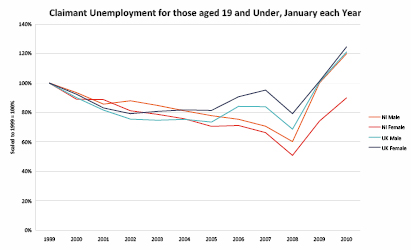
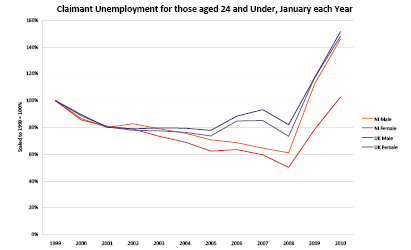
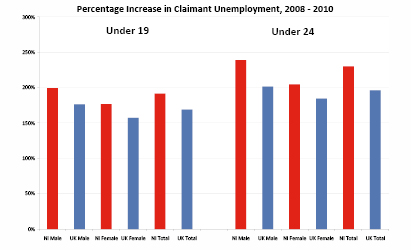
Key messages are:
- youth unemployment dropped in NI (and UK) in early parts of the decade. In NI claimant unemployment amongst those aged under 24 saw an uninterrupted decline to less than two-thirds the 1999 level by 2007;
- in the UK as a whole, youth unemployment started to rise again from 2004 until it recovered its 1999 level in 2006, falling slightly in 2007;
- from 2007 onwards - and particularly in the past year, youth unemployment levels have risen sharply in both NI and the UK as a whole;
- the rise over the past two years has been more pronounced in NI than in the UK, with there being almost three times the number of young people aged 24 and under claiming JSA in October last year than was the case in 2007;
- although both males and females have been affected by the recent rise, the rise in youth male unemployment has been greater than amongst young women;
- while there has been an increase in youth unemployment as a result of the economic downturn, and hence in overall terms across the UK the numbers of 16-24 year olds not in education, employment or training have increased, it is important to bear in mind that this situation has resulted from global and external economic factors. Increasing job opportunities, when the economy improves, is likely to address this situation;
- this serves to illustrate that the significant numbers of young people who were not in education, employment or training prior to the recession were more a product of social, community and education factors, rather than the economic situation.
NI Census and economic inactivity
3.34 Statistics on economic activity and inactivity are collected in the Northern Ireland Census and are available via NISRA. The statistics on economic activity from the 2001 census classify individuals as economically active or economically inactive with the main categories being employed, student and unemployed. Training is subsumed into the employed category. While figures from the Census are now dated they do give a breakdown of the different types of activity and reasons for economic inactivity which are likely to be still of relevance when identifying the reasons young people are disengaged. For the purpose of the analysis students were considered economically active as they are not NEET.
3.35 Under this categorization the percentage of 16 year olds who were economically active stands at 98% with 93% remaining in education. These percentages had dropped to 84% by aged 19 with half still in education. Unemployment for 19 year olds stood at 9% of the total 19 year old age group with an additional 7-8% not working due to sickness or disability; looking after home/family; or other reason. These latter groups are more likely to be the true NEET group who are not engaged with any agencies and are unlikely to access training.
3.36 For the 16-19 year old age group a total of 9% were inactive according to interpretation of the Census figures. This comprised approximately 9,600 in 2001. The number of 19 year olds has increased since the census and if trends in activity have remained the same, demographic changes will have brought this figure up to 9,800.
Summary – data sources in Northern Ireland
3.37 To summarise, the data sources in Northern Ireland are diverse with each providing different information on the NEET group:
- The Labour Force Survey gives us the overall figure of those not in education, employment or training for both the 16-19 and 16-24 year old age group but the definitions are problematic as training is restricted to that which is government supported and education is restricted to full time;
- The DE School Leaver's Survey gives additional information on school type and FSM entitlement which starts to give a picture of the NEET group having different characteristics to their peers. This is further supported by the qualifications information. (To note, the School Leavers' Survey commences in November and research has suggested that by January a number of leavers who initially had signed up for training or education will have changed their minds and will have dropped out. Scotland has a School Leavers' Survey which is carried out 3 months after the young people leave school. In addition to this initial survey, a second survey is carried out 9 months after leaving.)
- The 2001 census is dated but it gives information on the activities of those not in education, employment or training. It also provides statistics broken down by age and gender. Geographical analysis would also be possible.
- Information is available through Careers Service activities and arrangements are in place to make legislative change to improve and further facilitate the sharing of pupil data between schools and DEL. This will also enable the Careers Service to avail of destination information collected by DE during the annual school census and to track young people who are no longer in education, employment or training, with a view to re-engagement.
Data sources in England and Wales.
3.38 In England, the Client Caseload Information System (CCIS) is an important mechanism. This tracking system is operated by and works alongside the Connexions Services which was established in 2001 with the aim of providing a comprehensive service to meet young people's needs for information, advice and support. The statutory responsibility for the CCIS now lies with local authorities having transferred from the Department of Education and Skills in April 2008. The CCIS allows local authorities and the Connexions Service to know which young people are most at risk of disengaging and their history, characteristics and needs, and to be able to contact and support them individually. An important part of the strategy in England is the strengthening of this tracking service through the new requirement for post-16 learning providers to notify the Connexions Service as soon as a young person leaves Post -16 learning. This allows these young people to be supported during this transitional stage. New legislation to be introduced by 2013 will make this a legal duty for schools, colleges and other learning providers.
3.39 Another useful source of Information in England is the Youth Cohort Study (YCS). This is a longitudinal study with a cohort being interviewed successively over a number of years. The question of NEET features heavily in the study with analysis comparing the NEET group with those in Education, Employment or Training. The Department for Children, Schools and Families have published statistics from the survey of 16 year olds in England in 2007.
3.40 The YCS represents a rich source of information on the characteristics of those who are NEET and analysis of this group compared to the peer groups shows that while the NEET group is far from homogenous, they do share common characteristics which distinguish them. The characteristics of the group are explored in further detail in Chapter 4 and Annex A.
3.41 Research by the National Foundation for Education Research (NFER) based on the Youth Cohort Study data on 1,637 individuals who left school in 2001 or 2003 followed the study group for 4 years after their initial entry to NEET. This research shows an important segmentation of the NEET group into three distinct populations. This conclusion is supported by other research which identified 3 groups, termed:
- Transitional or Gap Year NEET (41%).
- Floating NEET (22%); and
- Core NEET (38%).
3.42 Within the NFER research the statistical analysis of these groups was supplemented by qualitative analysis which allows for identification of common characteristics within each group.
3.43 The Open to Learning or "Transitional and Gap Year" group comprised 41% of the study population. This group tended to show few of the problems traditionally associated with the NEET group and in some cases their NEET status reflected no more than a gap between two education, employment or training options. This group has the highest educational attainment of the group and had positive school experiences and no barriers to re-engagement. In many cases these young people had started a post-16 education or training course but had dropped out. They were optimistic about their future having clear plans on what lay ahead for them.
3.44 After 4 years less than 20% of this group remained as NEET with just below 60% having returned to education. The remainder were in employment in Jobs without Training. In terms of their overall characteristics, just below 70% had had a good experience of school compared to just over 30% of other young people who are not in education, employment or training. Their positive experiences of education had resulted in just below 90% having achieved level 1 (equates to 5 GCSE's at grades D to G) qualifications compared to less than 60% for the others in the NEET group. Most importantly, over 80% wanted to do more education or training. The percentage for the others in the NEET group at over 70% shows that regardless of the barriers faced, aspirations among this total NEET group are still relatively high.
3.45 The Undecided or "Floating" NEETs comprised 22% of the total study population. While most of this group had achieved at least level 1 qualification they had a negative view of school and were largely dissatisfied with what was on offer in terms of education, employment or training. They lacked the resilience to overcome obstacles and tended to react by dropping out. They lacked the skills to make choices or to plan for the future. After 4 years approximately 35% remained with a similar percentage returning to education. The remainder entered employment in jobs without training. In terms of common characteristics, just below 90% had achieved level 1 qualifications compared to less than 70% of other NEETs. Over half the group had started doing a qualification but left before completing assessment: this compared to just over 30% of other NEETs. Perhaps the most telling characteristic for this group is that over 90% reported that they had not found a suitable job or course, this comparing with less than 60% of the other NEETs.
3.46 While the degree of 'churn' in the NEET group has been discussed, NFER pointed to a group of Sustained or "Core" NEET, comprising 38% of the study group. This group had complex needs and many barriers to participation. Their parents are typically unemployed and they have had negative experiences of school, often leaving with very little by way of educational attainment. In many cases these young people had 'missed out' on careers advice. Four years after entering NEET approximately 48% were still in the NEET group with very few (2%) having returned to education. The remainder of the group (50%) had entered employment although the jobs were low or unskilled – recorded by NFER as Jobs without Training (JWT).
3.47 This group of sustained members of the NEET group differed from the other NEET group in several aspects. Where almost 90% of other NEETs had achieved level 1 qualification, the percentage for Sustained NEETs was just over 40%. The percentage who had been truants for days or weeks at a time was over 40% for the sustained group contrasting with 5% for the others and over 50% of the sustained NEETs had suffered permanent or fixed exclusion from school compared to less than 13% for the 'other' group.
Statistical First Release (SFR) - groupings
3.48 Using the Connexions Case Information System (CCIS) data SFR classifies the NEET group into one of 3 types.
- Group 1 (Out of Scope) – young people who are doing some activity which is not formally counted as education, employment or training, gap year students and those undertaking voluntary work. It will also include those in custody (22%).
- Group 2 (Identifiable Barrier) - young people who have an identifiable barrier to participation, such as they have a child or are experiencing serious illness or disability. Some of these individuals may be able to participate now, but others may require specific help to do so (23%).
- Group 3 (No Identifiable Barrier) – Young people who are NEET but are not in either of the specific categories outlined above (55%)
3.49 The main purpose of segmentation into these groups (using the CCIS data) means a picture can build up of what the policy target group looks like and relevant and effective interventions planned.
3.50 Scotland has also recognised the 3 groups within NEET and refers to them as:
1. The "transition/gap year" group – containing young people taking time out before progressing.
2. The hardest to help young people – with complex needs,
3. An "intermediate" group of young people – the quietly disaffected,
3.51 The following table sets out the breakdown if the SFR percentages are applied to the total number of 16-18 year olds who are not in education, employment or training in England, also by gender.
Table C - Estimated number of people in each category of NEET.
| 16-18 | Female | Male | Total |
| Category 1 (Out of Scope) | 18,000 | 28,000 | 46,000 |
| Category 2 (Identifiable Barrier) | 39,000 | 10,000 | 49,000 |
| Category 3 (No Identifiable Barrier) | 35,000 | 79,000 | 114,000 |
| Total | 91,000 | 117,000 | 209,000 |
Source: Internal DCSF analysis based on CCIS, UCAS data and SFR 12/2009 Participation in Education, Training and Employment by 16-18 Year Olds in England
3.52 The proportions vary widely depending on gender. While 55% of the 16-18 NEET group fall into the 'No Identifiable Barrier' category, 68% of 16-18 year old males are in this category compared to only 38% of females fall into this category. Young men who are not in education, employment or training are much less likely to have an identified barrier to participation (9%) than young women (42%).
Analysis on Figures for Northern Ireland.
3.53 There is no comprehensive data source which allows the Northern Ireland NEET figures to be disaggregated and characteristics to be identified. However the research in England and Scotland as described above would strongly suggest that the NEET group consists of 3 distinct groups: for example in the terms of the SFR Group 1 – (22%), Group 2 – (23%), Group 3 – (55%)
3.54 It is therefore possible to estimate the numbers who are in each category in Northern Ireland by applying these percentages to the figures we do have here. We know that there are 13,000 16-19 year olds which the Labour Force Survey records as not in education, employment or training in Northern Ireland (quarter 1 of 2010)..
3.55 Based on the English percentages and the LFS figures (with the caveats elaborated earlier) the total in the group in categories in Northern Ireland would stand at 10,140 or about 10% of the total 16-19 year old population.
3.56 On the same basis, a set of possible scenario figures in Northern Ireland for those young people in the 16-19 age band who are within the NEET group, based on the figures for the period January to March 2010, could look as follows:-
- Northern Ireland Group 1 –Out of Scope- (22%) [or 2,860 young people]
- Northern Ireland Group 2 – Identifiable barrier - (23%) [or 2,990 young people]
- Northern Ireland Group 3 – No Identifiable Barrier - (55%) [or 7,150 young people]
3.57 While this type of analysis is useful in giving an indication of the segmentation of the NEET group there may be some issues with applying the figures derived from a single point of time to a population which is constantly changing or churning.
3.58 This problem is exacerbated by the fact that the three NEET groups will have differing rates of "churn" with some young people remaining out of education, employment or training for longer periods while, for example, the group of those on a gap year will "churn" regularly. Also it follows from the concept of "churn" that at any one point in time when a survey is taken there will be some young people who have moved out of NEET status (and will, in time, move back into NEET) who are not counted as being NEET at the survey point. Thus the size of the group susceptible to NEET will be greater than that indicated by point estimates given by cross sectional sample surveys such as LFS.
Summary of Chapter 3
3.59 The data sources in Northern Ireland are diverse with each providing different information on young people not in education, employment or training - the Labour Force Survey gives us the overall NEET figure for both the 16-19 and 16-24 year old age group but the definitions are problematic as training is restricted to that which is government supported and education is restricted to full time.
3.60 Northern Ireland does not have a comprehensive data source such as the Client Caseload Information System which would allow the NI figures for young people not in education, employment or training to be disaggregated and characteristics to be identified or confirmed.
3.61 The latest LFS figures show that for 16-19 year olds the figures for Northern Ireland stand at 13% or 13,000 (LFS 2010, Quarter 1). This compares with a rate of 15% for the UK. The latest LFS figures for 16-24 year olds show that the proportion not in employment, government training schemes or full time education (January- March 2010) stands at 18%. The comparable LFS figure for the UK is 19% for 2010. Scotland and Wales in 2010 stand at 19% and 24% respectively.
3.62 From 2007 onwards - and particularly in the past year, youth unemployment levels have risen sharply in both NI and the UK as a whole. It is important to bear in mind that this situation has resulted from global and external economic factors and can illustrate that the significant numbers of young people who were not in education, employment or training prior to the recession were more a product of social, community and education factors, rather than the economic situation.
3.63 In England and Wales, key relevant data sources are the Client Caseload Information System, the Youth Cohort Study, research by the National Foundation for Education Research, and the Statistical First Release.
3.64 In general, young people who are not in education, employment or training can be divided into those with and without barriers to engagement. Statistical First Release figures split those 16- 18 year olds who are not in education, employment or training into three groups:
- Group 1 (Out of Scope) – young people who are doing some activity which is not formally counted as education, employment or training, gap year students and those undertaking voluntary work. It will also include those in custody (22%) (2,860).
- Group 2 (Identifiable Barrier) - young people who have an identifiable barrier to participation, such as they have a child or are experiencing serious illness or disability. Some of these individuals may be able to participate now, but others may require specific help to do so (23%) (2,990).
- Group 3 (No Identifiable Barrier) – Young people who are NEET but are not in either of the specific categories outlined above (55%) (7,150).
3.65 Applying these percentages to the 13,000 16-19 year olds which the Labour Force Survey records as not in education, employment or training n Northern Ireland (in quarter 1 of 2010), the number in Groups 2 & 3 would be 10,140 or about 10% of the total 16-19 age group.
4. Characteristics of Groups
4.1 The young people who are not in education, employment or training are far from a homogenous group, although many have characteristics which distinguish them from the remainder of the young population. The presence of these characteristics may make the already difficult transition from compulsory schooling to further education, employment and training even more problematic and therefore can result in the young person entering the NEET group. The identification of the groups listed below has resulted from discussions with Government Departments and the voluntary and community sector within Northern Ireland and is supported by the research and case studies from elsewhere.
4.2 Table D is taken from the Youth Cohort Study and shows the characteristics of the NEET group in England and Wales. The main factors are clear. While the figures show that in the survey, NEET constitutes 8% of the total study population, they constitute 13 % of those whose parents are in routine jobs, 16% of those with Free School Meals and 36% of those reporting no year 11 qualifications. (Year 11 in England is the equivalent of year 12 in Northern Ireland.) Levels of persistent truancy are also evident and 20% of those with persistent truancy levels have no academic qualifications compared to 3% of those with no history of truancy. Research evidence would also suggest that a significant percentage of NEET have been bullied when at school, females being more likely to be bullied than males. The interdependence of characteristics which often lead to young people being NEET is also evident in the YCS results as is the effect of family involvement with young people and the effect of a close family on outcomes being demonstrated. Statistics on parents' knowledge of where a child is and parents' setting of a curfew correlate negatively with the NEET group.
Table D - Characteristics of the NEET group
| Weighted sample2 | Male | Female | Total | |
| All | 19114 | 8 | 7 | 8 |
| Ethnic Origin | ||||
| White | 16311 | 9 | 8 | 8 |
| Mixed | 431 | 9 | 6 | 7 |
| Black | 836 | 4 | 2 | 3 |
| Asian | 1298 | 4 | 4 | 4 |
| Other Ethnic Group | 209 | * | * | 4 |
| Parental Occupation (NS-SEC) | ||||
| Higher Professional | 1251 | 3 | 1 | 2 |
| Lower Professional | 7045 | 5 | 3 | 4 |
| Intermediate | 3554 | 7 | 6 | 6 |
| Lower Supervisory | 1578 | 10 | 9 | 10 |
| Routine | 3242 | 14 | 12 | 13 |
| Other/Not classified | 2444 | 17 | 17 | 17 |
| Parental Qualifications | ||||
| Degree | 4035 | 3 | 2 | 2 |
| At least 1 A-level | 4017 | 5 | 5 | 5 |
| Below A-Level/Not sure | 11062 | 12 | 10 | 11 |
| Free School Meals (FSM) | ||||
| No | 15332 | 8 | 6 | 7 |
| Yes | 2348 | 17 | 16 | 16 |
| Disability | ||||
| Yes | 737 | 20 | 12 | 15 |
| No | 18331 | 8 | 7 | 8 |
| Year 11 Qualifications1 | ||||
| 5+ GCSE grades A*- C of which | 11146 | 2 | 2 | 2 |
| 8+ grades A* - C | 8418 | 1 | 1 | 1 |
| 5-7 grades A*- C | 2728 | 5 | 5 | 5 |
| 1-4 GCSEs grades A*-C | 4028 | 9 | 9 | 9 |
| 5+ GCSE grades D – G | 2181 | 15 | 15 | 15 |
| 1-4 GCSE grades D – G | 983 | 25 | 33 | 28 |
| None reported | 776 | 36 | 37 | 36 |
| Truancy in Year 11 | ||||
| Persistent Truancy | 780 | 28 | 27 | 27 |
| Occasional Truancy | 4954 | 11 | 10 | 11 |
| No Truancy | 12479 | 5 | 4 | 5 |
Source: LSYPE, wave 4 and TCS, Cohort 13, sweep 1.
1 Includes equivalent GNVQ qualifications achieved in year 11
2 Figures may not always sum to total weighted sample due to those cases which are missing, not applicable, refused or don't know.
* Represents a cell size of less than 5
4.3 As part of the studies carried out, young people who were recorded as NEET were asked why. The most common reason given for both males and females was 'I need more qualifications and skills before I can get a job or education or training place'. This appears to indicate a willingness to proceed but some barrier in respect of education. When asked what they expect to be doing in 12 months time the majority of responses indicated employment, training or education. While higher aspirations exist, the young people studied who were currently NEET showed higher levels of risky behaviour than that shown by those outside of the NEET group. These behaviours included smoking, drug taking and causing damage to public property. Rates for smoking did not vary significantly between NEET and non NEET.
4.4 It is likely that those who spend any significant amount of time as NEET will encounter a range of other disadvantages later in life. For example a study of young people within the Greater London Authority found that males born in 1970 who had been NEET for 6 months were, compared to their peers: 3 times more likely to have depression; more than 4 times more likely to be out of work; 5 times more likely to have a criminal record and 6 times less likely to have qualifications.
4.5 The characteristics are not in any way mutually exclusive and in many cases a young person will experience several of them simultaneously. In addition to this, the relationship between individual factors is also complex. For example, a young person may be unable to progress because of a long standing mental illness or it may be that the experience of being NEET has contributed to a deterioration in the young person's mental health and wellbeing. Similarly a young person may have a negative experience of education but this may be due to an experience of bullying because of a disability or a poor family background.
4.6 Some of the factors identified are with the children from an early age and leave the young person needing additional support in order to get the best benefit from education and to make a successful transition to further education, training or employment. This early supportive intervention may in some cases assist the young person to achieve a better outcome. This section identifies these characteristics with more detail on the characteristics and associated problems contained in Annex A.
4.7 The groups most usually associated with NEET are Children and Young People:
- in care
- who have left care
- are on the edge of care
- who have had a negative experience of education
- who have suffered from bullying at school
- who have problems with literacy and numeracy
- who are carers
- who are parents
- who have experienced drug and alcohol abuse
- who have a physical disability/learning disability
- who have committed a crime
- who have a mental illness
- with economic disadvantage
- who are homeless
4.8 Annex A provides further detailed information on these groups, considered individually in some detail in order to identify what characteristics result in an increased chance of them becoming disengaged. As stated earlier, the relationship between the characteristics is a complex one and this will inevitably lead to some duplication and cross referencing. The information given has been taken from a literature search under each group and from discussion with organisations and agencies in contact with the group.
Summary of Chapter 4
4.9 Young people who are not in education, employment or training are far from a homogenous group. There is a wide spectrum of problems and the barriers they face can be multiple and compounded, often from their earliest years. The groups most usually associated with not being in education, employment and training are children and young people: in care; who have left care; who are on the edge of care; who have had a negative experience of education; who have suffered from bullying at school; who have problems with literacy and numeracy; who are carers; who are parents; who have experienced drug and alcohol abuse; who have a physical disability/learning disability; who have committed a crime; who have a mental illness; with economic disadvantage; who are homeless.
5. Actions in GB, The Republic of Ireland (ROI) and Northern Ireland
5.1 In this section we summarise activity being taken forward in GB and RoI, and then describe action in Northern Ireland.
Actions in England, Scotland, Wales and the Republic of Ireland
5.2 NEET strategies for England, Scotland and Wales and the initiatives in the Republic of Ireland demonstrate some common characteristics. These are listed below:
- the NEET group is not easily defined by age. Pre-school provision is an important factor and the long term effects of NEET can extend well into adulthood;
- strategies tend to divide into Preventative and Re-engagement or Intervention approaches;
- early preventative intervention and additional support at an early age is seen as important in stopping a young person becoming part of the NEET group;
- the NEET group is not homogenous, being built up of many smaller subgroups which are not mutually exclusive;
- the heterogeneous nature of the problem necessitates flexibility in response;
- the complex nature of the NEET problem requires interdepartmental and agency communication and co-operation, which can be localised geographically. This in turn facilitates opportunities to share experience and disseminate good practice;
- the danger points for young people are the transitional stages when one form of activity ends and a conscious decision needs to be made as to the next engagement, also related to choices for and experiences of the 11-14 and 14-19 age groups;
- disengagement from society and the economy is in many cases linked to other factors of social exclusion and the identification of these factors is a starting point to finding solutions to this problem;
- in general the group can be divided into those with and without barriers to engagement.
5.3 Annex B provides detailed information on relevant strategies and activities in England, Scotland, Wales and the Republic of Ireland.
Relevant Actions in Northern Ireland
5.4 As indicated earlier, the young people who are not in education, employment or training in many cases have other social and economic barriers which make engagement and integration more difficult. In some cases young people suffer from several such factors with the effects being compounded. Given the range of issues, we have considered each of the factors in turn to scope what actions are already being taken in Northern Ireland, and by what sector. In addition to the actions taken to address specific factors there are some general schemes and initiatives aimed at getting young people back into education, employment or training.
5.5 While Northern Ireland does not currently have an overarching strategy for NEET as such, a large number of strategies and initiatives have been developed to address aspects of social and economic exclusion. The achievement of the objectives in these strategies would in many cases have a positive impact on the proportion of young people in the NEET group. One such target is that set jointly by DE and DEL to increase the participation rate of 16 and 17 year olds in full time education or vocational training. The current PSA target aims to achieve 95% participation by 2011. In 2008/09, 87% of 16-17 year olds were in full-time education or training. The corresponding figure for England was 82%.
Children and Young People's Strategy
5.6 In June 2006 the Northern Ireland Government launched a Children and Young People's Strategy which aimed to ensure that by 2016 all Children and Young people would be fulfilling their potential. This is a very challenging target. The strategy examines the scope for achieving a more joined up approach within government to children's issues.
Anti-Poverty and Social Inclusion Strategy
5.7 'Lifetime Opportunities, Government's Anti-Poverty and Social Inclusion Strategy for Northern Ireland' was published following its launch by the then Secretary of State, Peter Hain, in November 2006. On 20 November 2008 the Executive agreed formally to adopt the broad architecture and principles of Lifetime Opportunities as the basis of its strategy to tackle poverty and social inclusion here.. Section 3 concentrates on Children and Young People (5-16). The goal is:
"To ensure all children and young people experience a happy and fulfilling childhood, while equipping them with the education, skills and experience to achieve their potential to be citizens of tomorrow."
5.8 The strategy recognises that the most important factors that influence a child's life chances are education and skills and the need for appropriately targeted support and appropriate interventions aimed at increasing opportunities for young people. The need for advice, training and support is acknowledged especially in the case of young people who are facing teenage parenthood, coming out of care, facing barriers through disability or having caring responsibilities.
Ministerial Sub-Committee on Children and Young People
5.9 The Executive's Ministerial Sub Committee on Children and Young People was established in March 2008. Six key priorities were agreed and these are listed below:
1. A holistic and comprehensive approach to child poverty;
2. A comprehensive early years' strategy that focuses on the development and wellbeing of each child, including affordable access to high quality early years provision for families living in areas of disadvantage and poverty in urban and rural areas;
3. Provision that deals with vulnerable young people particularly issues with risky behaviour, alcohol, drug abuse and suicide;
4. Safeguarding, including support for parents, families and carers;
5. Provision for children with a disability or a mental health condition including learning disablement resettlement into the community, new or enhanced respite packages, autism review and transition from schools, including special schools to the most appropriate provision for the next stage.
6. Provision of school buses, road safety and transport issues.
5.10 A subgroup was established to consider each priority with a lead department identified.
Families Matter
5.11 Another example of a relevant strategy in Northern Ireland is 'Families Matter: Supporting Families in Northern Ireland' which was published by DHSSPS in June 2008. With a similar aim to the Children's and Young People's strategy, Family Matters aimed to 'ensure that every child, irrespective of race, gender, religious belief, age, sexual orientation, disability, background, or circumstances, gets the best start in life and the support they need to fulfil their potential.' Families Matter will help to achieve the vision set out in the children's strategy by supporting parents. It acknowledges that government will need to work with other statutory agencies as well as voluntary, charitable and community organisations and parents in order to deliver its objectives. Integrated planning and commissioning will be promoted and it and is recognised that these must be supported at Government level, regional level and at local level.
Specific Measures and initiatives
5.12 As well as overarching strategies relevant to the issues, a wide range of relevant actions have been put in place by Government and by the voluntary and community sectors which link directly to the identified groups, which are similar to measures which have been put in place in other regions in this context, and/or which involve productive cross-departmental or multi-agency working.
5.13 Annex C provides more detail on these initiatives, examples of which are listed below.
Children and Young People in care/who have left care/ are on the edge of care
5.14 Care Matters in Northern Ireland – a Bridge to a Better Future (Care Matters in Northern Ireland) (DHSSPS March 2007) deals with early intervention and support for children in care or on the edge of care, establishing a vision for what services to these young people should look like. The strategy includes actions which reflect the roles and responsibilities of a number of Northern Ireland departments and agencies. These build on the targets set out in the 10 year Children's and Young People's Strategy. While in terms of NEET these young people are severely disadvantaged their unique position should make it easier for them to maintain contact with agencies working to assist them.
Children and Young people who have had a negative experience of education including Children and Young people who have problems with literacy and numeracy and those who have experienced bullying at school.
5.15 Due to the composition of the NEET group and their disaggregation into different sub-populations many of the actions to help young people through school are relevant, for example:
- The Department of Education (DE) policy for raising overall performance and narrowing the gap in achievement - "Every School a Good School: A Policy for School Improvement" which was launched in April 2009 and which recognises the importance of school leaver qualifications and, in particular, standards of literacy and numeracy as expressed in the numbers of school leavers achieving 5 GCSEs at A* to C including English and Maths;
- the development and publication by DE of guidance in relation to bullying, teenage mothers or carers;
- initiatives in support of teenage mothers.
- the development of Alternative Education Provision, within the context of the school discipline strategy;
5.16 DE and DEL are currently working together to focus on qualification provision for the SEN sector and how this can be developed under the Entitlement Framework.
Children and Young people who are carers
5.17 DHSSPS is committed to ensuring that young carers are made aware of the support available to them and that their general wellbeing, development and education are not adversely affected by inappropriate levels of responsibility being placed upon them. A range of guidance, information and support measures have been put in place including specific local initiatives involving local voluntary and community sector organisations.
Children and Young people who are parents
5.18 As well as initiatives in support of school aged mothers, relevant here is the DHSSPS 'Strategy and Action Plan for Teenage Pregnancy and Parenthood 2002-2007', calling for a multi-agency approach and the development of strong cross-sectoral partnerships.
5.19 The Department's Sexual Health Promotion Strategy and Action Plan 2008 – 2013 which aims to improve, protect and promote the sexual health of the entire population, identifies that young people are especially vulnerable and require particular attention. The multi-agency Sexual Health Improvement Network has been asked to consider and integrate future action on teenage pregnancy and parenthood as part of its work.
Children and Young people who have experienced drug or alcohol abuse
5.20 In May 2006 DHSSPS issued their 'New Strategic Direction for Alcohol and Drugs 2006-2011' (NSD). The strategy builds on earlier strategies and initiatives and is based on 5 key priorities: Prevention and early intervention; Treatment and support; Law and criminal justice; Harm reduction and monitoring; Evaluation and Research. One of the aims, underpinned by a range of activities which have been carried out, specifically targets young people and aims to:
"Promote opportunities for those under the age of 18 years to develop appropriate skills, attitudes and behaviours to enable them to resist societal pressures to drink alcohol and/or use illicit drugs, with a particular emphasis on those identified as potentially vulnerable".
5.21 To support the work underway within the NSD DHSSPS has led the development of a cross-sectoral action plan on 'Addressing Young People's Drinking in Northern Ireland', and this was published in June 2009. The NSD also recognises the need to provide additional services and support for children and young people affected by parental/carer drug misuse a Hidden Harm Action Plan was launched in November 2008.
5.22 An example of a local initiative which treats misuse within a wider context is the Prevention Education on Alcohol and Substance Misuse (PEAS) initiative which is run by VOYPIC (Voice of Young People in Care) and targets young people with experience of care.
Children and Young People who have a mental illness
5.23 In July 2007 the Northern Ireland Health Minister re-launched a major public information campaign aimed at de-stigmatising mental health. The 'Minding your Head' campaign encourages young people to discuss their problems and to seek help. This was part of the wider 'Northern Ireland Suicide Prevention Strategy, 'Protect Life – A Shared Vision'. The 'Minding your Head' website is aimed at those who are worried about mental health – either their own or someone else's. It contains information on how to recognise the early symptoms of mental illness and suggests ways to stay healthy. There is a separate section for young people which deals with issues which would particularly affect this group. These include Home life, Friends, School and College, Abuse, Bullying, Alcohol and Drugs, Eating Disorders, Self Harm and Suicide.
5.24 The Department of Education is in the process of developing a programme to promote pupils' emotional health and well-being as a whole school development issue which should attract an equal focus with raising standards. As part of school's pastoral care provision post-primary age pupils now have access to independent counselling support. This support will be made available to other pupils as resources permit.
Children and Young people who have committed a crime
5.25 The Youth Justice System in Northern Ireland has experienced a number of reforms beginning with 'The Children Order 1995' and including the introduction of the Criminal Justice (NI) Order which was implemented in January 1999 and replaced the Training School Order with the Juvenile Justice Centre Order with half the sentence spent under supervision in the community. There was then investment in community provision through both statutory and voluntary sector providers. The number of children proceeded against at court has shown a significant decrease in recent years falling by nearly 30% from 2327 in 1996 to 1643 in 2006.
5.26 The Youth Diversion Scheme was launched in 2003 by the PSNI as a new initiative aimed at tackling youth crime. The Youth Justice Agency was launched on 1st April 2003 with the principal aim of reducing youth crime and building confidence in the youth justice system. The agency works with children aged 10-17 who have offended or are at serious risk of offending.
5.27 There is also a wide range of local initiatives in place in support of work in this area such as the Youth Employability Programme, a partnership between NIACRO, the Probation Service and the Youth Justice Agency, which supports young people aged 15 to 18 who are involved with the youth justice system, to undertake education, training or employment. Action for Children in Northern Ireland have a specific focus on young people who have offended or are at risk of offending and work in partnership with the Youth Justice Agency, the Police and the Education Welfare.
5.28 There is also ongoing work with the aim of improving support for children and families of those in custody based upon a mutually agreed protocol; for example the recent publication by the NI Prison Service of a draft 'Family Strategy' (2009) for consultation.
Children and Young people who have a physical disability or learning disability
5.29 A wide range of policies and provision is in place across statutory and non-statutory authorities in support of children and young people with a physical and/or learning disability and this involves a high level of inter-agency working. For example, The 'Report of the Inter-Departmental Working Group on Transitions' published in 2006 included a range of actions designed to promote improvement to enable young people with Statements of Special Educational Needs to make a successful transition from school to adult life. In general terms the health and social care, education and employment and learning authorities liaise and work together closely with each other and with voluntary and community groups in planning and providing individual services and initiatives. A Regional Transitions Implementation Group on children with Complex Health Care Needs, led by the Health and Social Care Board is in the process of being established. An inter Departmental sub group is also in place to take forward a range of cross cutting issues impacting on this client group.
5.30 DEL has addressed a number of recommendations made by a Disability Working Group on the Training for Success programme which aim to make a positive impact on the recruitment and retention of young people with a disability to this training programme. This includes a new procedure for the identification, referral and delivery of a Pre-Entry Training Support Service for potential entrants to this programme who have a disability with the aim of having the necessary support in place on entry to training.
Children and Young people with Economic Disadvantage
5.31 Reference has already been made to the Government's Anti-Poverty and Social Inclusion Strategy for Northern Ireland' which set out a context for policy to break the cycle and the process that results in children underachieving, having limited aspirations and low levels of educational qualifications. The benefit of early years experience (from 0-4 years) is stressed and is supported by recent research into Childcare provision in Northern Ireland. The child poverty subgroup of the Ministerial Sub Committee on Children and Young people is examining the provision of childcare as an effective tool for assisting families to break out of the cycle of poverty and unemployment.
5.32 In terms of early years, international evidence suggests that there is an income-related gap in school readiness by the time formal education begins and, also, that interventions early in life can help to reduce barriers to learning that may, otherwise reduce children's longer-term chances of success. The benefits of early years education have been recognised internationally and from 1998 Government in Northern Ireland has expanded pre-school provision for all children aged 3-4 years whose parent wishes to avail of it. Longitudinal research, published in The Effective Pre-School Education Provision in Northern Ireland Report (EPPNI) 2006 provides evidence that the benefits of pre-school enhance the cognitive and social development in all children, and the benefits can be seen up to the end of Key Stage 1. Creating the right conditions for early childhood development is likely to be more effective and less costly than addressing problems at a later age.
5.33 The Sure Start Programme offers a range of services to all parents with children aged 0-4 years living in a designated Sure Start area, including outreach and home visiting, family support, healthcare advice, high quality play and learning opportunities and support for children with particular needs. Each Sure Start Partnership must provide a range of core services and they also have the flexibility to provide services and activities in response to locally identified needs. These quality early childhood services help parents and families to improve children's development and well-being, to ensure the maximum benefit for the child.
5.34 Sure Start covers at least the 20% most disadvantaged wards across the North of Ireland and was introduced during 2000/01. Sure Start has developed over time since 2001 to 32 Sure Start Partnerships enabling an estimated 34,000 children aged from 0-4 and their families to have access to the services provided through the Programme. Funding and overall support for the Sure Start Partnerships is provided by the Department of Education and delivered through the 4 Childcare Partnerships based in the Health & Social Care Board. DE has developed a new draft Early Years 0-6 Strategy that has as its central aim 'to enable every child to develop to their full potential by giving each one the best start in life'.
5.35 Another example of a relevant initiative in this context is the DE Extended Schools Programme, which was launched in 2007 as part of the Children and Young People Funding package. The intention was that the programme should be targeted on children and young people who are disadvantaged, marginalised or who have the most limited access to existing services. Free school meals entitlement was used as a measure of social deprivation along with the Northern Ireland Multiple Deprivation Index (NIMDM 2005) which is a measure of multiple deprivation at the small area level.
Children and Young people who are homeless
5.36 A range of research has been undertaken on homeless young people, pointing towards the need for early prevention and the provision of timely advice and information as well as a multi-agency approach within integrated approaches to prevent family and relationship breakdown. The Northern Ireland Housing Executive has recently produced a third issue of their 'Directory of Floating Support'. Floating Support is assistance provided in a person's own home by a support worker and is tailored to meet the needs of the individual. A project called 'The Common Monitoring of Homeless 16-25 year olds in Northern Ireland' has been commissioned by the Policy Studies Institute Youth Homelessness Sub Group, a cross departmental, cross-sectoral steering group tasked with the development and implementation of a Work Plan for a regional, strategic response to the issue of youth homelessness.
Programmes/Initiatives to assist Young People to enter or remain in Education, Employment or Training
5.37 While some young people fall into specific categories, others have more general or multiple problems. Their needs are met by a number of organisations who provide general guidance and support. These more general initiatives which while designed in many cases to address the requirements of all young people, provide special support and help to meet the needs of children with specific barriers to engagement such as those from the groups listed above. Some key examples follow:
The Careers Service, DEL
5.38 The Careers Services provides impartial, information, advice and guidance to young people and adults throughout Northern Ireland. This service is delivered by professionally qualified Careers Advisers based in Jobs and Benefits Offices/JobCentres and Careers Offices. The Careers Advisers help young people and adults make informed decisions about opportunities in education, training and employment. Preparing for Success - The Careers Education, Information, Advice and Guidance Strategy and Implementation Plan' was formally launched by the Ministers of Education and Employment and Learning on 28th January 2009. The strategy aims to develop effective career decision-makers, leading to increased and appropriate participation in education, training and employment. This is an all-age strategy which has been developed around five key themes: improving careers education; improving access to careers information; improving the provision of careers advice and guidance; improving quality and improving professional development. The implementation plan sets out the key actions and milestones in relation to each of these themes. The focus for the delivery of "Preparing for Success" will initially be 5 years with a review scheduled for 2014.
5.39 Careers Advisers build, maintain and sustain an effective guidance relationship which values and respects the young person, where each young person is encouraged and supported with careers information, advice and guidance to enable them to achieve their potential within education training and employment. The Careers Service has developed networks/ partnership agreements with a number of organisations who act as advocates for young people with varying barriers to education, training and employment.
5.40 Through the Careers Service social inclusion policy a proactive approach is taken to identify all young people who are 'at risk' or vulnerable to social exclusion. For those young people who are not engaged in a positive destination, the Careers Services makes regular contact with them to offer Careers Information, Advice and Guidance. The Careers Service also has partnership agreements with post primary schools in Northern Ireland, to support the schools' careers education programmes. Young people at risk of social exclusion are a priority group for the Careers Service and through these agreements, Careers Advisers work with schools to identify and support those most at risk. Through partnership arrangements with Training Organisations, early leavers from Training for Success are referred to the Careers Service for follow-up advice and guidance.
The Essential Skills Strategy, DEL
5.41 Essential Skills support is designed to enable adults to improve their overall quality of life, their personal development, and their employment opportunities by addressing their weakness in literacy, numeracy and ICT.
5.42 The International Adult Literacy Survey (IALS) completed in 1996 concluded that 24% of adults in Northern Ireland were deemed to be functioning at the most basic level of literacy and numeracy. To address this fundamental skills deficit Essential Skills is now one of DEL's major priorities.
5.43 Since the Essential Skills Strategy was launched in 2002 Essential Skills provision to achieve qualifications in literacy and numeracy has been fully integrated into the Department's programmes such as Training for Success, ApprenticeshipNI and Steps to Work. Essential Skills ICT was introduced as a third Essential Skill in August 2009.
5.44 To date, over 60,000 learners have obtained Essential Skills qualifications and the Department has set a challenging target of 42,000 people to achieve an Essential Skills qualification between 1st April 2008 and end of March 2011.
5.45 The Essential Skills Strategy is now entering a new phase which will focus on engaging employers and those people already in employment as well as targeting the hardest to reach groups in society. In addition, a number of groups have been targeted where Essential Skills needs are known to be high and where resources can be allocated effectively by focusing the efforts of Government Departments and agencies. These groups include unemployed people and benefit clients, prisoners, public sector employees, foster carers and low skilled people in employment.
Programmes/Initiatives to assist young people find suitable training and employment
5.46 DEL's aim is to promote learning and skills, to prepare people for work and to support the economy. The work of the Department is right at the centre of the Government's wider economic, social and lifelong learning policies, assisting economic growth on the one hand and social inclusion on the other. The Department stands at the centre of a wide ranging training and education network, with which it contracts and funds, to which it seeks to give strategic direction and with which it works in partnership. That network involves NI's Universities, the Open University, Teacher Education Colleges, FE Colleges and training organisations, not to mention the network of Sector Skills Councils and a number of Non Departmental Public Bodies as well as close working with other Government Departments.
5.47 Key programmes and activities which can contribute to the process of reengagement of young people include:
Training for Success/Apprenticeships NI
5.48 The Department provides a guarantee of a training place to those who are unemployed and in the 16 and 17 year old age group; aged under 22 for those with a disability; and under 24 for those young people who qualify under the Children (Leaving Care) Act (NI) (2002). Training for Success (TfS) is targeted at 16-24 years olds, allowing them to enter training at an appropriate level and progress to a stage where they can maximise their potential through the development of personal and employability skills and the achievement of qualifications and employment.
It is delivered through two components:-
(1) Personal Development/Skills for Your Life
To address the personal and development needs of young people who have disengaged from learning and/or have significant obstacles;
(2) Skills for Work
To help young people gain skills and a vocational related qualification at Level1 to be able to gain employment or to progress to an apprenticeship
5.49 All young people entering the programme are assessed. The assessment identifies a participant's strengths and weaknesses in the context of personal development, training and Essential Skills needs, as well as assessing which component is most appropriate. Careers Advisers, parents, schools, social services, and other agencies can also be engaged where this is deemed to be helpful. The assessment will involve drawing up a Personal Training Plan that meets the personal and training development objectives identified.
5.50 The assessment also identifies any requirement for additional support although this should now be known for a participant with a disability through a new Pre-Entry Support Service. Additional support is provided through specialist support providers including Disability Action, Sensory Learning Support, the Cedar Foundation, Opportunity Youth and Include Youth. These providers work in conjunction with Training Suppliers with the aim of ensuring that the necessary support is provided in keeping the participant engaged in training and focused in securing the most appropriate outcomes.
5.51 TfS was evaluated by the Education and Training Inspectorate (ETI) in November 2008. The ETI found that TfS had improved opportunities for providers to respond more flexibly to the needs of learners who had not found employment, particularly those who had a physical disability.
5.52 The academic profile of learners who register on the TfS programme is generally poor which presents particular challenges for the training providers. The essential skills qualifications provide good opportunities for those with difficulties with numeracy and literacy.
5.53 ApprenticeshipsNI provides learners, who have attained the minimum school leaving age and are in full time paid employment, to gain an industry recognised apprenticeship qualification. Apprenticeship qualifications are at Level 2 and at Level 3, and comprise a technical certificate, a National Vocational Qualification (NVQ) and essential skills qualifications.
5.54 The Programme-Led Apprenticeships provision, introduced from September 2009, is an intervention measure during the current economic downturn. This new provision acknowledges that the present economic situation has made it increasingly difficult for would-be apprentices to find paid employment whilst completing their training. Programme-Led Apprenticeships will give 16 and 17 year old school leavers the opportunity to gain a full apprenticeship qualification in a chosen skill area, setting them on the path to career success. They will access this through a combination of simulated learning and time spent with an employer on a work placement up to a maximum of 3 days per week.
14-19 Curriculum
5.55 The central focus for 14-19 education is on developing young people to reach their full potential through the provision of a wide variety of suitable and flexible learning opportunities which are appropriately resourced and efficiently and effectively organised and delivered with the full support of education staff, parents and the community. DEL and DE have been working closely to co-ordinate each department's policy initiatives. This will result in a framework within which educational provision for 14-19 year olds will be developed.
5.56 The FE Curriculum has been developed to ensure that, through their curriculum offer, Colleges achieve an appropriate balance between provision that strengthens economic and workforce development, enhances social cohesion and advances the individual's skills and learning. In the main, Colleges base their provision on qualifications accredited to the National Database of Accredited Qualifications (NDAQ) and, in future, on to the Qualifications and Credit Framework (QCF). Colleges have a target to increase the proportion of taught hours of delivery that are on the NDAQ to 95% by 2011.
5.57 The Entitlement Framework for schools aims to improve the breadth, relevance and quality of pupil's educational experience and to raise levels of achievement, allowing a pupil's education to be better tailored to their educational needs, interests and future career plans. By 2013, one third of the curriculum offer in post-primary schools will be professional and technical in nature. While young people will not be obliged to follow professional and technical subjects at school, the opportunity to do so must be made available to them.
The Vocational Qualification Reform Programme (VQRP)
5.58 DEL is responsible for the implementation of the VQRP across Northern Ireland. The VQRP will affect all learning providers that deliver vocational qualifications (VQs). The broad aim of the programme is to increase the relevance, value and flexibility of VQs by involving employers in the development and planning process and through the establishment of a credit-based qualifications system which comprises a rationalised set of VQs – the Qualifications & Credit Framework (QCF).
Educational Maintenance Allowance (EMA)
5.59 The EMA was introduced jointly in September 2004 by the Department for Employment and Learning and the Department of Education in recognition of the importance of financial incentives in encouraging young people to continue in education. The main purpose of the scheme is to encourage young people from low income backgrounds to remain in post compulsory education. EMA was introduced for 16 year olds in 2004 and was extended to the entire 16 to 19 year old age group in the 2007/08 academic year.
5.60 A review of EMA is due to complete by Autumn 2010. This will seek to establish the overall effectiveness of the scheme in encouraging participation in post-compulsory education.
Further Education Sector (FE)
5.61 FE colleges offer professional and technical qualifications in a wide range of subject areas leading to recognised vocational qualifications as well as courses leading to academic qualifications such as AS and A levels.
5.62 Examples of relevant initiatives or work in the FE sector, which can also be set to help social inclusion and address the challenges for those in the NEET category are:
- a review of pastoral care;
- the introduction of the Individual Learning Plan;
- the Learner Access and Engagement pilot programme;
- mechanisms and initiatives for the provision of support for people with a learning difficulty or disability;
- the Care to Learn scheme.
5.63 FE colleges have introduced an Individual Learner Programme (ILP) for 16 to 19 year olds entering further education. The ILP is used as part of the college induction process to ensure that learners have an individual programme of learning designed to meet their specific needs and aspirations. This has led to the development of an electronic Individual Learner Programme (e-ILP), which is used by students and college staff to plan, and monitor progress against, individually tailored programmes of learning. This work is being supported by a new IT system that links to colleges' existing Virtual Learning Environments (VLEs) to ensure best practice in terms of learning plans for 16 to 19 year olds.
Higher Education (HE)
5.64 Completing a course of study within higher education brings benefits on many levels. In terms of future jobs, a degree can lead to increased earning potential, greater opportunities and a more rewarding career. For those already pursuing their careers, a higher education course can increase an individual's employment prospects and many employers understand the value of ongoing lifelong learning programmes for their staff. Both QUB and UU have established HE outreach centres throughout Northern Ireland. These offer wider local academic opportunities by providing a more flexible form of third level education provision.
5.65 Widening participation in higher education by students from groups who are currently under-represented is one of DEL's key strategic goals, in particular students from disadvantaged backgrounds, and those with disabilities and learning difficulties and a number of policy initiatives and specific funding mechanisms have been put in place. DEL is now working on the development of an integrated regional strategy for widening participation in Higher Education. Participation rates for socio-economic groups 4-7 are, however, already generally higher in NI compared to other regions of the UK.
The Wider Horizons Programme
5.66 The Wider Horizons Programme is jointly delivered by DEL and FÁS on behalf of the International Fund for Ireland (IFI). The Programme is designed to enhance employment opportunities for young people aged 18 -28 who are disadvantaged either socially, economically and through limited academic achievement or through unemployment. A key feature of the programme is the fostering of mutual understanding by ensuring each group of participants is drawn equally from the two traditions in Northern Ireland and from the South. In 2010 it is expected that 420 potential participants from Northern Ireland and 210 from the Southern border counties and Inner city Dublin will join the programme.
Employment Service
5.67 The Employment Service has two objectives: to assist people to move towards and into employment and to assist employers to fill vacancies. The Department's vacancy services are available to both employers and jobseekers at any location with internet access. The Employment Service offers a wide range of assistance to clients to help them overcome barriers to work and to move towards and into work. This includes an Adviser service in each Jobs and Benefits Office and JobCentres which can provide assistance on a wide range of issues including job search, These services are primarily targeted at those aged 18 and over, however some young people aged 16 - 18 may also access the service. More specifically, the Employment Service is currently piloting an Internship Scheme for unemployed graduates and a temporary employment programme for long term unemployed young people (18 – 24 year olds). A total of 120 places will be available for six months and the schemes will be evaluated in 2010 to determine if there is merit in making them more widely available, subject to resource availability. Employers are encouraged to recruit from those who are Employment Service clients e.g. individuals who are unemployed or economically inactive and/or to provide work placements. In some cases, an employer subsidy may be offered as part of the Steps to Work provision. Pre-employment provision may also be put in place to assist these individuals to compete for available jobs. This lead contact will work with the company's managers to establish which measures might be appropriate for the area.
Steps to Work
5.68 Steps to Work (StW) was 'rolled out' across Northern Ireland from 29 September 2008. However, as the contract for the delivery of StW in the Foyle and Lisnagelvin JBO areas has not yet been awarded, New Deal remains available in those areas.
5.69 StW is a flexible programme which can tailor provision to the individual's needs with the aim of assisting participants who are unemployed or economically inactive to find and sustain employment. An Adviser will help the more job-ready to move into employment at the earliest opportunity and will also provide assistance in addressing the employability needs of those further from the labour market. Through this new initiative the Department has extended the availability of adult return to work provision to other groups not previously targeted, such as those on Income Support or health related benefits.
5.70 The Steps are:
- Step 1 – offers from an employment adviser ongoing one-to-one support and guidance to find work as soon as possible. It also offers a range of short courses that can help develop their confidence, motivation, improve jobsearch skills and accredited courses. At this stage the Adviser and participant draw up and agree an Action Plan to address their barriers to work.
- Step 2 – offers a wider range of longer term support to help individuals find work. Contracted delivery providers develop an Individual Personal Training Plan which aims to address the barriers and to best meet the training and work experience needs of each individual. This can last from 3 – 52 weeks.
- Step 3 – provides additional support and advice from an Adviser for up to 6 weeks to help individuals find work.
For eligible participants on Steps to Work, financial assistance is available towards childcare costs incurred while attending Steps to Work provision.
The Youth Service
5.71 The Youth Service also exists to support and encourage children and young people to mature and reach their potential as valued individuals and responsible citizens. It provides them with opportunities to build self esteem, work as part of a team, make friends, socialise and take part in structured activities in a safe environment. By allowing young people to gain for themselves knowledge, skills and experience through active participation, they overcome barriers to learning and achieve positive outcomes which helps them fulfil their full potential.
5.72 Non-formal and informal learning are important elements in the learning process and are effective instruments for making learning attractive, developing lifelong learning and promoting the social integration of young people. They are of practical relevance to the labour market by helping young people back into education to acquire knowledge, qualifications and other key skills.
5.73 Youth work is particularly successful at reaching and influencing marginalised young people, for example outreach workers have in-depth knowledge of the issues faced by young people in rural, urban, interface areas as well as around issues such as sexual orientation and gender etc. Therefore youth work has an important contribution to make in helping young people to re-engage and to reach their potential.
5.74 More than £28m has been invested into the work of the Youth Service in 2009/10. Two specific groups/programmes supported by DE to work with those young people at risk of falling into or are already in the NEETS group are the Prince's Trust XL programme which is for 14-16 year olds who are at risk of truanting, exclusion, or academic under achievement. The programme is delivered in school time but is activity based, and delivers a range of personal development programmes which improve skills, develop confidence and direct young people towards education, training and employment. The Bytes Projects which operates in 9 centres located across all communities in Belfast and 1 in Derry works to reengage 15 to 25 year olds into training, education and employment through the creative use of information and communication technology. There are many other examples within the Youth Service where work is undertaken with those young people at risk of becoming or who are already NEETS.
Youth Works
5.75 DE has been working with the International Fund for Ireland (IFI) to develop a programme aimed at addressing the needs of disaffected youth from urban areas who are not in education employment or training. The proposal for the "Youth Works" programme has been approved and the Department is now in the process of appointing a Managing Agent to implement it. The programme aims to identify and engage a target group of young people, age 16 to 17, who are not in education employment or training, have no formal qualifications, and are from areas where there is a demonstrated need for reconciliation particularly within urban communities suffering the greatest economic and social deprivation. The purpose is to increase their personal development, leadership, entrepreneurial and employability skills using a youth work methodology. The programme will run over three years, starting September 2010 and aims to engage with approx 270 young people over the period.
Social Inclusion Initiatives
5.76 In addition to programmes/initiatives to encourage young people to engage in education employment or training, much of the work carried out with the NEET group is to address issues of social exclusion. Much of this is carried out outside of government, but may still be funded by government. This is in no way exhaustive but gives a flavour of the type of work carried on by, mainly, voluntary organisations.
5.77 Most of the work has a strong community aspect with family support being an important element. This recognises the complexity of the problems facing the young people and the role that family and family experience plays.
Action for Children in Northern Ireland
5.78 Action for Children is committed to seeing all young people fulfil their potential; this is not just about attaining certain grades but setting and achieving their own personal goals. Its services therefore:
- support young people to stay in or enter education, employment or training;
- work with young people who are: disabled[1], homeless, leaving care, have caring responsibilities, and who are at risk of, or who have, offended;
- help young people to become independent; and
- enable young people to be active citizens in their own communities.
5.79 To do this, Action for Children delivers innovative services that engage young people who find other services alienating and involve young people in the design, delivery and evaluation of their services. In all of their work with children and young people, Action for Children seek to open up opportunities, overcome barriers and build resilience - employability is a key aspect of this approach. The services provided take a holistic approach and address wider problems including participation in education, employment and training. This is achieved by meeting the needs of a young person; this is not based upon their age but the stage that they are at in their development.
Barnardo's
5.80 Barnardo's works extensively with young people who are NEET or have recently been so, offering two main types of service: supportive services for vulnerable young people facing barriers to participation – such as young mothers, homeless young people, care leavers and young people with mental health problems; and vocational training and work-based learning services. Both supportive and vocational training services are necessary to meet the diverse and changing needs of young people who are NEET. Some young people need intensive one-to-one support and others are ready to begin training for a job. In some areas, the two types of Barnardo's service worked together to advance young people's prospects. As well as providing practical, social and emotional support, support services use a range of approaches to encourage young people back into education, training or employment. Key elements of this involve:
- practical support and advice
- working towards level 1 qualifications and other awards
- learning in small groups
- signposting to further education, training and guidance providers
- confidence-building and 'soft skills' development.
Crossroads - Young Carers Project
5.81 Crossroads Young Carers has been doing considerable work first of all to identify young carers but also to help them stay in education. The Project offers:
- Social activities
- Befriending
- Practical help
- Provide respite – Crossroads can provide young carers with a break through respite care to enable them to spend time with friends, take part in after school activity, or sport and handling schoolwork. The respite service are home-based and tailored to meet the needs of each caring situation.
Frank Buttle Trust
5.82 The Frank Buttle Trust is the largest UK charity providing grant aid solely to individual children and young people in need. Individuals who are helped by the organisation are often experiencing significant deprivation. They may be estranged from their family, seriously ill, or experiencing a range of other social problems. The organisation provides support through several grant aid schemes:
- The Child Support Scheme;
- The Grant Scheme for Students and Trainees;
- The School Fees Scheme; and
- The BBC Children in Need Small Grants Scheme.
5.83 In Northern Ireland, the Trust works with 150 different referring agencies and in 2008/2009 gave out 758 grants amounting to £143,000. The Trust is a founder member of the charity End Child Poverty and seeks to influence government on public policy that affects children and young people, and works collaboratively with a number of other children's charities to effect change for children.
5.84 The cross Departmental 'Care Matters in Northern Ireland' strategy recommended that universities and colleges should be encouraged to acquire the Quality Mark developed by the Frank Buttle Trust. The Quality Mark recognises Higher Education Institutions that demonstrate a commitment to supporting and increasing the number of young people entering and succeeding in Higher Education after being in care. In line with this recommendation, the University of Ulster (Ulster) has pledged an initial four year funding package to address the disadvantages care leavers face when entering Higher Education.
5.85 The University of Ulster is the first HEI in NI to submit to the accreditation process and has already been awarded the Quality Mark from the Trust. QUB has expressed an interest in working towards the Quality Mark.
5.86 The Frank Buttle Trust now wishes to extend the Quality Mark to Further Education (FE) and has commenced a pilot programme across the UK which will create a set of standards and guidelines appropriate to the FE Sector. Northern Ireland Colleges are participating in the pilot which is expected to run until June 2011.
The Gerry Rogan Initiative Trust (GRIT)
5.87 GRIT is a unique programme of personal development for young people aged 16-18 years. It was set up to provide a fitting memory to the late Gerry Rogan who had a belief in the ability of young people to achieve, if provided with adequate support. It consists of a pre-residential activity day which is used as a selection process, a one-week residential and follow up mentoring. GRIT has evolved and responded to the needs of its client group as a strong programme of personal development.
Include Youth
5.88 Include Youth offers specific support in relation to the In care/Leaving Care population and also offers more general guidance and support to the NEET group. The work of Include Youth has already been discussed with reference to the In care/Leaving Care population. The organisation also offers more general guidance and support to the NEET group. Details are given below.
- The Give and Take scheme is designed for young people who are unemployed and are unable to access mainstream training for a number of reasons including:
- Unemployment
- In care/care Background
- Learning Difficulties
- Unsettled Accommodation
- Economic and Social Deprivation
- Mental and Emotional Health Problems
- Offending background
- Experience of Abuse or Neglect
- School Refuser
- Alcohol or Substance Abuse
- School Expulsions or Suspensions
- At risk of involvement/ Threats from paramilitaries
- Young Parents
- Physical Disability
Opportunity Youth
5.89 Opportunity Youth was established in 1993 with the specific purpose of providing support services, through a peer education and youth work model, for disadvantaged and marginalised young people. The organisation provides support to meet the needs of young people lacking in confidence, motivation or self esteem and those who have additional needs because of attitudinal, behavioural or social problems. The aim is to enable these young people to maximise their potential.
5.90 Opportunity Youth has developed its services around the ever-changing needs of young people in Northern Ireland. The organisation provides a range of innovative services focused on making a positive impact on the lives of young people. It offers a wide range of programmes and services for young people in addition to tailor-made sessions to meet the specific needs of any youth group. Opportunity Youth makes provision for young people who not only have barriers to training, but also have barriers to life.
5.91 Opportunity Youth is currently delivering under the TfS programme. The organisation was the subject of an ETI inspection in April and October 2008. The ETI report stated that the young people participating in TFS through Opportunity Youth were from Antrim, Belfast, Londonderry, Newry and Rathcoole. Statistics available through NISRA at the time of the ETI inspection in October 2008 indicated that three of these district council areas showed rates of claimant count which were above the NI average. In addition, these areas were classified as areas of high social and economic deprivation.
The Prince's Trust
5.92 The Prince's Trust provides several programmes which target disengaged young people. The Trust supports 14-30 year olds who struggled at school, have been in care, are long-term unemployed or have been in trouble with the law. In 2007/08 41,324 young people were supported including 27,500 new clients. While many suffer from multiple disadvantage figures indicated that 62% were unemployed; 77% were educational underachievers; and 21% were offenders or ex-offenders.
Specific programmes are listed below:
- Development Awards are cash grants of between £50 and £500 which are given to young people for whom finance is a barrier to participation in training or employment;
- Team is a personal development programme for young people aged 16-25;
- The Get Into programme is designed for young people who are ready for work but don't have the practical training and hands – on experience to enable them to get a job;
- Get Started is a new programme that aims to engage young people through interests such as music, arts or sports.
Rathbone
5.93 Rathbone is a UK-wide voluntary youth sector organisation providing opportunities for young people to transform their life-circumstances by re-engaging with learning, discovering their ability to succeed and achieving progression to further education, training and employment. It delivers street based youth engagement as well as work with young offenders through intensive and learning-centred projects.
5.94 The Belfast Rathbone centre opened in January 2009. The core programme is the Youth Engagement Programme which is aimed at young people between the ages of 15-19 who are not in education, training or employment. It does not attempt to duplicate other existing training programmes available for Young Offenders. The programme focuses on engaging and motivating individuals by involving them in outreach activities and adopting a youth work style approach with the aim of supporting them through the transitional period between disengaged and mainstream education, training or employment.
Summary of Chapter 5
5.95 There are two key issues:
- Why does a young person disengage and are there any triggers which can be identified early enough for preventative measures to be effective; and
- Once disengaged, do all young people have the same aspirations which will lead them to respond in the same way to any measures designed to bring about re-engagement.
5.96 NEET strategies for England, Scotland and Wales and the initiatives in the Republic of Ireland demonstrate a range of common characteristics. Strategies tend to divide into Preventative and Re-engagement or Intervention approaches, recognising the importance of early preventative intervention and additional support at an early age. The heterogeneous nature of the problem involves flexibility in response and its complex nature results in interdepartmental and agency communication and co-operation. Young people's transitional stages are key. Disengagement from society and economy is in many cases linked to other factors of social exclusion and the identification of these factors is a starting point to finding solutions to this problem.
5.97 While Northern Ireland does not currently have an overarching strategy for NEET as such, a large number of strategies and initiatives have been developed to address aspects of social and economic exclusion. The successful achievement of the objectives in these strategies would in many cases have a positive impact on the proportion of young people who are not in education, employment or training.
6. Conclusions
6.1. This report presents an overview of the situation in respect of the group of young people who are not in education, employment or training in Northern Ireland, identifies the issues and outlines key aspects of the government, agency, voluntary and community sector responses to the problems outlined. The economic and societal costs associated with this group and the loss of opportunity afforded to these young people is a serious issue. Young people can largely be divided into those with and those without barriers, and actions to prevent or reduce the number of young people not in education, employment or training can be categorised in two ways, i.e. Preventative, and Intervention or Re-engagement. For preventative actions to be effective, intervention must be at an early enough stage.
Scale of the problem
6.2. The data sources in Northern Ireland are not sufficiently robust to estimate accurately the number of young people not in education, employment or training. Our best estimate is that there were around 13,000 16-19 year olds and 18% or 41,000 16-24 year olds in this group in January to March 2010.
6.3. If we apply the percentages from the Statistical First Release (SFR) from the end of 2008 to the 16-19 group, about 22% of these i.e. some 2,860 would not fall into the generally accepted definition of "NEET" i.e. they are essentially in a period between activities such as in a gap year, or undertaking voluntary work or waiting for an activity to begin. This would mean that the number of young people with some kind of barrier to address to enable them to move into education, employment or training would reduce to 10,140 or 10 % of the age group. Of these groups some 2,990 or 29% would have substantial barriers to participation while the majority (71%) would not have any significant barriers and may require less intensive intervention to enable them to be returned to employment, education or training.
6.4. Research by the National Foundation for Education Research (NFER) based on the Youth Cohort Study for England and Wales data on 1,637 individuals who left school in 2001 or 2003 followed the study group for 4 years after their initial entry to NEET. This research shows another important segmentation of the NEET group into three distinct populations. This conclusion is supported by other research which identified 3 groups, termed:
- Transitional or Gap Year NEET (41%).
- Floating NEET (22%); and
- Core NEET (38%).
suggest that 38% are Sustained or Core NEET; 22% are Floating or Undecided NEETs and 41% are Open to Learning, Transitional or Gap Year NEETs.
6.5. Any issues related to Transitional or Gap year NEET are the most easily addressed - these young people are classified as NEET but are in most cases waiting for a course to begin. They are highly qualified and are not engaged in education, employment or training by choice. The length of time that they wait could in theory be shortened by more flexibility in the start times of courses. There is a peak in the numbers of young people not in education, employment or training each January which is caused by young people dropping out of courses and programmes started in September. Many of these individuals will want to transfer to other courses or programmes but will remain out of education, employment or training until registration the following September. A greater flexibility within colleges and the introduction of registration at further points in the calendar year could reduce the gap for these young people – but this would need to be closely examined from a value for money perspective.
6.6. The second group are the Floating NEET. This group could be described as NEET without substantive barriers. They have relatively good qualification levels but complain of a lack of suitable provision. Greater flexibility in provision could reduce the number in this group, combined with a re-packaging of provision informed by consultation with these individuals, and an increased focus on family support/mentoring.
6.7. The most difficult group to reach are the third group – the Core NEET group. These young people suffer from all the disadvantages discussed in the preceding sections. They have barriers to participation in some cases resulting from generations of disadvantage. Their individual problems can be addressed by individual initiatives and strategies but their compound problems remain.
6.8. Much work is already in place across all NI government departments to address those young people with barriers and DEL, in particular, has an extensive range of programmes and initiatives designed to encourage all young people to stay in education or enter training or employment, but other Departments, notably DHSSPS and DE, have active programmes which address the needs of young people who are not in education, employment or training or are at risk of joining this group. In addition the voluntary and community sector has a significant role to play and is in many cases closer to the young people who are most likely to disengage.
6.9. Any strategy will need to take account of the work being carried out already and it is likely that a cross-departmental team or mechanism will need to be established. In terms of a lead Department, DEL carries the responsibility for much of the education, employment and training provision for the 16-24 age group so much of the intervention work may fall to DEL but the preventative work seems to perhaps more correctly sit within DE. It is likely that any strategy would focus on both prevention and intervention.
6.10. With regard to prevention a key issue is how early in a person's life the action needs to be focussed. Research increasingly shows that far from being a problem for 16-19 year olds, disengagement from education, employment or training is part of general social exclusion and can be caused by factors which are determined before an individual is born. Social factors such as the educational attainment, health and economic status of a parent are important drivers of a child's future life choices. Children from deprived backgrounds are more likely to grow up to be low achievers and low achievers are more at risk of becoming disengaged. If, in addition, the child has an inherent disadvantage such as a disability or has caring responsibilities, the situation is exacerbated.
6.11. The resolution of these wider social issues will not be achieved by single agency action. The need for a joined-up approach to the issue of NEET and the need for special care at transition points between activities or stages cannot be overestimated, especially in light of the multiple problems which the individual may face.
6.12. Societal and economic factors are clearly very challenging. The Government's Anti-Poverty and Social inclusion Strategy for Northern Ireland makes reference to Cycles of Deprivation which result in children who are born into poverty developing into underachieving young people with limited aspiration and low levels of educational qualifications and skills. This leads to low incomes, poorer health and benefit dependence. They also tend to be the parents of children who are also born into poverty and the cycle continues. Any future strategy will need to address this wider issue.
6.13. With regard to interventions, designed to address the needs of those currently not in education, employment or training, these too will need to continue to be taken forward by a variety of agencies. Although much good work is being taken forward, our research into activities elsewhere suggests improvement could be made through a variety of both individual measures and more integrated and focussed working across agencies.
6.14. Increased information and research on the nature of the problems these young people face may highlight some relatively minor changes to be made to policies or processes which could have significant positive impacts on the barriers some young people experience. Alternatively it could help identify any significant gaps in provision or duplication.
6.15. The role of DE is important. Education and the achievement of qualifications is vital in determining what life choices a young person will have and a significant proportion of NEETs report negative experiences of education. The scoping study demonstrates the advances that schools have made. Schools are increasingly aware of the range of stressors in young people's lives and, through pastoral care arrangements, are addressing these within their own resources and external agencies. A range of initiatives are in place for specific groups of young people, including school age mothers and carers.
6.16 The effectiveness of many of these advances have been improved by government departments working together for example DHSSPS and DE and DEL on careers. This type of joint working should continue and expand.
6.17. The main conclusion to be drawn from this type of analysis is that the group of young people who are not in education, employment or training is not homogenous or static and that any strategy will need to take account of the level of support needed within the various subgroups. While much of the related research stresses the barriers to participation faced by these young people, some of those who are not in education, employment or training will be there by choice and may not have these issues. Others may not suffer from the educational and other disadvantages of the group with barriers but may nonetheless need guidance and encouragement in order to facilitate their return to education, employment or training. Any overarching strategy designed to reduce the number in the overall NEET category should be aware of the range of needs.
6.18. One particular area of concern highlighted by this study is the lack of data, The Youth Cohort Study does not currently operate in Northern Ireland but there are plans to establish one. DEL is currently working with NISRA Central Survey Unit and DE but work has been delayed by difficulties in securing a suitable sample frame for the study. The inclusion of a section on young people not in education, employment or training would allow the characteristics and views of this group to be determined and would therefore assist greatly any strategy or policy on this group.
6.19. The second issue with data is the absence of a means of tracking those young people who move in and out of the group. Young people who are not in education, employment or training (in particular Core NEET) have many different problems and issues and may be in contact with many different agencies and services. Currently in Northern Ireland while there are many examples of inter agency working, in the absence of an overall strategy and no specific tracking of individuals this means that there is a risk of a young person being lost from the system in the transition from one service provider to the next.
6.20. In addition, an overall register or data collection system would allow any services provider to see the compound issues faced by each individual young person. It is this compound nature of issues which leads to the most difficult barriers and often agencies working with a young person do not have access to the full picture and therefore cannot offer appropriately tailored services. The CCIS in England, as indicated earlier, holds all information on young people and it is a statutory duty for agencies dealing with young people to update the system when the young person leaves their care.
Targets
6.21. Any Northern Ireland targets for the reduction of the numbers of young people not in education, employment or training would need to reflect the characteristics of the group and be integrated into any resultant action plan. It is important to be clear that without the specific information for Northern Ireland in terms of overall numbers and individual tracking it is difficult to know how effective strategies will be and it is equally difficult to set a target for a reduction in the numbers, or indeed to monitor progress. The current economic situation in the UK and the resulting trends in employment and unemployment are also external factors which would need to be taken into account in any target setting scenario. Without this type of analysis the gains achieved by the delivery of new or better targeted initiatives may be masked by overall decreases in employment opportunities.
6.22. The problem with achieving targets within a recession is demonstrated by the targets set in England and Wales in this area.
6.23. In England the Department for Children, Schools and Families' (DCSF) PSA target to reduce the proportion of 16-18 year olds NEET by 2% points, from 9.6% in 2004 to 7.6% by 2010, is measured using data published annually in the Statistical First Release (SFR) 'Participation in Education, Training and Employment by 16-18 Year Olds in England' . Figures for the Labour Force Survey are used to supplement the SFR figures. They are obtained more regularly but are less accurate and disaggregation is not possible. In Quarter 4-2009, the overall LFS NEET rate for 16-18 year olds in England stood at 14%.
6.24. The number of young people in Wales dropping out of school early and failing to find a job has risen. According to a survey by the Office of National Statistics (ONS), almost 13 per cent of 16- to 18-year-olds - more than 15,700 individuals - were not in education, employment or training (NEET) as of June 2009. The figures indicate a significant rise since the last official statistics for the end of 2007, when 14,000 16- to 18-year-olds (11.5 per cent) were estimated to be NEET. LFS figures gave the rate for 16-19 year olds in Wales as 16%, with an overall UK rate of 15%. The Welsh Assembly government's target is to get 93 per cent of young people, ie 16-18 year olds, in employment, education or training by 2010.
6.25. The effect of the recession in Scotland can be seen in the Scottish School Leavers' survey 2008/09 where while the percentage achieving positive outcomes (i.e. in education, employment or training) remains high at 85.7% (compared to 86.4% for 2007/08), there has been a shift from training and employment with more young people choosing to remain in education. The proportion of young people entering further or higher education in Scotland has risen to 61.9 per cent in 2008-09 from 55.9 per cent in 2007-08, reaching the highest level in the years for which comparable data exist (1992-93) The proportion of leavers entering employment has decreased by around 7 percentage points to 18.4 per cent in 2008-09, the largest annual decrease since 1992-93. While this is understandable and these young people are not registering as NEET there may be a knock on effect in future years with a higher school leaving population looking for training and employment opportunities. If the effects of the recession remain and rates of unemployment are still high the result may be an increase in the older NEET group.
6.26. Given these factors, any strategic consideration of targets might better focus on more controllable issues such as the number of young people to be helped and the nature of the support available.
Summary of Conclusions
6.27 The main conclusions of this report are:
- The numbers of young people in Northern Ireland who are not in education, employment or training are, overall, no better or worse than elsewhere in the UK but overall numbers have increased;
- The cohort is the focus of strategic interest in other regions.
- The group of young people who are not in Education, Employment or Training is not homogenous and comprises young people with no barriers to participation and those who have barriers to participation.
- The barriers to participation are varied and inter-related and many young people are affected by multiple and compounded issues.
- These factors may extend back through generations.
- The danger points for young people are the transitional stages when one form of activity ends and a conscious decision needs to be made as to the next engagement.
- Much is being done by the statutory and voluntary sector to address these issues; including joint working between organisations
- There is potential to develop existing activities further to:
- improve data availability;
- build on joint working; and
- share and make use of good practice
Recommendations
6.28 Preparation of an overarching Strategy for NEET in Northern Ireland should be taken forward by a Cross-Departmental mechanism.
6.29 Account should be taken of the large amount of work which has already been undertaken by departments and the voluntary and community sector in respect of young people who at risk of disengaging or who are already not in education, employment or training.
6.30 Steps should be taken to further develop partnerships and joint working between departments with regard to young people not in education, employment or training.
Data Requirements for Northern Ireland
6.31 A follow-up survey should be introduced to supplement the existing school leavers survey. This would allow leavers to be tracked 6-9 months after they leave school.
6.32 Further information is needed in order to segment the group in Northern Ireland into the 3 groups identified in England and Scotland.
6.33 The re-introduction of the Youth Cohort study in Northern Ireland should be supported by all departments with a policy interest.
6.34 Some method of tracking young people who are not in education, employment or training should be introduced within Northern Ireland.
Establishment of a target for reducing the Number of NEET
6.35 Baseline data needs to be established before Targets are set.
6.36 Rather than focusing on a reduction in the number not in education, employment or training, targets could instead relate to the numbers of young people who receive support and the nature of the intervention, for example the provision of personal action plans for "Core NEET".
6.37 Any target setting should be carried out within some type of scenario analysis which would take account of the external economic factors which are likely to have an effect on the numbers of young people not in education, employment or training.
6.38 Any overall target for reducing the number of young people not in education, employment or training would need to take account of existing targets for individual groups such as the targets in relation to children in care.
Good Practice
6.39 A cross-departmental multi-agency approach is needed to address the compound problems faced by those who are not in education, employment or training, or who are at risk of disengaging.
6.40 Problems faced by these young people should be addressed in a holistic way.
6.41 Family support options should be explored.
Annex A - Identification and characteristics of groups – detailed information
Children and Young people in care/who have left care/who are on the edge of care.
1. Children and Young people who are in care (looked after) in Northern Ireland experience similar problems to those in the rest of the UK. In comparison with the peer group they have significantly lower educational attainment and experience much higher levels of unemployment on leaving care. They are more likely to have a statement of Special Educational Needs and to have experienced exclusion or expulsion from school. Girls are more likely to become pregnant while still a teenager while boys are more likely to receive a caution or conviction. Instability in the lives of these children often leads to problems with mental health and well being.
2. Given the prevalence of the factors referred to above it is not surprising that, according to a recent study (September 2009) of Young people leaving care which examined their primary socio-economic status only 53% were in education employment or training. Of the remainder, 19% were unemployed with 28% being classed as 'other' which included being sick/disabled, or having parental responsibilities. These findings were based on an analysis of census data gathered from the five Health and Social Care Trusts on Care leavers aged 16-21 and Looked After Children aged 11-16.
3. The Health and Social Care Board is legally the lead parent of children in care with this responsibility being delegated to the Health and Social Care Trusts. Birth parents retain their parental responsibility but the trust is recognised by the courts as the key decision maker. Children remain in care until they are 18 but the Trusts also retain certain statutory responsibilities for these young people, under the Leaving Care Act, until they are 21 or 23 if they remain in full time education.
Table E - Composition of Looked after Children population by age and gender at 31 March 2009.
| Age | Boys | Girls | Total | |||
| No | % | No | % | No | % | |
| >1 | 44 | 4 | 28 | 2 | 72 | 3 |
| 1-4 | 198 | 15 | 179 | 15 | 377 | 15 |
| 5-11 | 406 | 31 | 347 | 30 | 753 | 31 |
| 12-15 | 390 | 30 | 370 | 32 | 760 | 31 |
| 16+over | 257 | 20 | 244 | 21 | 501 | 20 |
| Total | 1,295 | 100 | 1,168 | 100 | 2,463 | 100 |
Source DHSSPS Children Order Statistical Tables for Northern Ireland 2008/2009
4. Children on the edge of care include young people who have experienced drug or alcohol abuse, mental health issues, disabilities, domestic violence and poor economic circumstances.
Children and Young people who have had a negative experience of education including those who have suffered from bullying at school. Children and Young people who have problems with literacy and numeracy.
5. One of the major problems facing the education system is keeping young people interested and engaged. As discussed many of the young people who fall into NEET do so because of single or compound disadvantage and in many cases this can be first evidenced by a lack of engagement with the education system. This lack of engagement can lead to inappropriate and disruptive behaviour in the classroom. The Department of Education's publication "Promoting and Sustaining Good Behaviour: A Discipline Strategy for Schools" sets out a support model of progressively more intensive interventions for sustaining pupils' engagement with learning
Bullying
6. In March 2009, Barnardo's published results of a survey into young people not in education, employment or training. The research was conducted in 19 Barnardo's services across the UK with 75 young people who were, or had recently been, NEET, interviewed.
7. A further specific survey was carried out in England and Scotland whereby 37 young people were interviewed and asked why they dropped out of education. When asked how they felt about school, over two thirds of the young people had not liked school with reasons including, lack of support, boredom and being picked on by teachers. Positive comments related to the social aspect of school, i.e. seeing their friends, etc.
8. The age of disengagement is important and it is significant that just under a third of those young people interviewed reported that they had left school before their 16th birthday. More worrying is the age at which the young people had lost interest in school. Out of the 19 who responded 8 had lost interest before year 9. Some of the young people interviewed spoke about feeling daunted by the transition from primary to secondary school. The work was more difficult and the rules harder to stick to.
9. Bullying emerged as a significant reason for disengagement both from the survey and from the literature on NEET. Young people who already have some disadvantage or some issue which sets them apart from other children are an easy target for bullying. Bullying leaves young people feeling isolated and let down by those in authority and affects both concentration and behaviour. Young people surveyed reported feelings of depression, leading in some cases to self harm. In other cases, young people retaliated, which had the potential to lead to official or unofficial disciplinary procedures with some young people being excluded from school.
10. Bullying had a significant effect on attendance rates with young people who had been bullied avoiding contact by taking days off school. Schools were reported to be uninterested and unsupportive leaving the young person feeling isolated. The example of bullying shows clearly the interdependence of factors leading to disengagement. Bullying can lead to truancy and higher absence rates, affecting achievement and raising the potential for disengagement. A more aggressive response to bullying, by the victim, has the potential to lead to exclusion which emerges as a major risk factor associated with disengagement, under achievement, and a range of poor outcomes, including offending behaviour.
11. In 2007 the Department of Education commissioned a survey of 'Bullying in Northern Ireland Schools'. This was carried out by the Lifelong Learning Research Centre within the University of Ulster and the aim of the study was to identify the extent of bullying in primary and post –primary schools.. Of the 993 year 6 pupils surveyed 57% said that they had not been bullied within the past couple of months, 26% said it had happened only once or twice but 17% responded that they had been bullied two or three times a month or more during the past couple of months. The most common form of bullying was name calling, teasing or making fun of other children. Boys were more likely than girls to be subjected to physical bullying.
12. The authors concluded that bullying is carried out by a minority of children and the number of pupils experiencing persistent bullying over time is relatively small. Nonetheless bullying can have serious consequences for children with both their physical and mental health being affected on a long term basis.
13. The report recommended that legislation be re-examined to determine whether issues of child protection and bullying needed to be more closely aligned. A two pronged approach to bullying was suggested with emphasis or support for the bullied as well as preventative action against the bully.
Attendance
14. One of the most notable characteristics which mark out the NEET group as being different from their peers is their lack of educational qualifications. This is evident from the Youth Cohort Study where whilst the NEET group constituted 8% of the study group they constituted 36% of those who left with no qualifications. This may impact on their perception of school and may well lead to a young person not wanting to re engage with education or training. Associated with this lack of qualifications is a lack of engagement as evidenced by poor attendance.
15. DE produces figures on 'Absence at Grant Aided Primary, Post- Primary and Special Schools in Northern Ireland', the latest figures being for 2007/08. These show that levels of absence are higher at post-primary schools than at primary schools. Further, whilst overall absence rates (post-primary), are lower in Northern Ireland than in Wales and Scotland and only slightly higher than England,.
16. Absence rates are compared to the rates for free school meal entitlement and show that generally, absence levels increase in line with free school meal entitlement. In post primary schools where less than 10% of pupils enrolled were eligible for free school meals; the average overall absence rate was 4.8% of the total half days. This compares with 13.3% of the total half days for schools with more than 50% of enrolled pupils eligible for free school meals.
17. Figures for primary schools show the same trend but the increases through the differing levels of free school entitlement are not so notable. Since the level of free school meal eligibility is indicative of levels of deprivation, the data suggest a positive correlation between disadvantage and absence.
18. Most of the literature on NEET suggests that while some young people never fully engage with education, the most fundamental stage for disengagement is when the young person is 14-16 years old. This is borne out by the absence statistics for those pupils who have more than 15% absence. Of those with this level of absence 10.8% are in year 8 rising to a peak 27.5% in year 11.
19. In the post-primary sector there is a notable difference between the rates for Secondary and Grammar schools. Of those pupils who have absence rates of more than 15%, 89.7% are enrolled in secondary schools and 10.3% are enrolled in Grammar schools.
Low levels of Literacy and Numeracy
20. Young people who are NEET with barriers to participation, often have compound issues. If a young person is bullied or their attendance is affected by external factors such as caring responsibilities or family disruption, their performance at school is likely to be affected.
21. Currently DE have a PSA target that by 2011, 55% of students will have gained 5+ GCSEs at Grades A* - C including English and Maths by the time they leave school (PSA 19 – Baseline School Leavers' Survey 2005-06). In 2007/08, 56% of school leavers achieved 5 or more GCSEs (A*-C) including English and Maths.
22. While the achievement of this target is encouraging, in 2007/08, 43.7% left without achieving 5 GCSEs at grades A*- C including both English and Maths. This represents 10,519 of the 24,091 within the cohort.
23. In 2008/09, 82% of those young people who left school at year 12 did not achieve 5 GCSEs at grades A*- C including both English and Maths. This represented 7281 young people of the 8879 who left school at year 12.
24. The OECD's Programme for International Student Assessment (PISA) – a survey of 15 year olds that assesses the application of their knowledge and skills in reading, maths and science – enables international comparisons. Results from the PISA 2006 survey indicate that although pupils from Northern Ireland perform above the OECD average in science, there was no significant difference between the performance of pupils from Northern Ireland and those of the OECD as a whole in reading and maths. In addition, performance appears to have slipped from the outcomes of the 2000 and 2003 PISA surveys when the performance of our pupils was significantly above the OECD average.
25. It is also important to note that Northern Ireland has one of the widest performance gaps in terms of our highest and lowest performing pupils.
Emotional Health and Adolescence
26. In December 2008 Action for Children (UK) produced a report entitled 'Stuck in the middle: the importance of supporting six to thirteen year olds'. With increasing emphasis on early years and work with adolescents, the report draws attention to this middle group of children. Based on qualitative research with service users and new research commissioned by Action for Children this report highlights the problems encountered by this group.
27. In 2007 Action for Children launched its Growing Strong campaign, highlighting the importance of emotional wellbeing for children and young people. Independent experts have highlighted the importance of children's 'middle years' and have suggested that emotional health at age 10 is a key factor in determining mental health at age 16 and life chances at age 20. Further research commissioned by Action for Children confirms that more must be done for children between the ages of 6 and 13 in order to maximise their potential in later years.
28. Between the ages of 6 and 13 children become more independent and are exposed for the first time to external forces. This is the age when they are first exposed to bullying, and to damaging or dangerous peer pressure. They may also be exposed to smoking, drug and/or alcohol use and misuse, juvenile crime and risky sexual behaviour. Family factors and changes in family setting also have more of an influence at this age and children may be affected by loss, separation or divorce and by poverty or disadvantage.
29. While all children are likely to be affected by these factors their influence will be greater on vulnerable children, including children who are disabled, living in poverty or in care or are in some other way, marginalised.
30. The move from primary to post-primary school is a major transition for these young people. For many this transition is a move away from a small familiar local school to a much larger school which may also be further from home. The switch from a set group of classmates under a single teacher to a new system with up to 13 teachers and the associated new relationships can cause anxiety for children.
31. Research suggests that academically some children go backwards during the first 2 years at secondary school with a well documented 'dip' in attainment in English and Science from age 11 to 14. Emotional Wellbeing scores drop significantly over this transition period: 65% of primary school children rate their experience of education as positive this dropping to 27% at secondary school. Significantly, disadvantaged children seem to be more adversely affected by these changes with children in receipt of free school meals perform more poorly on measures of attainment at age 14 than at age 11 and age 7.
Children and Young people who are carers
32. Carers are defined by DHSSPS as:
People who, without payment, provide help and support to a family member or friend who may not be able to manage at home without this help because of frailty, illness or disability. Carers can be adults caring for other adults, parents caring for ill or disabled children, or young people under 18 who are caring for another family member. The term carers excludes paid care workers and volunteers from voluntary organisations.
33. The Northern Ireland Census of 2001 indicates that within Northern Ireland there are around 185,000 carers. Whilst the vast majority of carers are adults, there are many young people under 18 who have significant caring duties for sick, disabled or mentally ill members of their family. The last census showed that there were 175,000 young carers in the UK. The precise numbers involved in local areas are difficult to determine because of the lack of communication between referral bodies and the wish of families to maintain their privacy. Young carers may be reluctant to identify themselves as they are afraid of what might happen to them or their families should it become known that they are caring for someone. They also may be reluctant to let other young people know of their situation.
34. While this wish for secrecy can be understood it can cause the young person to be isolated both from their peer group and from the information and advice on offer to them. The DHSSPS report 'Caring for Carers' reflects the views of young carers and reports particular issues around school and the effect of their caring responsibilities on school performance and homework.
35. Research by the Young Carers Initiative (UK) indicates that many school staff are unaware of the caring responsibilities of many of their pupils and as a result, caring can be hidden as a cause of poor attendance, underachievement and bullying with many young carers dropping out of school and/or achieving no qualifications.
Children and Young people who are parents
36. Statistics produced by the NISRA show that the number of births to teenage mothers has decreased significantly in recent years from 2,127 in 1978 to 1,426 in 2008. The percentage of live births which were to teenage mothers stood at 5.6% in 2008 compared to a high of 7.8% in 1999.
37. Of the 1,426 births recorded to teenage mothers 148 were to mothers aged 16 or below (i.e. below school leaving age) with 34 mothers aged 15, and 6 mothers aged 14. Of the 1,426 birth registrations, 428 were sole registrations by the mother only, indicating a single parent. The majority of registrations while being outside of marriage were joint registrations with a mother and father recorded. 36 registrations were by a married couple.
38. Research carried out by Barnardo's in 2000 highlighted the vulnerability of teenage parents and their children with high numbers disengaging from education and training and becoming dependent on benefits. The report stressed the need for appropriate support services to prevent these negative outcomes.
Children and Young people who have experienced drug or alcohol abuse
38. The social costs of alcohol related harm in Northern Ireland (1997) has been estimated at £770m per year, and the costs of drug misuse would be considerable as well. While drinking among school aged young people has remained relatively constant in recent years, it is still a major concern for Government.
40. The Northern Ireland Drug Misuse Database 2008-2009 shows that 21% of those with problem drug misuse presenting for treatment were aged 21 years and under. Of the 374 aged 21 or under, 118 (31.5%) were under 18 years of age. The average (mean) age clients first used their main problem drug was 23 years. Almost half (48%) reported first using their main problem drug before the age of 18 years and 15% reported first using it between 18 and 21 years.
41. Statistics on expulsions and suspension provided by the Education and Library Boards in Northern Ireland show incidents relating to drugs and alcohol. The figures relate to pupils undertaking Key Stage 1-4 in primary, secondary and special schools. While for the school year 2007/08 there were only 2 pupils expelled for substance abuse and none for alcohol abuse there were 110 suspensions for substance abuse with a further 72 for alcohol abuse. These figures relate to the number of suspensions rather than to the number of pupils suspended.
42. In 2008 DHSSPS commissioned a secondary analysis of the 'Young Persons' Behaviour and Attitudes Survey (YPBAS) specifically to examine the use of Drugs, Solvents, Alcohol and Smoking. This secondary analysis of the data was carried out by Social Market Research with the report being published in January 2009. The YPBAS is conducted among 11-16 year olds in post-primary schools in Northern Ireland.
43. The aim of the project was to provide DHSSPS with an in-depth understanding of the current behaviour and attitudes of young people with regard to smoking, drinking, drugs and solvent abuse. The key findings are given below.
- Almost one fifth (19%) of pupils in years 8 to 12 reported taking any drugs or solvents at some point in their lives with cannabis being the most commonly used drug. Just over a tenth (12%) of pupils aged 12 years and under had ever taken any drugs or solvents compared to almost a third (32%) of pupils aged 16 years or over.
- Over half (55%) of the pupils interviewed had drunk alcohol in their lifetime. Among those who had ever drunk alcohol, over half (55%) reported being drunk on at least one occasion, with girls being more likely to report ever being drunk than boys (58% compared to 51%). The average age at which pupils first drank alcohol was 12 years.
- Almost a quarter (24%) of those surveyed reported that they had smoked at least once with the average age for the first cigarette being 11.8 years.
44. In addition to examining the current behaviours and attitudes, the current results were compared with those from the previous round of the survey which was conducted in 2003. The results were encouraging, showing a decrease in the prevalence of smoking, drinking and drug/solvent use;
- Among all pupils, lifetime use of drugs or solvents has reduced from 23.0% in 2003 to 18.9% in 2007;
- The proportion of pupils who reported ever having an alcoholic drink decreased from 59.9% in 2003 to 55.1% in 2007;
- The lifetime prevalence of smoking among all pupils decreased from 32.7% in 2003 to 24.2% in 2007.
45. Lifetime prevalence refers to the proportion of the surveyed population who had ever used the named substance at the time when they were surveyed.
Children and Young people who have committed a crime.
46. As stated earlier and throughout this scoping study the relationship between social and behavioural factors and NEET status is very complex and this complexity can be seen very clearly when anti-social behaviour and crime is considered. If a young person is disengaged, has low aspirations and feelings of low self worth it is easy to see how this can lead to them becoming involved in criminal activity. Once a young person is involved with criminal justice agencies it is more difficult for them to recover from this and be accepted again within their community.
47. Extensive research (including research commissioned by the Youth Justice Board) clearly indicates that early intervention is more effective at reducing offending than intervening once a child has started to offend. It is therefore imperative to intervene early to stop young people from getting involved in crime.
48. Results of the 2006 Cohort on Youth Re-Offending in Northern Ireland show that if young people are not diverted away from crime they not only offend but they also are likely to re-offend. The analysis was carried out of youth (aged 10-17) re-offending in Northern Ireland for those sentenced to a non-custodial court order, or discharged from immediate custody in calendar year 2006.
49. Results for 2006 show that the overall one-year re-offending rate for persons aged 10-17 was 41.8% in 2006 compared with 39.3% in 2005. Within six months, over three fifths (61%) of those discharged from custody had reoffended on at least one occasion. While 43.9% of the cohort examined was aged 17, of which 39.2% re-offended, the highest re-offending rate was 48.5 %amongst those at age 14.
50. Disengagement from education, employment or training can leave a young person vulnerable to involvement in crime and as has been discussed, measures are been employed to lessen the incidences of crime amongst these vulnerable young people.
51. Recently there has been an increasing focus on an additional group of young people who, due to their family conditions, may be more vulnerable to getting involved in criminal activity. Research has shown that having family members or peers who have offended can significantly increase the likelihood of a young person getting involved in crime. In addition the young person may experience feelings or isolation, marginalization and stigmatization.
52. In October 2009 Barnardo's published 'Every night you cry: the realities of having a parent in prison'. According to this report these children are more likely than others to experience poverty and disadvantage but remain 'invisible when it comes to support for them or their families'.
53. It is estimated that 160,000 children in the UK have a parent in prison. A lack of recording means that this number may be higher and is expected to rise following sentencing reforms which have increased the use of custody and the length of prison sentences. Children of prisoners are about 3 times more at risk than their peers of committing anti-social or delinquent behaviour and more than twice as likely to have mental health problems. 65% of boys with a parent in custody go on to offend.
Children and Young people who have a physical disability/learning disability
54. In a recent survey by Barnardo's of young people who were currently, or had recently been NEET, nearly one quarter of the young people responding indicated that Special Educational Needs (SEN), learning difficulties or disabilities had prevented them from doing well at school. This also emerged in interviews with young people in Barnardo's services with examples of young people whose special educational needs had remained undiagnosed until late in their education. Most commonly mentioned were dyslexia which had affected their literacy skills and Attention Deficit Hyperactivity Disorder (ADHD) which had affected their general behaviour.
55. Research from elsewhere confirms the link between NEET and learning difficulties and disabilities. The latest national statistics in England show that seven in every ten permanent exclusions involved children with SEN; pupils with statements accounted for 9% of permanent exclusions while pupils with SEN but no statement accounted for 61%. Exclusion emerges as a major risk factor associated with disengagement, underachievement and poor outcomes including offending behaviour.
Children and Young people who have a mental illness
56. In many cases mental illness is a response to a series of other factors and may or may not result from NEET status. One possible positive factor for example is the importance of positive early years (0 – 3) experiences and strong parent/caregiver bonding and attachment to preserving good mental health and wellbeing into adolescence and adulthood.
57. The effect of bullying has been discussed and also the feelings of isolation resulting from learning difficulties and disabilities have been noted. Both of these factors may lead to feelings of low self worth and in many cases the mental health of the young person suffers. Once NEET, mental illness is in itself likely to reduce a young person's motivation to re-engage with education, employment or training.
58. Young people can present for treatment for mental illness from a number of sources and for a number of reasons. There may be long term issues or the mental illness may be as a result of specific trauma such as family bereavement, an accident or some other life experience. Referrals to social services come from 3 main sources:
- Educational referral;
- Health referral; and
- Criminal Justice referral
59. In July 2006 DHSSPS issued 'A vision of a comprehensive Child and Adolescent Mental Health Service' as part of the wider 'Bamford Review of Mental Health and Learning Disability (Northern Ireland)'. In the introduction to this report it was stated that:
'The link between childhood disorders and the development of mental health problems in adulthood is now well established. Failure to address holistically children's mental health will condemn future generations to suffer from social exclusion with all its associated problems. In short, child and adolescent mental health is a public health issue and is everyone's business.'
60. The cost of the failure to address the issue is reflected in social disruption, poor educational attainment, physical and mental health, anti-social behaviour and the financial cost related to each of these factors. In Northern Ireland there is the additional issue of 'Troubles related Trauma', the effects of sectarianism and the associated violence on children and young people.
61. New research from Action for Children shows that the importance of emotional wellbeing in determining social mobility is increasing. Emotional wellbeing has a major impact on social skills that enable a young person to get the most from education and to achieve qualifications and resulting good employment.
62. Recent research by the Prince's Trust reveals how unemployed young people in the Uk are less happy than those who are in work. The results are published in 'The Prince's Trust You Gov Index 2010'. Respondents were asked how happy they felt about their lives and how confident they felt about their future. The research suggests that young people who are NEET are less happy and confident in all aspects of life than those in education, employment or training. Within a scale where 100 is entirely happy, the average index number for all young people surveyed was 73 compared to 62 for the group who are not engaged. Young people were asked whether they agreed or disagreed with a number of statements relating to their attitudes to life. The majority (68%) agreed that their life has direction. 15% felt that their life lacks direction with this increasing to 42% for those who are not in education, employment or training. Young people who are in the NEET group are more than twice as likely to feel that they have nothing to look forward to in life. They feel less valued and are twice as likely to claim that they have lost their way in life. According to the research 25% of the young people surveyed claim to have felt suicidal; this figure increased to 35% for the group not in education, employment or training.
63. Young people who are, or have been, unemployed were asked if joblessness affected their lives in other ways. More than 1 in ten admit that unemployment drove them to drugs and alcohol.
Children and Young People with Mental Health Needs
64. A dedicated Child and Adolescent Mental Health Service is provided across Northern Ireland to meet the particular needs of those aged under 18 and their families, with the emphasis on providing community based services as far as possible. In line with the recommendations of the Bamford Review, a number of improvements have been in recent years; these include:
- strengthening Crisis Intervention Teams;
- enhanced Community Mental Health Teams
- additional specialist eating disorder staff;
- new in-patient eating disorder facilities;
- increasing the number of consultant psychiatrists for young people;
- provision of a new 18 bed in-patient adolescent unit and a replacement of the 15 bedded Child and Family Centre at Forster Green.
65. The inpatient facilities include an Intensive Support Learning Unit where children and young people admitted for psychiatric care can continue their learning.
Children and Young people with economic disadvantage
66. The Engaging Youth Enquiry was established in September 2007 to listen to the voices of 16-18 years olds who are NEET. The study was carried out as the result of collaboration between Nuffield and Rathbone. These discussions showed the heterogeneous group referred to in other research on NEET. What united this group was their common experience of social and economic disadvantage, low educational attainment, relative underachievement and alienation from the education and training system resulting in low levels of self confidence. Despite this these young people have aspirations to do all the things that their peer group can more easily achieve.
67. They do not lack aspirations; they lack the economic and personal means to achieve these aspirations. Many have left school before they were 16 having been excluded following disruptive behavior in the classroom. As a result many have no formal qualifications and low numeracy and literacy skills. While they recognize this as a barrier to progression, negative experiences of school discourage them from returning to learning through any type of formal education establishment.
68. For most young people interviewed, their aim was to get into paid employment. They did not want to be placed on a training initiative as they did not believe that this would lead to a job. Some had had experience of short-term training but had not been successful in securing employment.
69. Young people spoke about the importance of a significant adult often a youth worker to provide a point of contact, someone with whom they can build a relationship, who will help them engage with the social networks essential to getting a job. The presence of this significant adult is particularly important for those young people who are without parents in care homes or those who find themselves without any support and homeless.
70. Parental income and family circumstance is a strong predictor of educational performance. Low parental expectation can affect a young person's perception of the value of qualifications and education as a whole. The cycle of deprivation where young people from low achieving and consequently low income families themselves achieve very little has already been discussed.
71. Poverty has an adverse impact on a child's upbringing and can seriously reduce the chances of a child achieving skills and qualifications which will determine their status in later life. Research shows that the chances of breaking this cycle are greatly enhanced by the acquisition of educational attainment. Employment is seen as the best route out of poverty and the availability of stable well paid employment is linked to the achievement of educational qualifications.
72. In 2006 DE published a report on 'Effective Pre-School Provision in Northern Ireland'. This study reported that, compared with children with parents from a professional socio-economic status, children from unemployed backgrounds attained lower scores and made less progress on literacy over the first four years of primary school. Children who live in more deprived areas also attained lower scores in numeracy and literacy and made less progress than children from relatively more affluent areas over the first four years of primary school.
73. The quality of the Home Learning environment is stressed in this study. Children whose parents engaged actively in their school activities were more intellectually and socially developed. Parents who are themselves stressed by poverty and unemployment may be less likely to take the time to engage. They may also lack the confidence to engage with the school and other parents, so the cycle continues.
74. In 2006 The Joseph Rowntree Foundation supported a study of poverty in Northern Ireland. The report 'Monitoring Poverty and Social Inclusion in Northern Ireland 2006' examines not only factors that give rise to poverty but also those factors which are associated with and are in some cases, consequences of, poverty. Of most interest to any study of NEET is the association between families living in poverty and the low educational attainment amongst the children of those families. As part of the study the authors looked at the connection between childhood deprivation and the achievement of qualifications at 3 key stages: at Key stage 2 at age11; achievement of GCSE s at age 16 and destinations of school leavers.
75. The three key statistics coming from the above analysis are:
- In schools with the highest number of deprived children, 35% of 11 year olds do not reach level 4 at Key Stage 2 compared to 22% in the total population;
- 30% of 16 year olds receiving free school meals do not get five GCSEs compared to 15% of the total;
- 60% of school leavers in the most deprived wards do not go on to further or higher education compared to 40% of the total.
76. This marked gap in the achievements of deprived children compared to all children can be seen to continue throughout secondary school from age 11 through to school leaving age.
Children and Young people who are homeless
77. The Youth Unit at the Council for the Homeless in Northern Ireland conducted a research study into the accommodation and support needs of homeless young people aged 16-21 culminating in a report in November 2008. The study considered:
- The background and needs profile of young homeless people
- Accessibility of appropriate accommodation and support provision
- The different roles played by services in meeting their needs
- The effectiveness of services in meeting their needs
- Where service delivery can be improved and how this can be achieved
- Any gaps in service provision
- The extent and value of opportunities for service user involvement in planning and delivery of key services.
78. Of the 176 young people who responded to the questionnaire, 54% were female, 16% were single parents and most were aged between 17 and 19. 34% were living in mixed age accommodation, 13% in accommodation specifically for 16 and 17 year olds and 15% living in family units.
79. 51% of the young people were not involved in any kind of education, employment or training. When asked why they were not engaging, the young people cited a loss of Housing Benefit as a factor. Some supported housing projects had an impact through inflexible set meal and laundry times and curfew restrictions. Another factor was the negative view which employers had of those who were living in supported accommodation. Also, significant was a culture of non-involvement prevalent in some supported accommodation projects. This was a significant barrier to any initiative aiming to motivate young people to re-engage.
80. The report acknowledges that amongst the young homeless population there is a group of young people with special needs and the characteristics of these young people show an obvious overlap with the NEET population. The groups identified include young people who:
- have complex or multiple needs
- are care leavers
- are involved in offending and/or criminal justice system
- are pregnant or are a young parent
Annex B – Activities in England, Scotland, Wales and the Republic of Ireland
England
1. In November 2007 the Department for Children, Schools and Families (DCSF) published a NEET strategy for England entitled 'Reducing the number of Young People not in education, employment or training'. The strategy recognises that any action plan must be embedded in the existing systems and will need to be supported by a system which will allow tracking to identify young people who are NEET or are in danger of becoming NEET. There will also need to be facilities to provide the individualised guidance and support to ensure that any barriers to participation are overcome. Lastly there needs to be sufficient options available by way of courses which are accessible at all levels and are suitable for the young people concerned.
2. In addition to these measures embedded in the current system, the strategy set out a new emphasis on rights and responsibilities so that there is a clear set of incentives on young people to re-engage as soon as possible if they do drop out.
3. 'Inspiring Potential' was published jointly by DCSF, the Department for Work and Pensions (DWP) and the Department for Business, Innovation and Skills in December 2009. The Strategy aims to increase the proportion of young people aged 16-24 who are participating in education, employment or training and sets out the key steps to support young people at each stage of their development:
1. Pre-16 - Early intervention and support for young people at risk of disengaging, and for their families, to keep them on the path to success;
2. At age 16-18 - Full participation in education and training, including work with training, so that young people gain the skills and qualifications they need to progress;
3. At transition - Young people make a successful transition into further education, higher education or work and receive the support they need from a range of youth and adult services to enable them to do this;
4. At age 18-24 - All young people get the skills they need to succeed in a competitive, high skilled labour market and make a successful start in employment.
4. The Strategy sets out the support the Government has put in place to help young people across these ages to participate, including:
- The September Guarantee of an offer a suitable place in learning to all 16 and 17 year olds;
- Introducing a 14-19 reform programme to provide all young people with learning opportunities which suit their needs and interests
- The January Guarantee that will provide 16-17 year olds who are not in education, employment or training in 2010 with an Entry to Employment place and Education Maintenance Allowance to go with this;
- The Young Person's Guarantee that all 18-24 year olds still unemployed after six months will get access to a job, training or work experience;
- Funding 30,000 more places in higher education in 2009/10 than in 2007/08.
- A Graduate Guarantee so that all new graduates still unemployed at six months will be able to access an internship, training or help to become self employed.
Intervention strategies with Pre 16s
5. The strategy acknowledges the role of family in shaping a young person's aspirations in terms of education, employment and training and is committed to a whole family approach through the Family Intervention Projects which work with some of the most challenging families to help them to address issues such as anti-social behaviour, school absenteeism and inter-generational disadvantage.
6. Family Learning Programmes help parents to encourage their children to remain engaged and the Connecting Communities programme announced by Communities and Local Government in October 2009 will reinvigorate communities that are feeling under particular pressure from the recession. Around 100 areas are being targeted. 'Quality, Choice and Aspiration' (October 2009) sets out plans to transform the way Information, Advice and Guidance (IAG) is delivered to children. Widening Participation initiatives in higher education continue to facilitate access to higher education for those from lower social classes and disadvantaged backgrounds. Through the 14-19 Reform Programme the range of qualifications on offer is being transformed to create 4 equal pathways:
- Apprenticeships
- Diplomas
- Foundation Learning
- General Qualifications
7. It is recognised that more needs to be done to identify early those young people with specialist needs including those with disabilities or learning difficulties and those who are in care. Work is also being carried out with young people in custody to ensure that they re-engage on release.
Supporting 16-18 year olds
8. The most radical aspect of the strategy to reduce the numbers within this age group that disengage from education, employment or training is the raising the age of compulsory participation to 17 in 2013 and 18 in 2015.
9. The Client Caseload Information System (CCIS) database, maintained by the Connexions Service is seen as vital in helping local authorities identify and support young people who have disengaged. The proportion of young people on the database whose activity is unknown has decreased from 13.6% in 2003 to 4.6% in 2009. As set out in the 2007 strategy the database has been strengthened by introducing an expectation that learning providers will notify Connexions when a young person leaves post 16 learning so that they can be supported in the transition to another service.
10. Personalised IAG (Information, Advice and Guidance) and support is required for all young people and this is now available 365 days a year and can be accessed in a number of ways, including website, phone line and adviser web chat. Targeted Youth Support reforms aim to ensure that young people with particular needs receive early and high quality intervention.
11. Entry to Employment (E2E) has been a key programme for engaging young people who are at risk of not participating. The programme was expanded in 2009/10 and includes a Community Service element which, as part of Foundation Learning enables young people to combine their learning with practical experience in their communities.
Youth and Adult Services to support Young People.
12. The vision is for all young people to make a successful transition into further and higher education or work. At ages 18 and 19 young people are able to access support from Connexions whilst Nextsteps support is available to unemployed 18 and 19 year olds through Jobcentre Plus. Those with barriers to participation will be offered increased support. Legislation is to be introduced to allow Jobcentre Plus to share basic details on 18-19 year old claimants with Connexions via the CCIS. Since April 2009 all 18 year old job seekers who have been NEET for six months have been fast tracked to the provision normally available to job seekers after six months of claiming JSA.
13. EMA has been further developed with a successful income assessment giving a learner an assurance of support for up to three years.
14. 'Backing Young Britain' is a cross-government campaign bringing together business, public sector organisations and the voluntary sector to provide more opportunities for young people. Employers are being asked to consider how they can offer opportunities through Apprenticeships, experience of work or providing a job.
Impact of initiatives in England
15. Initiatives designed to address NEET in England had begun to make an impact when recession hit. This most vulnerable group was the most adversely affected and as indicated in Section 2 the numbers of young people not in education, employment or training have increased overall. Youth Tracker is a newsletter produced by the Private Equity Foundation. Its issue in summer 2009 contained an in-depth assessment of the effect of recession on young people. Around 28% of the rise in unemployment in England since the beginning of 2008 is accounted for by young people aged 18-24 even though the group constitutes 14% of the working age population.
Scotland
16. The Scottish strategy, entitled 'More Choices, More Chances' was published by the Scottish Executive in 2006 and begins with the premise that NEET is unacceptable and economically and socially makes no sense. More Choices, More Chances contains a 39-point action plan which will be delivered by central and local government and other partners from the public, voluntary and private sector.
17. The strategy proposes a two fold approach to tackling young people who need more choices and chances,
(i) at the pre 16 stage in order to stem the flows into the group, and
(ii) at the 16-19 stage, to provide routes for young people to get back into education, employment or training.
18. The strategy emphasises the need for interagency co-operation across Local Authorities and acknowledges the role of business leaders. In 2006, when the strategy was published, Scotland had 13.5% of 16-19 year olds in the NEET category which was, at that time, the highest rate across the UK. The same trends are evident in Scotland as elsewhere with the group dividing into short term transitionary NEET and those for whom NEET may become a way of life. The influence of early disadvantage is acknowledged as a contributory factor.
19. The Scottish strategy concentrates on 10 geographic NEET hotspots. The view is that changes made in these areas will make an impact at the national level. While efforts are to be concentrated in these areas all local authorities will be working to reduce NEET. In addition to identifying the most problematic geographical areas, the main groups of young people most likely to become NEET are also indicated, these being defined in the strategy as:
- Care leavers
- Carers
- Young Offenders
- Young Parents
- Low Attainers
- Persistent Truants
- Young people with physical/mental disabilities
- Young people misusing drugs and alcohol.
20. More generally there are two types of young people who are considered a priority:
- Those who are not in education, employment or training over an extended period;
- Those who have frequent spells of disengagement between short episodes of labour market engagement.
21. Within each of these groups some young people will need little support while others will have very complex needs. More Choices, More Chances aims to give young people the best possible start to adult life and work, this to be achieved in five ways:
- by ensuring that Curriculum for Excellence provides opportunities to young people under 16 that are tailored to individual need, with flexibility and appropriate support for every young person;
- by ensuring that every young person has a clear pathway from school into learning post-16; with supported transitions and sustained opportunities;
- by ensuring that learning is a financially viable option, by considering the financial support and incentives available to young people;
- by ensuring that the right support is available to young people to find out about, engage with and sustain learning and employment;
- by making a joint commitment to action between central and local government, employers, learning providers and support agencies to develop the service infrastructure required to meet the needs of vulnerable young people.
22. The Scottish Strategy acknowledges that prevention is the key to stemming the flow into NEET and the first part of the strategy concentrates on those under 16, proposing a transformation of the school system which will tailor the learning experience to match the needs of individual learners and enable potential to be developed regardless of barriers, supported by a transformation of educational outcomes for all children in schools and flexible personalised learning opportunities with appropriate recognition for differing types of achievement. Wider achievement should be recognised with additional support made available for those who require it and there should be a new focus on outcomes with employability being developed within education to better prepare all young people for the world of work and improve the destination for all school leavers.
23. For those over 16, encouraging all young people to stay in learning is seen as the best way of ensuring their long-term employability and contribution to society and positive and sustained progressions post-16 are one of the indicators in the Scottish national performance framework. 16+ Learning Choices is the model for supporting this within Curriculum for Excellence. Scottish government is working with local authorities and their partners to ensure that every young person has an appropriate, relevant, attractive offer of learning made to them, well in advance of their school leaving date. There are three key elements:
- the right learning provision must be in place - a range of options, including staying on at school, entering further or higher education, participating in the national training programmes, or taking part in personal and social development opportunities offered through community learning and development, must be available to each young person;
- the right financial support must be available to ensure that young people make choices based on the most appropriate learning for them, rather than on the amount of money offered;
- the right information, advice and guidance must be available to make sure that young people know what opportunities are on offer, how those fit with their own needs and ambitions, and how they will progress.
24. Improving how data is collected and used to more to effectively identify, track and support young people as they move through school to post-school is seen as a high priority within the strategy. Data is currently obtained from the Labour Force Survey, Annual population surveys, Scottish neighbourhood statistics and the Department of Work and Pensions' Work and Pensions Longitudinal Study.
25. Inspiring Scotland is a long term initiative providing sustainable funding to third sector organisations. Inspiring Scotland is based on themes (or rounds of investment). The first theme is aligned with the More Choices, More Chances agenda, in tackling the significant number of young people who struggle to make a successful transition into adulthood, and as a result end up in a situation where they are neither in work nor learning. Funding will be delivered over a 7-10 year period with a total of £70 - £100 million being invested in charities over this time.
26. The 14-19 Fund aims to significantly reduce the number of young people in need of more choices and chances by investing in co-ordinated delivery of targeted work by the voluntary sector. The Fund aims to invest in charities for a 7-10 year period, so it is imperative that any organisation that receives investment contributes strongly to the aim of supporting young people aged 14 to 19 to successfully engage with school, further or higher education or work.
27. The lack of job opportunities for young people is further evidenced by the latest figures from the 'School Leavers Survey' for Scotland. The number of young people going from school into employment dropped by 7% to 18% which represents the biggest drop since 1992. There was a corresponding sharp rise in the number of young people going into Further or Higher Education with a 6% rise producing the highest figure since comparable records began in 1992.
28. The proportion of young people leaving school for 'positive' destinations – further education, higher education, work, training or voluntary work stands at 85.7% which is slightly down on last year's rate of 86.4%. 6,182 were classed as unemployed and seeking work or training.
Wales
29. In Wales a new £49 million initiative was launched in March 2009 to address NEET. This initiative is targeted at 11-19 year olds to prevent them from becoming NEET. The 'Reach the Heights' strategy will support two individual projects: 'First Footholds' and 'Routes to the Summit'.
30. 'First Footholds' focuses on those at risk of leaving school and becoming economically inactive. The initiative will engage with the most disadvantaged young people to help them tackle the barriers they face. This includes those who have been involved with the criminal justice system and people with special needs or disabilities.
31. 'Routes to the Summit' aims to raise the skills and aspirations of young people. Support will be designed to be specific to local areas and conditions. Both projects will be delivered in collaboration with a range of joint sponsors.
32. Both programmes will use a range of innovative practices such as training, workshops, taster sessions, mentoring, advice, support and work related experiences, so that young people in Wales have the necessary skills for future education and employment. The programmes will play a key role in sharing, learning and good practice across the local authorities and wider stakeholders in Wales.
33. In addition, a new £7million initiative has been launched to prevent NEET and is targeted at 11-13 year olds. The initiative will operate through councils working alongside Careers Wales and will aim to tackle the barriers to learning faced by some young people. Teachers will work alongside youth workers and community youth leaders to identify those most at risk of becoming NEET. Once identified, a tailored package of support will be made available both in schools and in outreach centres in the community. These packages will help them overcome their own personal barriers to achievement.
34. The nature of the educational experience will change with approaches such as motivational techniques and emotional intelligence support to boost confidence, and vocational training options providing alternatives to academic learning. Young people will also be encouraged to develop skills to enable them to make informed decisions about their future options in terms of education or careers.
Republic of Ireland
35. In the Republic of Ireland the term NEET is not used but the associated problem of educational disadvantage is recognised and the Department of Education and Science has a range of national programmes in place to redress this disadvantage through the school system. This disadvantage is recognised as preventing students from deriving appropriate benefit from education in schools and is demonstrated by poor levels of participation and achievement.
36. A number of these programmes are brought together under the framework of 'Delivering Equality of Opportunity in Schools: an action plan for Social Inclusion' (DEIS). From September 2009 a single coordinated School Support Programme involving the Home School Community Liaison Scheme, the School Completion Programme and the Visiting Teachers Scheme for Travellers will be integrated under the National Education Welfare Board.
37. A number of programmes target different age groups within the school population. The Early Start Programme is a one year preventative intervention scheme offered to pre-school children aged 3 to 4 in schools in areas which have been designated as disadvantaged.
38. Schools in designated disadvantaged areas get a greater level of support in terms of pupil-teacher ratios, special grants and more support for individual pupils. Alongside this is the Breaking the Cycle initiative which aims to give young people the additional support which they require through extra teaching and financial resources. This initiative was introduced in 1996 and was the first scheme to introduce positive discrimination in favour of pupils from disadvantaged backgrounds.
39. The School Completion Programme, introduced in 2002, which includes the 8-15 Early School Leaver Initiative and the Stay in School Retention Initiative aims to help students from disadvantaged areas stay in school long enough to complete their Leaving Certificates. The Support Teachers Project aims to tackle disruptive behaviour within schools. This project targets some of the most disturbed or disruptive children and works with them on a one to one basis or in small groups.
40. The holistic approach advanced in programmes to address NEET is reflected in The Home-School-Community Liaison Scheme which was established in 1991. It aims to improve the communication and cooperation between home, schools and communities to advance the educational interests of disadvantaged children.
41. The Special Projects for Disadvantaged Youth are similarly preventative in nature but focus mainly on the secondary level education age group. Under this scheme grants are allocated in respect of special out of school projects for disadvantaged young people. These projects are particularly aimed at facilitating the personal and social development of young people at risk of drug abuse, juvenile crime, early school leaving, social exclusion, unemployment, welfare dependence, homelessness and marginalisation. This intervention is designed to equip young people with the skills which they require in order to achieve their appropriate integration into society.
42. A network of Youth Information Centres is funded by DES and provides young people with access to information on rights, opportunities, benefits, health, welfare and other matters. The Young People's Facilities and Services Fund helps in the development of youth services including sport and recreational facilities particularly in disadvantaged areas where a significant drug problem exists or has the potential to develop.
Annex C – Actions in Northern Ireland
Children and Young People in care/who have left care/ are on the edge of care
1. In recognition of the unique position of these young people DHSSPS in conjunction with their partners both within and outside of government has introduced a number of initiatives to address the problems of young people in care and those having 'in care' experience. 'Care Matters in Northern Ireland' (March 2007) deals with early intervention and support for children in care or on the edge of care, establishing a vision for what services to these young people should look like. The strategy includes actions which reflect the roles and responsibilities of a number of Northern Ireland departments and agencies. These build on the targets set out in the 10 year Children's and Young People's Strategy.
2. DHSSPS has in place a PSA target which states that: "By March 2011 HSC Trusts will be required to increase by 50% the population of care leavers in education, training and employment at age 19". Core indicators have been introduced to allow for monitoring and reporting on progress.
3. DEL and the Health and Social Care Board jointly chair a Regional Steering Group to support and drive the education, training and employment (ETE) agenda for care leavers through integrated collaborative working by those agencies with lead responsibilities for improving the outcomes for these young people.
4. These has been substantial co-operative working between the Health, education and employment and training sectors especially involving the Careers Service and intervention is managed through a clearly defined framework entitled 'Regional Guidance on Arrangements to Support Young People to Engage in Education, Employment or Training.' This guidance sets out the service, operational and practice arrangements for improving the education, training and long term employment options for young people in care. It was designed in response to statistics from the 'Northern Ireland Care Leavers 2005/06 Statistical Bulletin, DHSSPS'.
5. Some specific examples of intervention are:
- Preparation for Adulthood is a new initiative within the HSC Trusts which is aimed at equipping young people in care with the skills necessary for independent living. The Trusts also fund employment initiatives aimed at enhancing the employment prospects of care experienced young people aged 16+ working closely with DEL, the Careers Service and a number of key voluntary sector agencies.
- LACE (Looked after Children in Education) Project is designed to enhance the educational outcomes of children and young people who have been in care, working through a combination of Statutory and Voluntary agencies.
- Fostering Achievement is an innovative and practical scheme which seeks to give young people a sense of achievement and thereby improve educational outcomes.
- The Letterbox Club is an initiative aimed at improving the literacy and numeracy skills of children in care which has recently been introduced to Northern Ireland.
- The Give and Take Scheme is run by Include Youth and works with young people who are assessed as being unable to participate in mainstream training and employment opportunities.
6. In addition to these joint partnerships the voluntary sector makes a major contribution in improving the education training or employment opportunities for these young people. Some examples are listed below.
- Voice of Young People in Care (VOYPIC) is an independent regional charity which seeks to empower children and young people with an experience of care to allow them to participate in the decisions which affect their lives.
- The Participation Project offers an introduction to VOYPIC for care experienced children and young people up to the age of 25 years old. The project aids young people in building up support networks whilst encouraging them to boost their self-esteem and confidence.
- The Advocacy Service offers children and young people with care experience a confidential service outside of Social Services where they can get advice, information and support.
- VOYPIC'S Policy Project provides opportunities for Care experienced young people in Northern Ireland to inform and shape legislation, policy and practice which affects their lives.
- VOYPIC provides a Mentoring Service to Looked after children and Young people between the ages of 12 and 18 paying particular attention to the young person's educational needs; looking at their future career; aspirations and key motivators. The aim is to increase the young person's self esteem and self confidence and focuses on the personal development of the young person looking at issues such as social exclusion, interpersonal skills, independence skills and coping skills. This is funded by DHSSPS.
- Go the Extra Mile (GEM) is a DHSSPS supported initiative, unique to Northern Ireland, under which HSC Trusts continue to pay foster care allowances so that young people leaving care can continue to live with their foster carers until they are aged at least 21 or aged 23 if they are continuing in education.
- The Frank Buttle Trust is the largest UK charity providing grant aid solely to individual children and young people in need. Individuals who are helped by the organisation are often experiencing significant deprivation. They may be estranged from their family, seriously ill, or experiencing a range of other social problems. The organisation provides support through several grant aid schemes and is working with a range of organisations including the NI Higher and Further Education institutions.
Children and Young people who have had a negative experience of education including Children and Young people who have problems with literacy and numeracy and those who have experienced bullying at school.
7. An unhappy or unproductive school life can manifest itself in various ways and the challenge for schools is the early recognition of these indicators. School attendance is one such indicator as outlined earlier in this report. Every school has a link to an Education Welfare Officer (EWO) whose aim is to reduce unnecessary absences from school by offering help and support to pupils, their parents and families and to the school.
Bullying
8. The Education and Libraries (NI) Order 2003, which came into operation on 1 April 2003, places a duty on all grant-aided schools to have a discipline policy which includes measures to prevent all forms of bullying among pupils. The effectiveness of these measures is monitored through the regular cycle of school inspections.
9. The Department of Education recognises that it cannot solve the issue of bullying alone, and therefore continues to work in close partnership with statutory and voluntary organisations through its membership and funding of the local Anti-Bullying Forum (NIABF). The Forum enables members to share models of best practice, disseminate information, to develop and coordinate joint initiatives and to ensure that schools and organisations working with children and young people are able to develop appropriate strategies to prevent and deal with bullying behaviours.
10. From early 2006, the Department has been funding a regional coordinator post attached to the NIABF. The coordinator is involved delivering the 3-year Anti-Bullying Strategy which includes the development, implementation and promotion of models of good practice, developing parental partnerships, website development and an annual anti-bullying week.
11. The Forum and the Department are also members of the British and Irish Anti-Bullying Forum through which formal links have been established with similar bodies in the South, England, Wales and Scotland.
12. The Education and Library Boards have established an Inter-Board Group, which is developing a common approach to tackle bullying in schools. Each Board has a designated officer who works with schools to tackle bullying through assisting in the development of whole school policies and supporting individual pupils who have been victims of bullying.
13. The Department also continues to fund Childline NI to provide a dedicated anti-bullying telephone helpline for pupils and young people.
Alternative Education Provision
14. In 1998 DE published 'Promoting and Sustaining Good Behaviour: A Discipline Strategy for Schools' This set out a model of interventions with children with challenging behaviour the aim being to keep them in mainstream education. It was, however, accepted that for a small number of pupils, their behaviour or degree of disaffection was such that there was a need for provision outside of mainstream education. This alternative education would be designed to be responsive to the needs of these pupils. There are currently two types of provision catering for the needs of 14 to 16 year olds:
- Education and Library Board organised and managed – varying from a centre with over 100 pupils to groups of 12 young people.
- Community organised and managed projects funded through a variety of initiatives of short term duration with some places 'purchased' by the relevant ELB almost exclusively in Belfast.
15. DEL provides a careers information, advice and guidance service to Alternative Education Providers (AEP) across Northern Ireland through Partnership Agreements and as an integral part of the Careers Service Social Inclusion Policy.
16. In addition to work being carried out within school, the voluntary sector is working with education to improve outcomes for young people. XL is a programme for 14-16 year olds in their last two years of compulsory education and is targeted at those disengaged and underachieving young people who are at risk of being excluded from school. It is delivered by The Prince's Trust in partnership with local schools and aims to improve attendance and motivation.
Literacy and Numeracy
17. The key policy for raising overall performance and narrowing the gap in achievement is "Every School a Good School: A Policy for School Improvement," launched on 30 April 2009. This emphasises the point that self-improvement is the responsibility of every school.
18. The document sets out the core components of the school improvement policy. It sets a vision for a high quality education system and explains how and where school improvement sits in the wider education reform agenda. It explains what policy proposals mean for those who support, govern, inspect, lead and work in schools and sets clear targets through which the success of the policies can be monitored. The vision for school improvement is:
'To ensure that every learner fulfils his or her full potential at each stage of her or his development.'
19. The report indicates that DE will be bring forward policy development in areas including literacy and numeracy with a focus on supporting both pupils and schools.
Children and Young people who are carers
20. DHSSPS is committed to ensuring that young carers are made aware of the support available to them and that their general wellbeing, development and education are not adversely affected by inappropriate levels of responsibility being placed upon them. As a general principle, a sufficient level of service should be provided to the ill or disabled person so as to remove the need for the young person to have to take on any inappropriate levels of responsibility for providing care. A range of guidance, information and support measures have been put in place.
21. The Departmental strategy 'Caring for Carers' was issued in 2006 and recognises the particular needs of young carers. DHSSPS along with the Department for Social Development has undertaken a joint review of support provisions for all carers, examining the position in Northern Ireland against the recommendations contained in the Department of Health (England) new Carer's Strategy. The report was published in September 2009.
22. In May 2010 the Northern Ireland Regional Young Carers Service was formally launched. The services being offered both with and for Young Carers include include:
- Outings and Activities – caring for others has often meant that young carers lost out on part of their own childhood. These activities not only provide an opportunity, through fun and play, to be a child again but also to enhance Young Carers' personal development.
- Small Group Work -A number of parents have mental health; addiction and other problems. Young Carers often need information about and help in coping with these issues, for example, Young Carers have found it really helpful to understand how a bipolar disorder changes their parent's behaviour. This understanding has enhanced both their resilience and ability to manage.
- Links with Education – Young Carers may need support with homework; punctuality or attendance issues. This includes giving teachers, EWOs and other educational professionals more insight into the particular circumstances and needs of pupils.
- Promoting Rights - For many years the public have been unaware of the needs of young carers. Today Young Carers are encouraged to speak out about their needs. The fact that Young Carers were invited by the OFMDFM Health Committee to present to the Committee greatly enhanced their self-worth and made them feel that they were more fully participating in the life of the community.
- Forums for young carers - Action for Children NI and Barnardo's NI have been instrumental in the establishment of a Young Carers' Forum in each HSC Trust area and a Regional Forum has also been established.
- Transition Planning - Today's Young Carers are the Young Adult Carers of tomorrow. By empowering young people they are better placed to continue caring for others and more able to access the services they will continue to need. Links have been established with HSC Trust Care Coordinators to ensure continuity of support over time.
- Regional Young Carer's Website - Young Carers have developed a new regional website that will be previewed at the launch. It will be a vehicle for support; information etc. that, critically, will be shaped by Young Carer's themselves.
- Barnardo's manage the service in the Northern and Western Health & Social Care Trust areas and Action for Children manage the service in the Southern, Belfast and South Eastern Health & Social Care Trust areas.
Children and Young people who are parents
23. In response to the issues around teenage pregnancies and births and the associated disengagement from school, DE, the Education and Library Boards (ELBs) and the Council for Catholic Maintained Schools (CCMS) jointly produced, in 1997, 'A Strategy and Framework for the Education of School Aged Mothers'.
24. The mission statement in the document is:
'To provide the best possible opportunities for school aged mothers (and pregnant school girls), to learn and develop so as to help them fulfil their potential and to contribute to society and the economy'.
25. This was followed up in September 2000 with a letter from DE and issued to all schools which contained practical guidance and advice under the headings: Money, Housing, Childcare, Yourself, Education, and Contacts. DHSSPS produced a 'Strategy and Action Plan for Teenage Pregnancy and Parenthood 2002-2007'. , calling for a multi-agency approach and the development of strong cross-sectoral partnerships.
26. The School Aged Mothers' (SAM) programme supports young women of school age, who are pregnant or parenting, to continue in education if they so wish. The programme was developed as a partnership between the statutory and voluntary sectors with the initial impetus at regional level coming from the Department of Education, Department of Health, Social Services and Public Safety and Barnardo's. This partnership approach has operated from the outset of the programme in 1999 and continues at both regional and local level.
27. The programme operates in each Education and Library Board (ELB) area and is based within the Education Welfare Service. The equivalent of a full-time member of staff is employed by each ELB to act as a local co-ordinator for all support activity. The support to the young women is tailored to meet their individual needs and circumstances and is based on a holistic model ensuring that health, personal development, social, physical and emotional needs are addressed as well as their educational, childcare and associated transport needs.
28. Barnardo's Young Parents Network has had a long standing concern for the welfare of school age mothers and has worked alongside the ELBs since 1999 to provide service development support. In 2001 this partnership was consolidated into the current SAM's programme and Barnardo's is the "host" for a full-time Regional Co-ordinator with appropriate administration and management support. The Department of Education provides the funding for the programme.
29. In Further Education, the Care to Learn (NI) Scheme is part of the FE Widening Participation initiative. It is designed to address the need to provide childcare support for parents under 20 at the start of their course of study in FE provision.
30. DHSSPS's Sexual Health Promotion Strategy and Action Plan 2008 – 2013 which aims to improve, protect and promote the sexual health of the entire population, identifies that young people are especially vulnerable and require particular attention. The multi-agency Sexual Health Improvement Network has been asked to consider and integrate future action on teenage pregnancy and parenthood as part of its work.
Children and Young people who have experienced drug or alcohol abuse
The New Strategic Direction for Alcohol and Drugs
31. In May 2006 DHSSPS issued their 'New Strategic Direction for Alcohol and Drugs 2006-2011' (NSD). The strategy builds on earlier strategies and initiatives and is based on 5 key priorities: Prevention and early intervention; Treatment and support; Law and criminal justice; Harm reduction and monitoring; Evaluation and Research.
32. One of the aims specifically targets young people and aims to:
"Promote opportunities for those under the age of 18 years to develop appropriate skills, attitudes and behaviours to enable them to resist societal pressures to drink alcohol and/or use illicit drugs, with a particular emphasis on those identified as potentially vulnerable".
33. A great deal of work has been carried out by a wide range of groups, organisations and agencies. Much of this work has been carried out within formal education and youth settings. In addition there is an emphasis on preventative work within the community especially through informal outreach approaches in respect of hard to reach disadvantaged groups. An increasing emphasis is placed on the need to provide support for families and it is recognised that a holistic approach will be required. Often, young people who are at risk of a number of 'problematical behaviours' also misuse alcohol and drugs and this misuse should not be treated in isolation from other issues affecting these young people's lives. Consequently, the NSD recognises that there is a need for a multidimensional integrated and co-ordinated approach.
Young People's Drinking Action Plan
34. To support the work underway within the NSD DHSSPS led the development of a cross-sectoral action plan on 'Addressing Young People's Drinking in Northern Ireland', and this was published in June 2009. The link is made between excessive alcohol consumption and physical harm, unsafe sexual behaviour, unintended pregnancy, suicide and self harm, failure at school, mental health problems and anti-social behaviour. As in the strategy the action plan recognises the need for a co-ordinated approach with alcohol abuse in young people being referred to as a societal issue. It also recognises the increased risks to those young people from disadvantaged backgrounds.
Hidden Harm
35. In 2003, the Advisory Council on the Misuse of Drugs published a report, entitled "Hidden Harm", which revealed an alarming picture about the nature and extent of actual and potential harm to children living with parental/carer substance misuse. The NSD clearly recognised need to provide additional services and support for children and young people affected by parental/carer drug misuse and DHSSPS commissioned the development of a regional integrated Hidden Harm Action Plan. A wide-ranging engagement and consultation process was undertaken before the final plan was launched in November 2008. The former local Health and Social Services Boards, now within the auspices of the Public Health Agency, have developed an implementation plan to address the issue, and in particular to further join up work between adult and children services.
Local Initiative
36. An example of a local initiative which treats misuse within a wider context is the Prevention Education on Alcohol and Substance Misuse (PEAS) initiative which is run by VOYPIC and targets young people with experience of care.
Children and Young People who have a mental illness
37. In July 2007 the Northern Ireland Health Minister re-launched a major public information campaign aimed at de-stigmatising mental health. The 'Minding your Head' campaign encourages young people to discuss their problems and to seek help. This was part of the wider 'Northern Ireland Suicide Prevention Strategy, 'Protect Life – A Shared Vision'. The 'Minding your Head' website is aimed at those who are worried about mental health – either their own or someone else's. It contains information on how to recognise the early symptoms of mental illness and suggests ways to stay healthy. There is a separate section for young people which deals with issues which would particularly affect this group. These include Home life, Friends, School and College, Abuse, Bullying, Alcohol and Drugs, Eating Disorders, Self Harm and Suicide.
38. The role of schools in delivering mental health services to young people is key and concerns about suicide among young people have resulted in a stronger emphasis on the role of schools in prevention strategies. This stronger emphasis stresses the promotion of good emotional health and wellbeing for all young people within a school.
Children and Young People experiencing Domestic Violence
39. DHSSPS has funded the Preventative Education Programme which includes the 'Helping Hands for Children' programme and 'No Fear – Heading for Healthy Relationships' programme, both produced by Women's Aid Federation Northern Ireland.
40. Helping Hands for Children is an activity pack designed to introduce children and facilitators to Protective Behaviours, as a strategy for the prevention of abuse of children, emphasising their rights in relation to safety and support.
41. No Fear – Heading for Healthy Relationships is a preventative education programme for 13 to 18 year olds and aims to increase and explore young peoples understanding of the difference between health and unhealthy relationships. DHSSPS supports the delivery of both these programmes in schools which are being taken forward by DE as part of the school curriculum.
42. 'You, Me and Mum' is a programme for mothers, supporting children and young people who have lived with domestic violence. DHSSPS funds the Women's Aid Federation Northern Ireland to deliver this programme.
43. 'Caring Dads' is a NSPCC programme funded by DHSSPS. It provides therapeutic intervention through Social Services to engage fathers who are perpetrators of domestic violence. DHSSPS provides funding to NSPCC for domestic abuse services.
Children and Young people who have committed a crime
44. Such children and families do have access to and are in receipt of many services already, however it can be difficult for provider agencies to identify and address some of their particular needs. It is possible to overcome these difficulties with increased awareness, assessment and support, delivered within a co-ordinated and cross-agency approach. Investing in prevention services with this group is much more effective and economically prudent than remedial action at a later stage.
45. Children of those in custody are included as a target group in the OFMDFM '10 year Children and Young Peoples Strategy'. Children of those in custody are recognised as children "in need" in all current Children Services Plans. Social Care in Excellence (SCIE) produced a good practice guide for those working with children of prisoners and acknowledged that some services in Northern Ireland represent models of good practice. 'Children of prisoners – maintaining family ties' was published in April 2008.
46. These children and families are impacted on by the policies of a number of Government departments including DHSSPS, DE, DSD, DEL, OFMDFM and the Northern Ireland Office.
47. The Youth Justice System in Northern Ireland has experienced a number of reforms beginning with 'The Children Order 1995' which for the first time provided separate legislation for children in the care system to those in the criminal justice system. Following this change, children could no longer be sent to Training Schools other than for custodial purposes. This had the effect of reducing the custody population by nearly two thirds with most being held under Training School Orders (TSO). 1998 saw further significant reforms in youth justice with the introduction of the Criminal Justice (NI) Order. This order, implemented in January 1999, replaced the TSO with the Juvenile Justice Centre Order with half the sentence spent under supervision in the community. There was then investment in community provision through both statutory and voluntary sector providers. The number of children proceeded against at court has shown a significant decrease in recent years falling by nearly 30% from 2327 in 1996 to 1643 in 2006.
48. The Youth Diversion Scheme was launched in 2003 by the PSNI as a new initiative aimed at tackling youth crime. This youth diversion scheme operates in partnership with other agencies and works with young offenders and those young people who are at risk of committing crimes.
49. The Youth Justice Agency was launched on 1st April 2003 with the principal aim of reducing youth crime and building confidence in the youth justice system. The agency works with children aged 10-17 who have offended or are at serious risk of offending.
50. In 2009 KPMG were commissioned by OFM/DFM to research the effectiveness of youth intervention schemes in diverting young people away from becoming involved in sectarian activities, civil disorders or other crimes in Northern Ireland.
51. In addition to the projects discussed above, some further examples of work in this area are:
- North Belfast Young Voices, a project aimed at enhancing the relationship between police and young people. The programme is managed by Include Youth but is funded by the PSNI;
- the Youth Employability Programme, a partnership between NIACRO, the Probation Service and the Youth Justice Agency, which supports young people aged 15 to 18 who are involved with the youth justice system, to undertake education, training or employment;
- Action for Children in Northern Ireland, who have a specific focus on young people who have offended or are at risk of offending, working in partnership with the Youth Justice Agency, the Police and the Education Welfare Service;
- the Building Bridges Forum, a partnership between the young people of York Road/Tiger's Bay, The First Step Drop in Centre and York Road Neighbourhood Police and facilitated by Include Youth's North Belfast Young Voices Project.
52. Children and families of those in custody are a particularly vulnerable group who are at greater risk of social exclusion, poverty, poor educational achievement, becoming looked after and intergenerational offending.
53. Effective partnerships between social care, social security, health, education, employment and criminal justice organizations are required to ensure that families of prisoners get access to the services which they require. This is in line with the principle put forward in 'Families Matter' which stated that all children, regardless of circumstance, should ..' reach their potential'. A range of work is ongoing in support of this group, for example: interagency meetings with the aim of improving support for children and families of those in custody based upon a mutually agreed protocol; the recent publication by the NI Prison Service of a draft 'Family Strategy' (2009) for consultation. The prison service has also published the draft 'Gender- specific Standards for Working with Women Prisoners (2009) which recognises the specific problems faced by a family when a mother is imprisoned. Other services have been developed to address the needs of children and families of those in custody, such as:
- NIACRO Family Links which provides a range of immediate practical supports to families within 24 hours of someone going into custody though partnership with the Probation Board ;
- Visitors Centres onsite at the three prisons in Northern Ireland which are run by voluntary sector organisations;
- The appointment of family officers at the three prisons;
- The running by Barnardo's of parenting courses in the three establishments where they have adapted their courses to respond to specific needs of children and their parents, for example, Parenting Support for Young Fathers.
Children and Young people who have a physical disability or learning disability
54. A wide range of policies and provision is in place across statutory and non-statutory authorities in support of children and young people with a physical and/or learning disability and this involves a high level of inter-agency working. For example, The 'Report of the Inter-Departmental Working Group on Transitions' published in 2006 included a range of actions designed to promote improvement to enable young people with Statements of Special Educational Needs to make a successful transition from school to adult life. A Regional Inter-Agency Implementation Group on Children with Complex Health Care Needs is being established within the Health and Social Care Board. An inter Departmental sub group is also in place to take forward a range of cross cutting issues which impact on this client group.
55. In general terms the health and social care, education and employment and learning authorities liaise and work together closely with each other and with voluntary and community groups in planning and providing individual services and initiatives.
56. DHSSPS is working towards the production of a Physical and Sensory Disability Strategy, The Strategy will complement existing strategies and partnerships to improve the health and well being of all people with a physical disability and/or sensory impairment in Northern Ireland. It does not seek to highlight individual conditions, but rather to provide a strategic overview for the improvement of services for people with a disability in general.
57. Also, in August 2009 DE published a Policy Proposals Consultation Document on 'The Way Forward for Special Education Needs and Inclusion'. The DHSSPS, in conjunction with DE, the Youth Justice Agency and the NI Prison Service, is currently developing a draft Speech, Language and Communication Therapy Action Plan, which aims to improve speech and language therapy services for children and young people with Speech, Language and Communication Needs (SLCNs), including Young Offenders."
Report by the Education and Training Inspectorate: an Evaluation of Provision for Learners with special educational needs or disabilities in Further Education and Training for Success
58. A review of provision for learners was undertaken by the Education and Training Inspectorate (ETI), drawing on existing surveys and recent inspections and also the findings of the work carried out in relation to Training for Success under the auspices of the Disability Liaison Group. Overall the findings of the review were quite positive, albeit highlighting some areas for improvement.
59. One example of specific initiatives and strands of activity out of very many in this area is Dr B's Kitchen, Barnardo's Belfast, which works directly with young people aged 16-23 with learning disabilities, who as a group face a significant risk of exclusion from the labour market.
Children and Young people with Economic Disadvantage.
60. 'The Government's Anti-Poverty and Social Inclusion Strategy for Northern Ireland' referred to 102,000 children living in poverty across Northern Ireland and called for policy to break the cycle and the process that results in these children underachieving, having limited aspirations and low levels of educational qualifications. Given that the disadvantage which can affect the young person's future exists before they are born, it is recommended that intervention starts at birth. The benefit of early years experience (from 0-4 years) is stressed and is supported by recent research into Childcare provision in Northern Ireland.
61. In March 2008 the Ministerial Sub Committee on Children and Young people was established in order to integrate policy and service delivery. Six key priorities were agreed, including a holistic and comprehensive approach to child poverty. The subgroup on child poverty is led by OFMdFM and is examining the provision of childcare as an effective tool for assisting families to break out of the cycle of poverty and unemployment. The benefits gained from childcare, provided either before formal school age or after school hours, depend on the age of the child but research would suggest that children from disadvantaged backgrounds have most to gain.
62. The DE Extended Schools Programme was launched in 2007 as part of the Children and Young People Funding package. An extended school provides a range of services and activities delivered as part of the school day or beyond the school day. These activities and services are designed to meet the needs of children, their families and the wider community. Extended schools will, in this way, be delivered in partnership with neighbouring schools and statutory and voluntary sector organisations. The Extended Schools (ES) programme is targeted on reducing differentials and improving the life chances of children and young people who have limited access to current services, particularly from deprived and disadvantaged areas. It aims to support learning and healthy lifestyles, raising school standards while engaging schools with their local community and connecting people with local services. The diverse menu of activities on offer includes breakfast or homework clubs, sport, art, drama, ICT and many other innovative programmes including those aimed at encouraging parental, family and community engagement. A further £10m of Extended Schools funding has been made available to almost 480 schools in the 2009/10 financial year.
63. Some other examples of specific projects are:
- Barnardo's family project, Strengthening Communities, delivering family and learning support services in partnership with schools.
- Adolescent Partnerships run by Barnardo's. The service is preventative and works closely with families tackling issues that have impacted on young people's behaviour.
Children and Young people who are homeless
64. The report of the Youth Unit at Combating Homeless in Northern Ireland (CHNI) made a number of recommendations based on the research carried out on homeless 16-21 year olds in Northern Ireland. The recommendations were both preventative and interventionist in nature and as with all of the initiatives developed to address the NEET issue, the main focus was on a regionally agreed multi-agency approach. Early prevention and the provision of timely advice and information on housing options was recommended, this information being available through schools and other educational establishments. It was stressed that this information would need to be tailored to meet the needs of the young people and would include the development of advocacy services. Further information is needed on this young homeless group and CHNI has recommended a scoping study to provide a more informed basis for policy development.
65. It is acknowledged that any initiative to address homelessness among young people needs to be set within integrated approaches to prevent family and relationship breakdown, which would include mediation and the provision of respite provision such as Supported Lodgings.
66. The Northern Ireland Housing Executive has recently produced a 3rd issue of their 'Directory of Floating Support'. Floating Support is assistance provided in a person's own home by a support worker and is tailored to meet the needs of the individual. The directory has been developed for use by agencies wishing to make referrals to organisations offering assistance to individuals in need of support. It recognises the particular needs of young vulnerable people, those with addictions, those in contact with criminal justice agencies, learning disabled, those with mental health issues and physical impairments.
67. A project called 'The Common Monitoring of Homeless 16-25 year olds in Northern Ireland' has been commissioned by the Policy Studies Institute Youth Homelessness Sub Group, a cross departmental, cross-sectoral steering group tasked with the development and implementation of a Work Plan for a regional, strategic response to the issue of youth homelessness. One of the core tasks central to the delivery of this work plan has been identified as the need to:
'Co-ordinate a detailed regional analysis of the nature and scale of youth homeless and ensure that relevant information is reviewed to identify themes, trends or important issues that can better inform strategic planning for vulnerable young people'
68. This scoping exercise will cover all of Northern Ireland and will involve the collation of information on all young people aged 16-25 who present to agencies as homeless or at immediate risk of homelessness.
69. An example of a specific initiative is Key to the Door - a housing support tool kit supported by Action for Children within Northern Ireland and designed to help young people aged 16-25 learn the skills they need in order to manage and keep a tenancy.
Glossary of Terms and Acronyms
| ADHD | Attention Deficit Hyperactivity Disorder |
| AEP | Alternative Education Programme |
| CCIS | Client Caseload Information System |
| CCMS | Council for Catholic Maintained Schools |
| CHNI | Combating Homeless in Northern Ireland |
| DCSF | Department for Children, Schools and Families |
| DE | Department of Education |
| DEL | Department for Employment and Learning |
| DES | Department of Education and Skills |
| DETI | Department of Enterprise, Trade and Investment |
| DHSSPS | Department of Health, Social Services and Public Safety |
| DSD | Department of Social Development |
| DWP | Department for Work and Pensions |
| E2E | Entry to Employment |
| e-ILP | Electronic Individual Learner Programme |
| ELB | Education and Library Board |
| EMA | Educational Maintenance Allowance |
| EPPNI | Effective Pre-School Education Provision in Northern Ireland Report |
| ES | Extended Schools |
| ETE | Education, Training and Employment |
| ETI | Education and Training Inspectorate |
| EWO | Education Welfare Officer |
| FÁS | Foras Aiseanna Saothair |
| FE | Further Education |
| FSM | Free School Meals |
| GEM | Go the Extra Mile |
| GNVQ | General National Vocational Qualification |
| GRIT | Gerry Rogan Initiative Trust |
| HE | Higher Education |
| HEI | Higher Education Institution |
| HSC | Health and Social Care |
| IAG | Information, Advice and Guidance |
| IALS | International Adult Literacy Survey |
| ICSS | Independent Counselling Support Service |
| ICT | Information and Communications Technology |
| IFI | International Fund for Ireland |
| ILP | Individual Learner Programme |
| JBO | Jobs and Benefits Office |
| JSA | Job Seekers Allowance |
| JWT | Jobs without Training |
| LACE | Looked After Children in Education |
| LFS | Labour Force Survey |
| LYSPE | Longitudinal Study of Young People |
| NDAQ | National Database of Accredited Qualifications |
| NEET | Not in Education, Employment or Training |
| NFER | National Foundation for Education Research |
| NIABF | Northern Ireland Anti-Bullying Forum |
| NIACRO | Northern Ireland Association for the Care and Resettlement of Offenders |
| NIMDM | Northern Ireland Multiple Deprivation Measure |
| NISRA | Northern Ireland Statistics and Research Agency |
| NSD | New Strategic Direction for Alcohol and Drugs 2006-2011 |
| NS-SEC | National Statistics Socio-Economic Classification |
| NVQ | National Vocational Qualification |
| ONS | Office for National Statistics |
| PEAS | Prevention Education on Alcohol and Substance Misuse |
| PEHAW | Programme to Promote Pupil's Emotional Health and Wellbeing |
| PSA | Public Service Agreement |
| PSNI | Police Service of Northern Ireland |
| QCF | Qualifications and Credit Framework |
| OFMDFM | Office of the First Minister and Deputy First Minister |
| QUB | Queen's University, Belfast |
| RoI | Republic of Ireland |
| SAM | School Aged Mothers |
| SCIE | Social Care in Excellence |
| SEN | Special Educational Needs |
| SFR | Statistical First Release |
| StW | Steps to Work |
| TfS | Training for Success |
| TSO | Training School Orders |
| UCAS | Universities and Colleges Admission Services |
| UU | University of Ulster |
| VEP | Vocational Enhancement Programme |
| VLEs | Virtual Learning Environments |
| VOYPIC | Voice of Young People in Care |
| VQs | Vocational Qualifications |
| VQRP | Vocational Qualification Reform Programme |
| YCS | Youth Cohort Study |
| YPBAS | Young Persons' Behaviour and Attitudes Survey |
[1] Young people with learning difficulties and disabilities are twice as likely to be NEET as those without - DCSF, Reducing the proportion of 16-18 year olds NEET: The Strategy, 2009
Prince's Trust
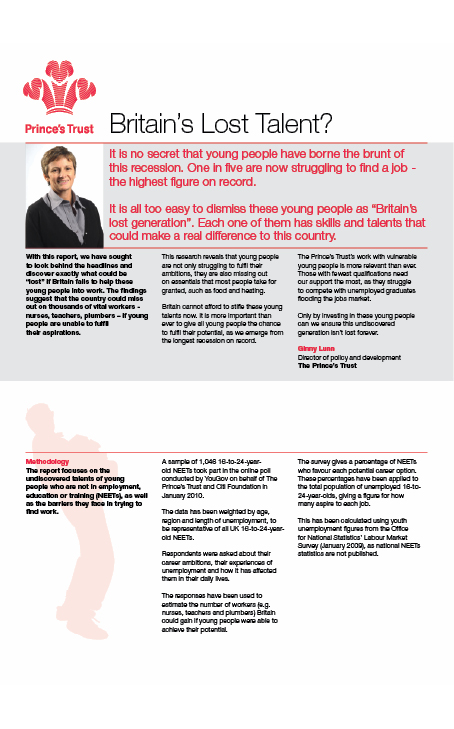
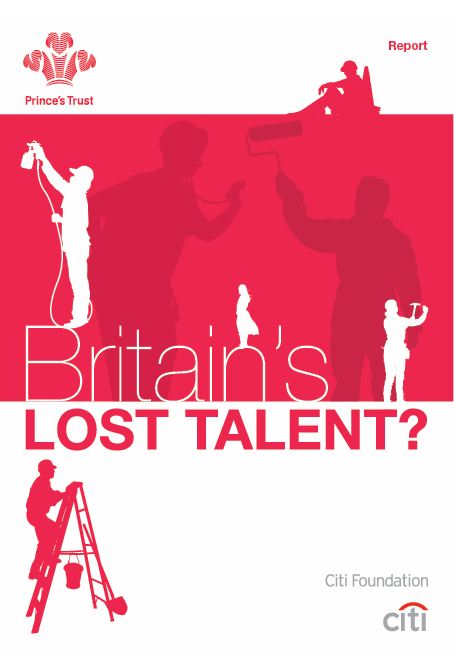
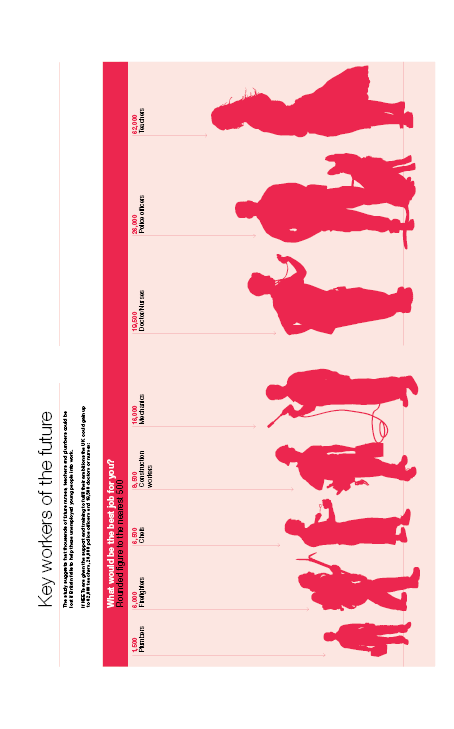

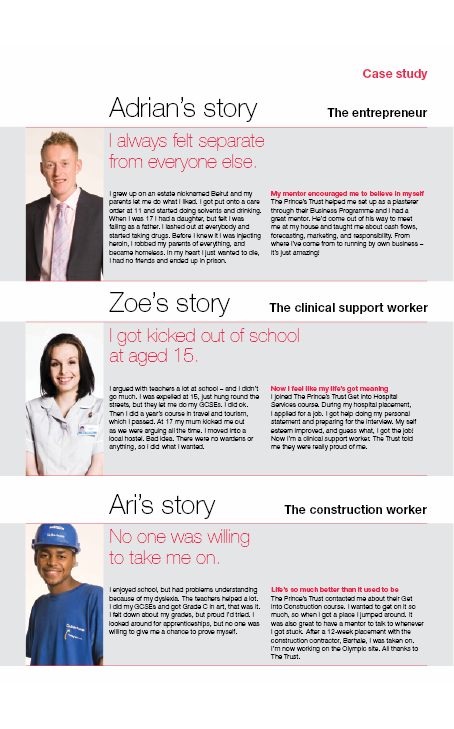

Prince's Trust



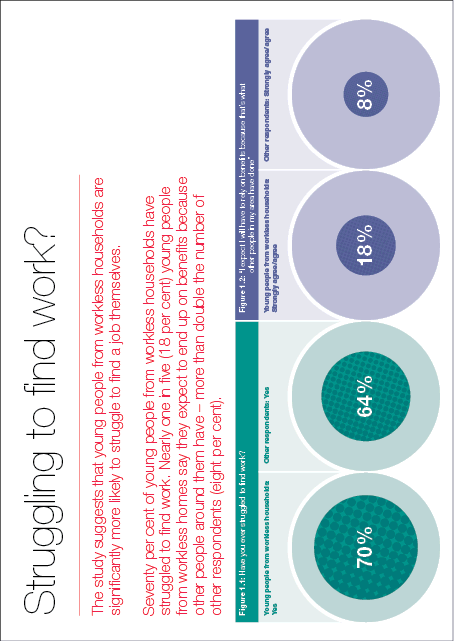

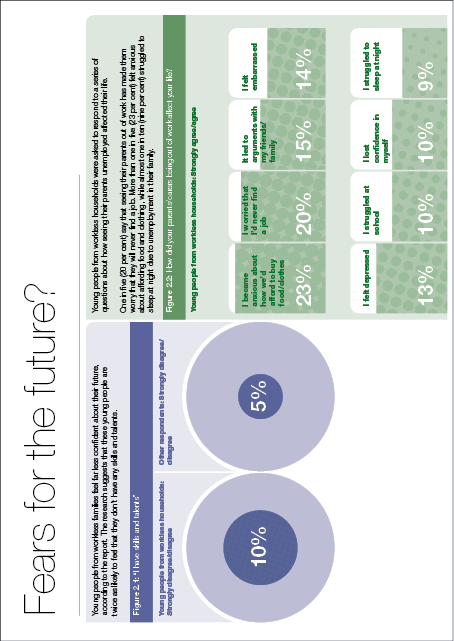
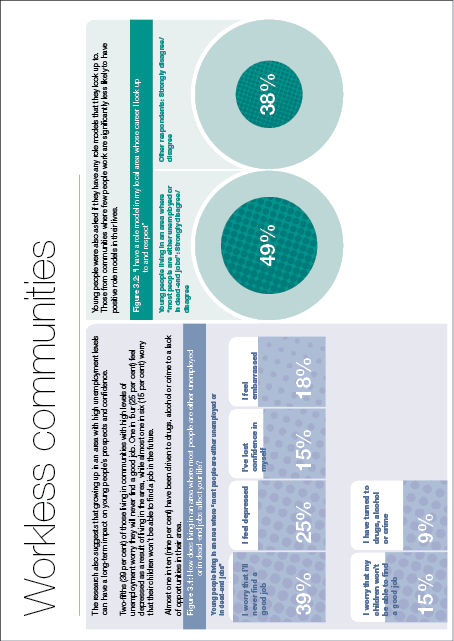


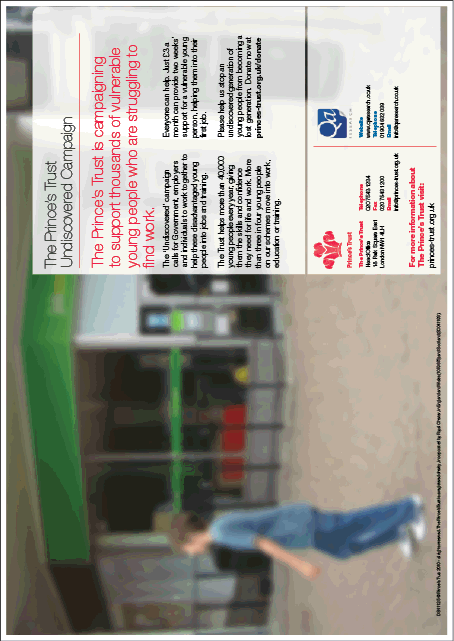
Prince's Trust
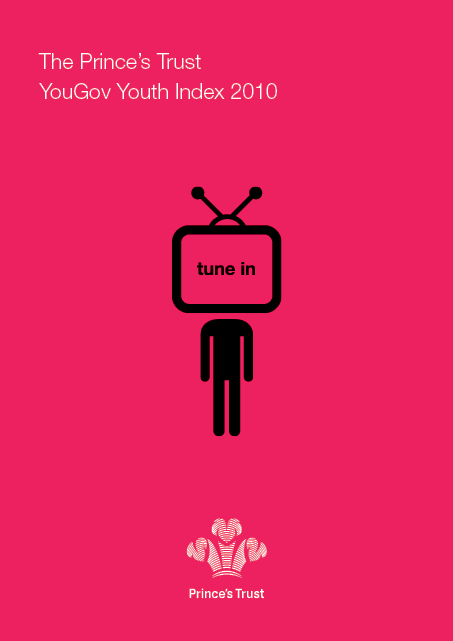
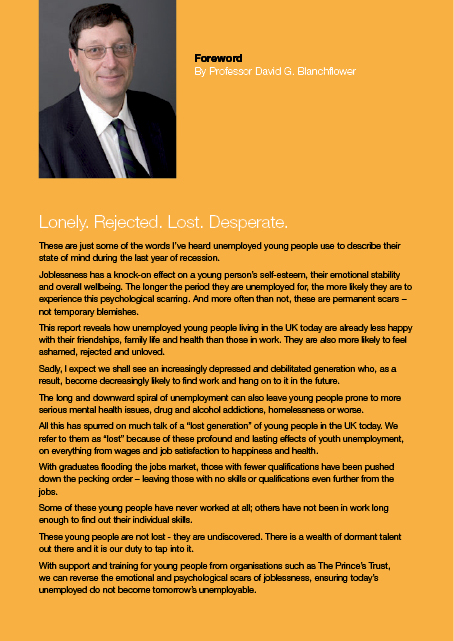
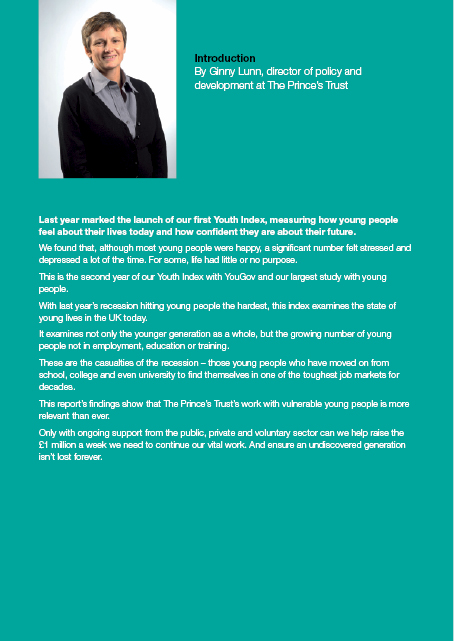
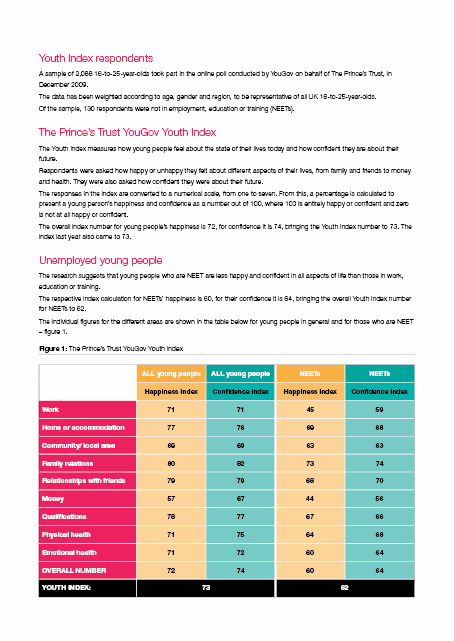
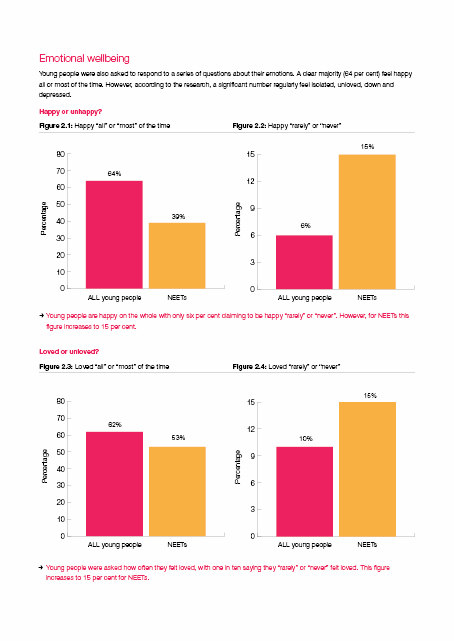
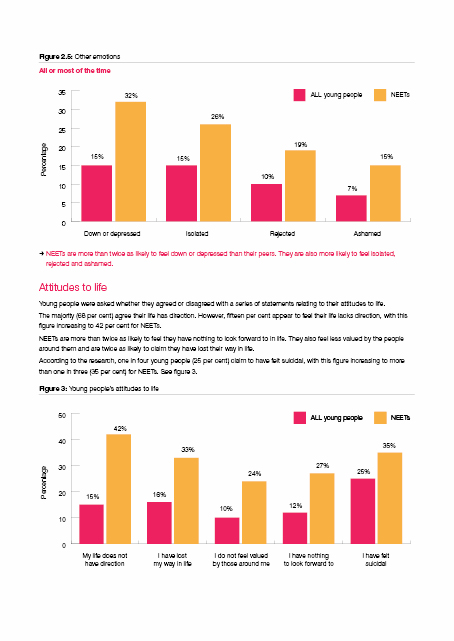
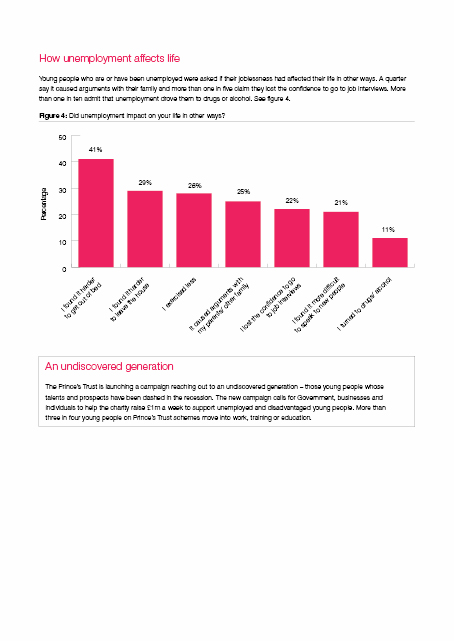
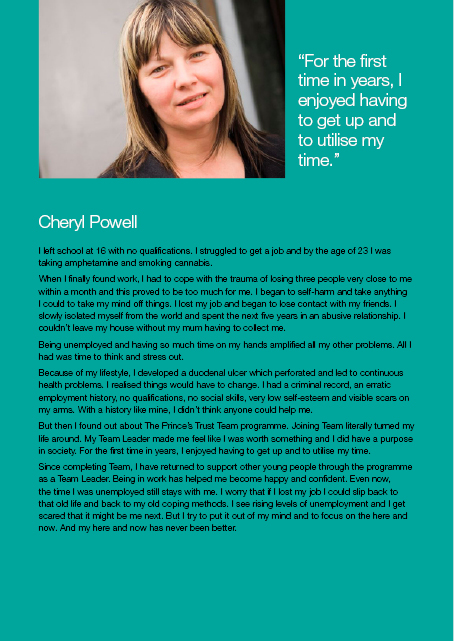


PriceWaterhouseCoopers
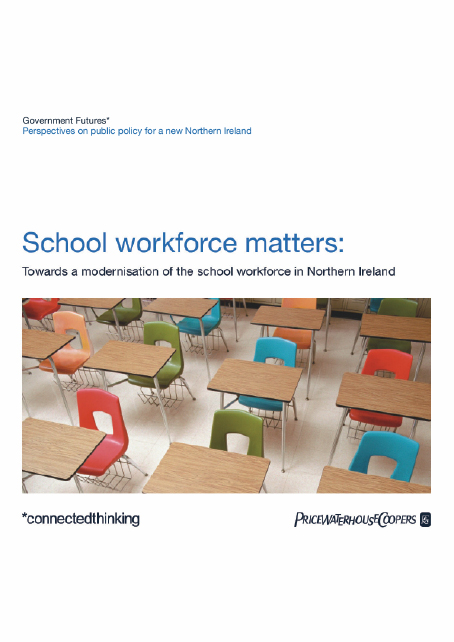


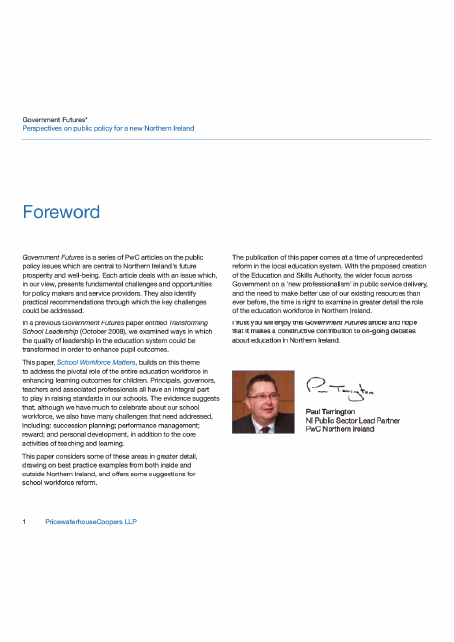




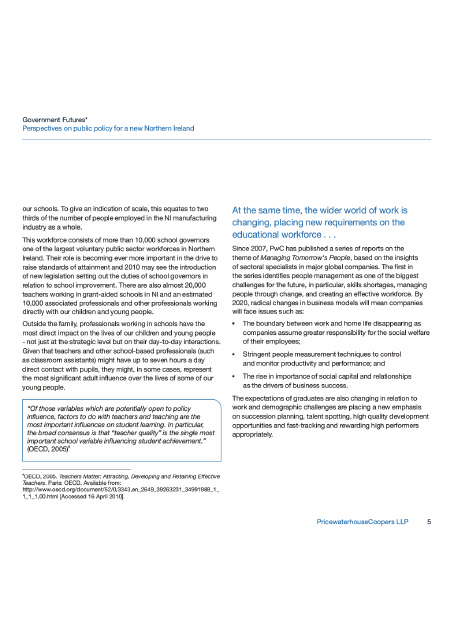


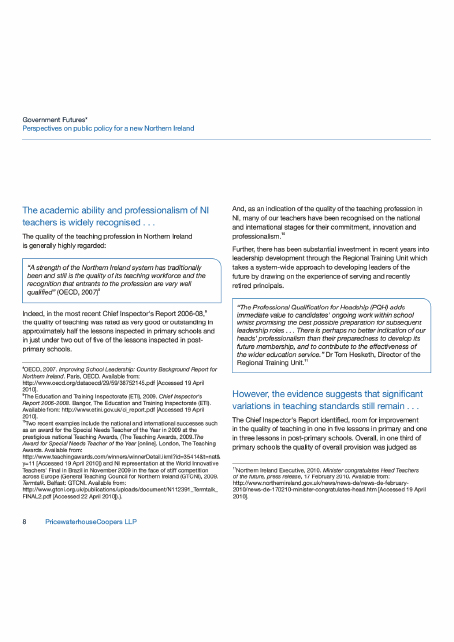

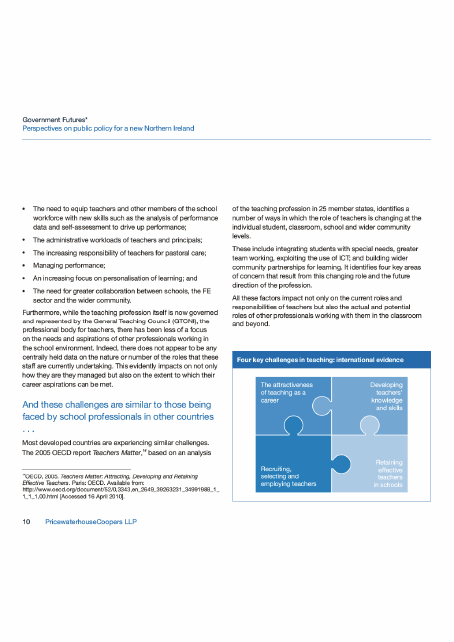
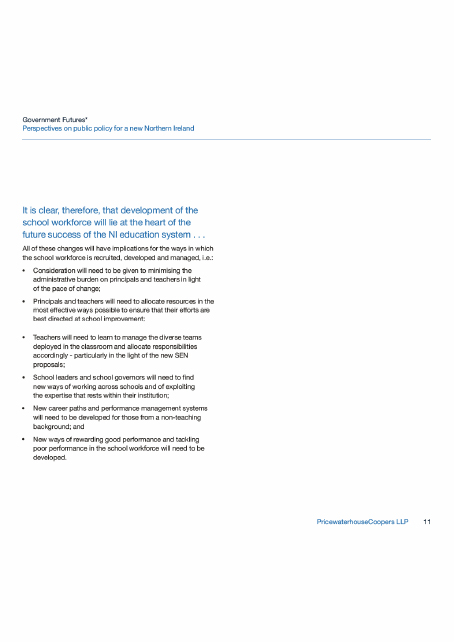

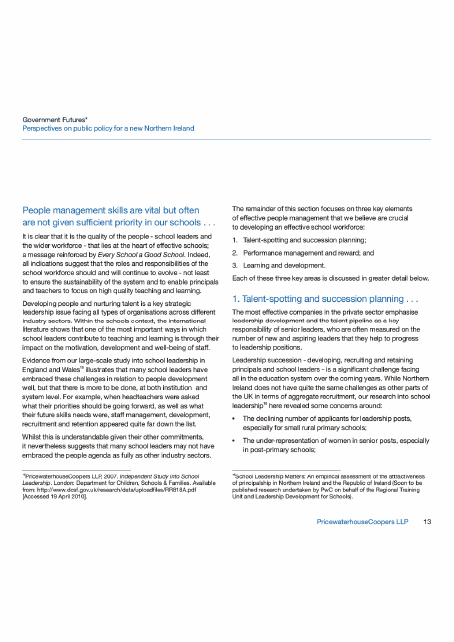
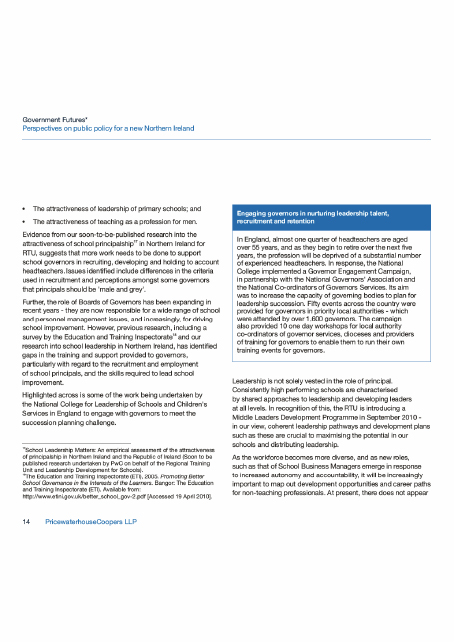
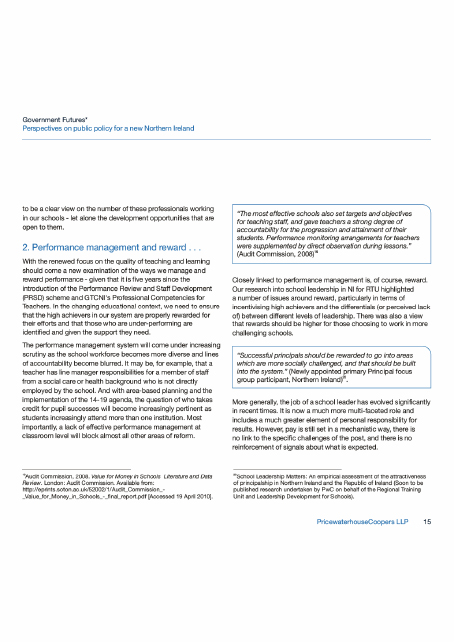

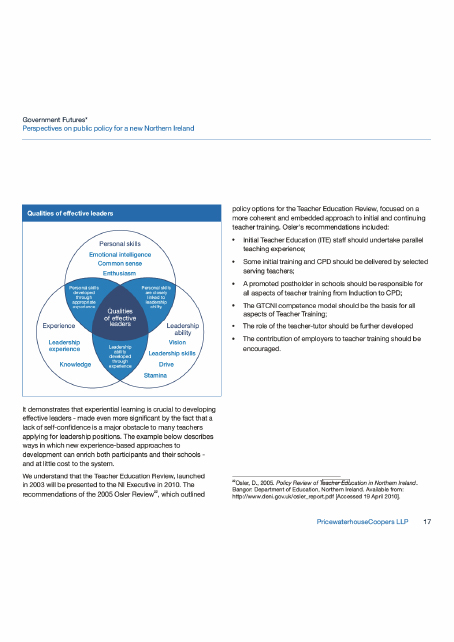


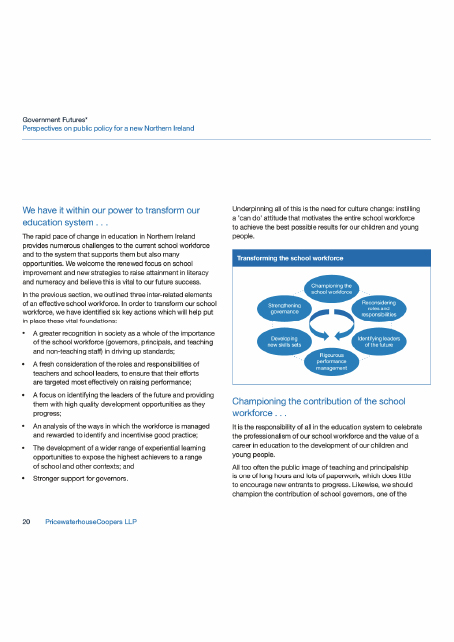

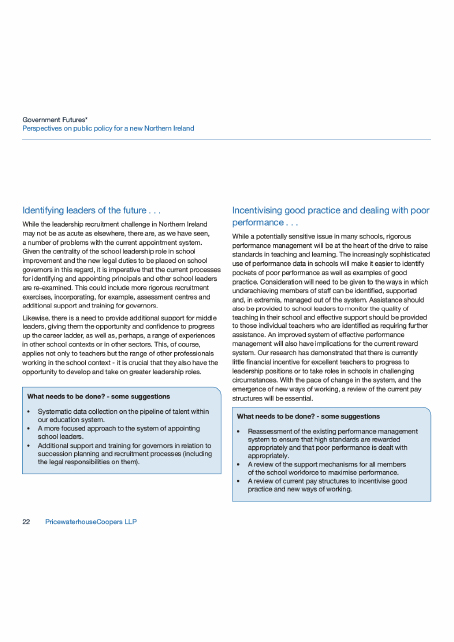




Department of Education






